
RICK HUDSON AND RICK HILLS FROM THE PRESIDENT’S DESK


RICK HUDSON AND RICK HILLS FROM THE PRESIDENT’S DESK
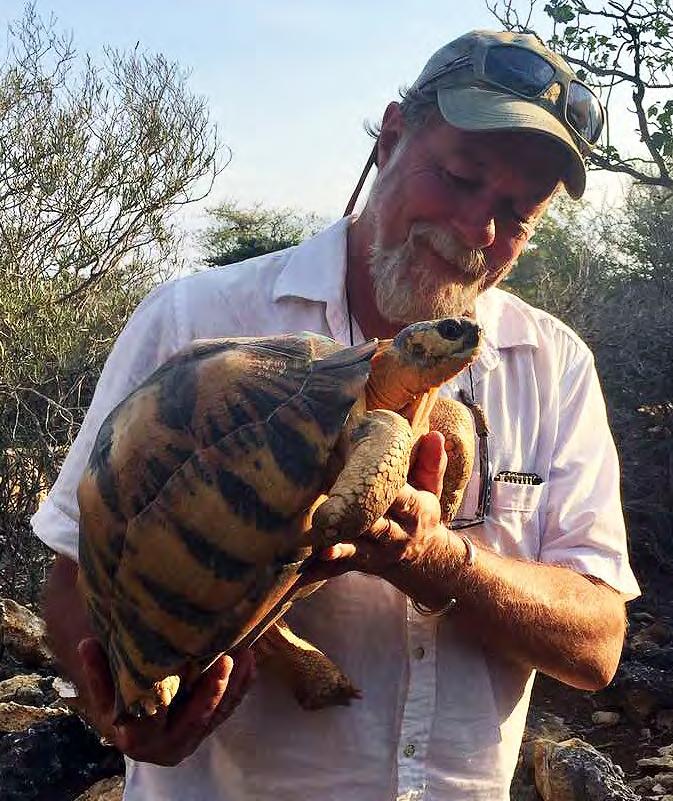
How many guys named “Rick H” does on organization need? For the TSA the answer is two. In August, Rick Hills took over as CEO/Executive Director, assuming management of the day-to-day operations of the TSA, with Rick Hudson staying on as President of the Board. Both Ricks are focused on fundraising. Hills has moved to Charleston, South Carolina, where he is overseeing both our three-person staff of Jan Holloway, Jordan Gray, and Emily Kiefner in our new office, opened in 2018, and our five-person staff at our Turtle Survival Center (TSC) in nearby Cross.
Hills is negotiating a steep learning curve, as he works to understand the complexities and the myriad of personalities that make up an organization global in scope. There are a lot of moving pieces within the TSA and many of us juggle many responsibilities

with a lot of balls in the air at any given time of day.
The transition to Charleston has been years in the making. Since we opened the TSC, we have been cognizant of the need to make ourselves better known in the greater Charleston community. We believe there is great fundraising potential in the Lowcountry of South Carolina. The TSC represents our greatest asset in terms of bringing what we do globally home to local people. One of Rick Hills’ most important goals is to guide that process and to ensure that the TSA name is as familiar to South Carolinians, indeed lay people everywhere, as it is to turtle conservationists and enthusiasts around the world.
The Lowcountry citizenry is environmentally aware. It appreciates the region’s natural beauty and its gorgeous coastline. Many
different volunteer groups are involved in nest watch and health monitoring activities for the different species of sea turtles of the region. The South Carolina Aquarium has a world-renowned facility that cares for injured sea turtles and the TSC is fortunate enough to get to share their amazing veterinary services. Our hope is to expand on the existing local sea turtles awareness by introducing people to the work done locally and globally at the TSC.
One of Hills’ happiest discoveries has been how receptive Lowcountry people are to the TSA and to the presence of the TSC. “I didn’t know that!” is a regular, pleasantly surprised reaction to a description of our work. The challenge ahead is to translate that receptiveness into support for the TSA’s programs, one Hills is excited to tackle head-on.
BOARD MEMBERS
Andre Daneault
William Dennler
Susie Ellis, PhD
Michael Fouraker
Tim Gregory, PhD
Brian Horne, PhD
Rick Hudson, President
John Iverson, PhD
Patricia Koval, LLD, Chair
Dwight Lawson, PhD, Vice-President
Kim Lovich
Lonnie McCaskill
John Mitchell
Russ Mittermeier
Hugh Quinn, PhD
Anders Rhodin, MD
Walter Sedgwick
Frank Slavens
EXECUTIVE DIRECTOR
Richard M. Hills
CHIEF OPERATING OFFICER
Andrew Walde
ADMINISTRATIVE STAFF
Jordan Gray
David Hedrick
Jan Holloway
Emily Kiefner
TURTLE SURVIVAL CENTER STAFF
Carol Alvarez, RMA, NCPT
Clinton Doak
John Greene
Cris Hagen
Nathan Haislip, MS
RANGE COUNTRY PROGRAM LEADERS
German Forero-Medina, PhD
Kalyar Platt, PhD
Herilala Randriamahazo, PhD
Shailendra Singh, PhD

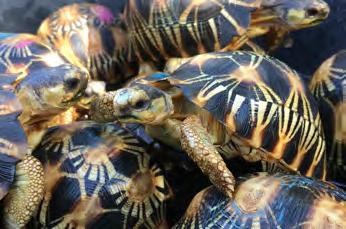
(Cover Story)
– Bangladesh (Batagur Baska Project)
– Myanmar
– Indonesia (Sumatra)
– Indonesia (Sulawesi)
– Vietnam (Rafetus swinhoei)
– China 49 – Belize
– Colombia 56 – Cambodia



– Behler Award
– Indianapolis Prize
– Member Spotlights
– Outreach 75 – Donor Recognition
3 – Partners 5 – TSA Partner News
– TSA Europe
– Brewery Partnerships
– theTurtleRoom
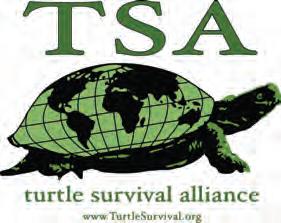
ABOUT THE COVER: The TSA and our partners were overwhelmed with Radiated Tortoise (Astrochelys radiata) confiscations in Madagascar in 2018, but we rose to the challenge. Massive rescue efforts presented all hands on deck response. By year’s end we had triaged and provided long-term care for nearly 18,000 of these iconic tortoises. As a result, new partnerships were formed, existing ones strengthened, and an enhanced facility brought to life in Lavavolo. Needless to say, the trajectory for this species’ wild survival in Madagascar presents a grim future. This species faces functional extinction in the wild in the next 20 years unless the all-out assault on the tortoise and its habitat is stopped. To save this species from becoming the next on a long list of those that have disappeared from their native land, a full-scale, multi-national conservation initiative must be taken on their behalf. The time is now. See full story pp.19 PHOTO CREDIT: MARK LEWANDOWSKI
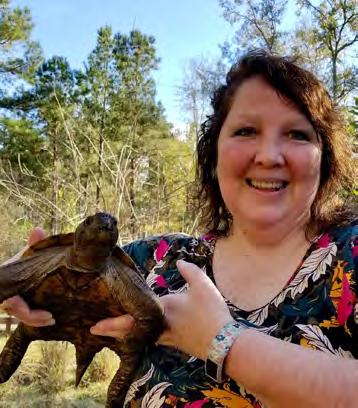
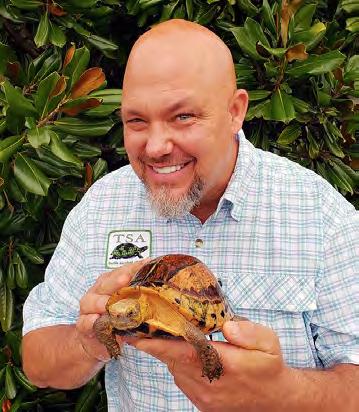

Jan Holloway is originally from Pulaski, a small town in upstate New York near Lake Ontario, and has been a lover of all animals since a very young age. Her true passion was horses though, which led her to earning her AAS in Equine Studies from Cazenovia College, NY before continuing her education, earning her BA in English, Creative Writing. After graduating in 1988, she moved to South Carolina to take a position as the Breeding Manager at a large Saddlebred horse farm outside of Columbia, SC. She later explored other career fields including Sales/Marketing and Print Media and Publishing. Most recently, before accepting her position as Administrative Coordinator at the Turtle Survival Alliance in December 2017, she was the Activity Coordinator at another local non-profit agency for nearly five years. She has always been a reptile enthusiast, and bearded dragons, aquatic turtles, and non-venomous snakes have been among her most recent pets. Jan also currently serves as Secretary.
Another Upstate New York native, John joined the TSA in March 2018 as our newest Chelonian Keeper. Beginning with turtles found in ponds near his house at the age of 5, John has held a lifelong fascination with chelonians. This fascination led to honing his skills in turtle husbandry, to which he has dedicated the last 43 years of his life. Prior to his employment by the TSA however, chelonian keeping and their conservation was a hobby. After attending Florida State University, John moved to Southern California where he entered the professional construction sector. The trade skills acquired in this sector significantly add to our ability to expand the Turtle Survival Center’s infrastructure and animal care apparatuses and mechanisms. While John has a strong interest in all genera of chelonians, the Asian box turtles of the genus Cuora are his favorite, with a particular interest in the Southern Vietnam Box Turtle (Cuora picturata).
Emily Joined the TSA in September 2018 as Administrative Assistant. No stranger to the South Carolina Lowcountry, Emily has lived Charleston for the last ten years where she has worked as a Program and Administrative Assistant and Office Manager for various establishments. Prior to relocating to the Lowcountry, she lived in numerous states and countries abroad, including England and Germany. A graduate of Dickinson College in Pennsylvania with a dual-degree in International Business and Management, and German Studies, she later obtained her Paralegal Degree here in Charleston. When she is not working toward our commitment of “zero turtle extinctions,” Emily loves to travel, play tennis, and ride horses. Her diverse background and work experience has enabled her to quickly fill her role at the TSA.
The Turtle Survival Alliance is proud to acknowledge the following organizations that make our work possible. The organizations listed here provide a range of services supporting our mission, including guidance, networking, strategic planning, funding, husbandry, rescue, animal management, marketing and public relations, field research, logistical and technical support, salaried positions, and other resources.

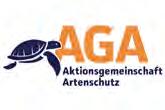
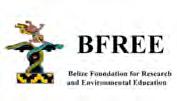

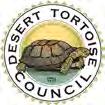
















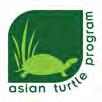









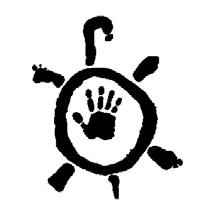








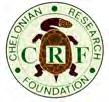


















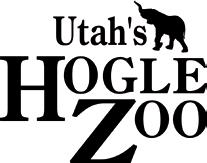




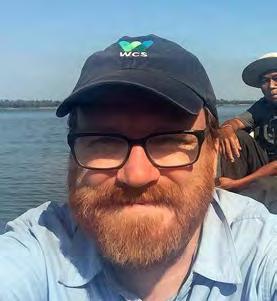
This year the TSA welcomed Brian D. Horne, PhD, to our Board of Directors while bidding farewell to Colin Poole and Jim Breheny, all of whom represent the Wildlife Conservation Society. Both Colin and Jim have been strong supporters of the TSA since its inception, and we thank them for their years of service toward our mission. Likewise, Brian has also been heavily involved with the TSA since its early days, serving as an active member of TSA’s leadership committees for many years. With a focus on the turtles of Southeast Asia, Brian brings a wealth of knowledge regarding their status and conservation and will greatly bolster our influence in the region.
Brian has held a life-long love for reptiles. It all began with his first pet snake at the age of 4, and he has provided care for “herps” ever since. In pursuing his interest in herpetology, Brian attended Virginia Tech, where undergraduate mentor, Dr. Robin Andrews, encouraged him to explore reptile natural history. Later in his undergraduate career, he would become a student researcher under Dr. Carola Haas, performing field work with Bog Turtles (Glyptemys muhlenbergii) in southwestern Virginia.
Following undergrad, Brian earned his Master of Science, studying nesting behavior of the Yellow-blotched Map Turtle (Graptemys flavimaculata), under Dr. Richard A. Seigel. Continuing his advanced education, Brian joined Dr. Willem Roosenburg’s lab at Ohio University in pursuit of a PhD and, at the encouragement of Dr. Richard Vogt, studied the White-lipped Mud Turtles (Kinosternon leucostomum) of southern Mexico, creating a predictive model for embryonic diapause in this species. Upon completing his dissertation, Brian accepted a postdoc position at the San Diego Zoo’s Institute for Conservation Research, where his focus centered on developing a conservation program for the Red-crowned Roofed Turtle (Batagur kachuga) in India. This work would become the genesis of the TSA’s India program.
Currently, Brian is the Coordinator of Freshwater Turtle and Tortoise Conservation at the Wildlife Conservation Society (WCS) where he oversees programs across the globe, with a notable emphasis in Southeast Asia and Latin America. In this role, Brian continues to integrate field research and animal husbandry to advance the conservation of the world’s most endangered chelonians, with the ultimate goal of restoring species to their full ecological function across their former range. He sees the key to success lying in a better understanding of reintroduction biology, and working with countries to protect their species from habitat loss and illicit trade.
“Zero turtle extinctions in the 21st century” – a bold pledge by an emboldened group of chelonian conservationists. The Turtle Survival Alliance (TSA) is in its 17th year of this commitment to the tortoise and freshwater turtle species of the six continents on which they reside. Created in 2001 in response to “The Asian Turtle Crisis,” the title given to the rampant and unsustainable harvest of Asian turtles, the TSA has since expanded to create a global chelonian conservation network.
During its first four years, the TSA operated as a task force for the IUCN’s (World Conservation Union) Tortoise and Freshwater Turtle Specialist Group (TFTSG). In 2005, the TSA sought an independent 501(c)
(3) nonprofit status, with a home base at the Fort Worth Zoo, Texas. As the TSA’s global reach grew, so did its need for restructuring, and a Board of Directors was instituted in 2009. With this growth also came the need for the construction of a facility to house and provide assurance colonies for some of the world’s most endangered species of chelonians. Thus, the Turtle Survival Center, now home to 700 specimens, was created in the backwoods of coastal South Carolina.
The Turtle Survival Alliance continues to be a global force in the effort to provide dynamic in situ and ex situ conservation initiatives including breeding programs, assurance colonies, and management plans; field research and culturally sensitive
conservation initiatives; hands on, readable, and viewable public outreach; and sharing information, techniques, and communication throughout the chelonian conservation community. Through working collaborations with zoos, aquariums, universities, private turtle enthusiasts, veterinarians, government agencies, and conservation organizations, the TSA is widely recognized as a catalyst for turtle conservation, with a reputation for swift and decisive action.
As anthropogenic threats such as habitat loss, poaching, and pollution continue to wreak havoc on turtle and tortoise populations worldwide, the TSA is committed, now more than ever, to fight for the preservation of these animals.
Anders G.J. Rhodin1,2, Hugh R. Quinn1, Russell A. Mittermeier1,2, Nicolas
Last year, the Turtle Conservation Fund (TCF) and the Mohamed bin Zayed Species Conservation Fund (MBZ) each marked significant milestones in reaching the one-million-dollar mark for dedicated turtle and tortoise conservation funding. Both funds have continued their loyalty to turtle and tortoise conservation support over the past year. One of the recent projects supported by both funds has now had some very welcome results: the rediscovery of a nearly extinct species, the Nubian Flapshell Turtle (Cyclanorbis elegans), along the White Nile in South Sudan.
This large softshell species has been assessed by the IUCN Tortoise and Freshwater Turtle Specialist Group to be one of the most critically endangered turtles in the world, literally teetering on the brink of extinction. There have been no sightings of any animals in the wild for several decades, and the only known captive died in a private U.S. collection in 2012. The historic distribution of the species was in the SubSaharan Sahel region, in a series of apparently disjunct populations extending from Ghana to South Sudan, but with no current evidence of persistence in most of its range. Several focused field surveys over the years by Luca Luiselli and associates in Togo, Ghana, and Nigeria, and supported by TCF and MBZ, as well as others, have provided only negative results—no Nubian Flapshell Turtles were discovered.
Raising hopes of rediscovery, support from TCF to Patrick Baker in 2014 resulted in preliminary interview reports of the possible continued presence of C. elegans in South Sudan, however, no animals were found (though descriptions by local fishermen were quite precise). Further support to pursue these
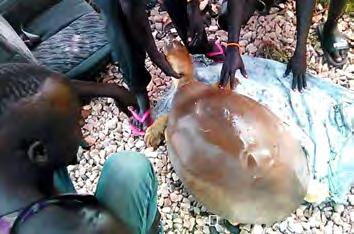
preliminary reports, as well as to collect data on the distribution and abundance of other turtle species in South Sudan, was provided to Luiselli and colleagues Gift Simon Demaya and Tomas Diagne by both TCF and MBZ again in 2017. The local South Sudan team also included John Sebit Benansio and Thomas Francis Lado from the University of Juba.
Field work by this team in South Sudan has now confirmed the continued survival of a small population of C. elegans in the White Nile (and records of 9 other turtle and tortoise species). The hopeful news of rediscovery of this nearly extinct species must be tempered by the fact that this remnant population is under severe threat from local exploitation and consumption as well as habitat loss. Continued exploitation of this population is sure to continue unless new protective measures are initiated.
The creation of a novel protected area for the section of the White Nile in which they inhabit is being considered in conjunction with the Government of South Sudan and with the support of Rainforest Trust. Furthermore, Luiselli is pursuing additional survey work to establish size and density of the population and to document habitat
preferences. Establishing a captive breeding program in South Sudan and perhaps elsewhere also needs to be considered.
The TCF was founded in 2002 by the IUCN Tortoise and Freshwater Turtle Specialist Group, Turtle Survival Alliance, and Conservation International. Through August 2018 it has provided funding for 250 projects focused on turtles and tortoises, at an average of $4,352 per project, for a total disbursement of $1,088,000.
The MBZ was founded in 2008 by His Highness Sheikh Mohamed bin Zayed Al Nahyan, Crown Prince of Abu Dhabi, and through September 2018 has provided a total of about $17.5 million in grants to 1800+ projects. Of these, 111 projects have focused on turtles and tortoises, at an average of $9,910 per project, for a total turtle disbursement of $1,100,000.
Both TCF and MBZ greatly value the support of the turtle conservation community in our efforts and we are honored and pleased to be able to provide as much support as we do for so many of the critically important front-line and on-the-ground efforts on behalf of global turtle conservation. By continuing to expand and grow our capacity for providing support, we hope to make an increasingly important impact on all turtle conservation efforts. Please consider submitting your grant proposals to us for consideration at www.turtleconservationfund.org and www.speciesconservation.org.
Acknowledgements: 1Turtle Conservation Fund; 2Mohamed bin Zayed Species Conservation Fund
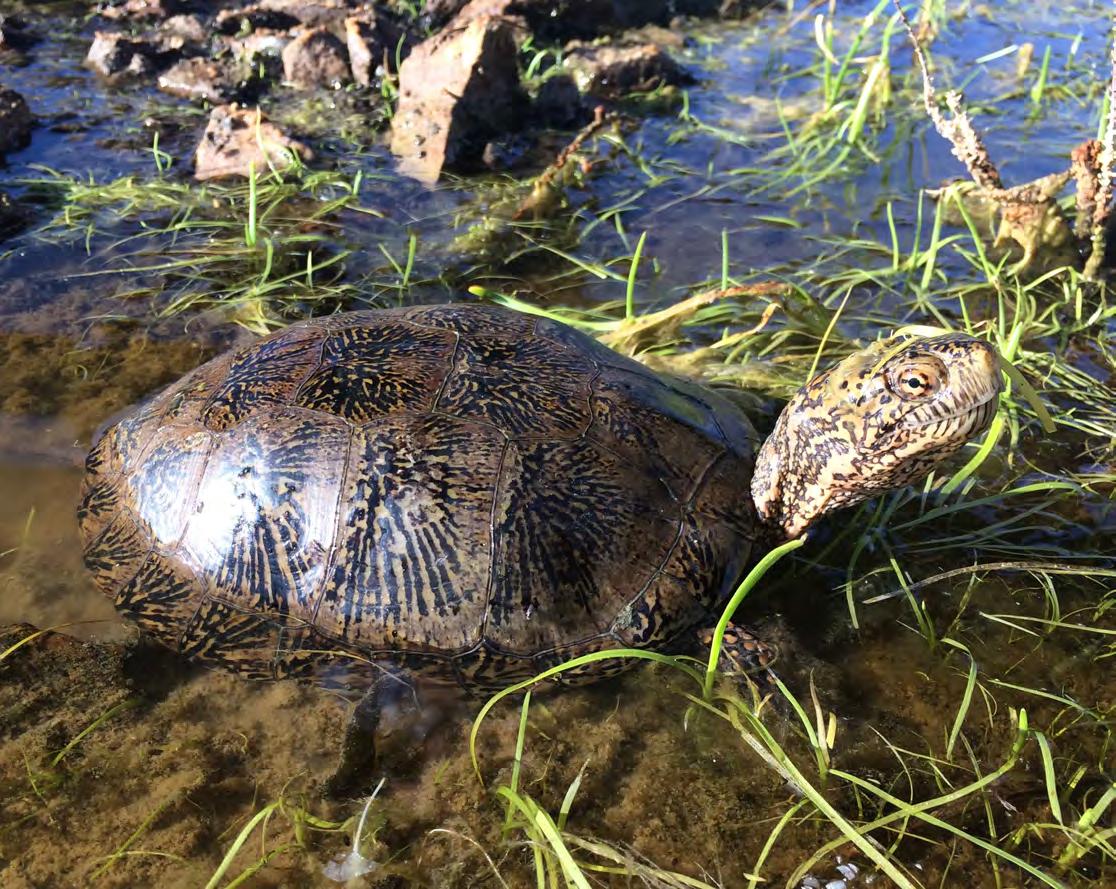
Jeffrey E. Lovich, Joshua R. Ennen, Mickey Agha, and J. Whitfield Gibbons
Throughout our careers, now spanning more than 100 cumulative years, people consistently ask us the same questions when they find out we are conducting research on turtles: 1) why do you study turtles, and 2) why are turtles important? It is often easiest to put on our “scientist hats” and tell them that doing so provides important information to resource managers to recover or
better conserve turtle populations. If that doesn’t satisfy them, we sometimes turn to a long list of turtle superlatives including statements like, turtles are in a lineage that is over 200 million years old, they survived the extinction of the dinosaurs, many species have embryonic sex determined by incubation temperature, females can store viable sperm for years, or other captivating
facts about turtles. Some people walk away satisfied while others remain mystified by our fascination with turtles.
There are certainly other reasons why people study or conserve turtles. Some simply like turtles, perhaps because of a memorable childhood experience with these marvelous creatures. Others study turtles to learn how to better conserve them since
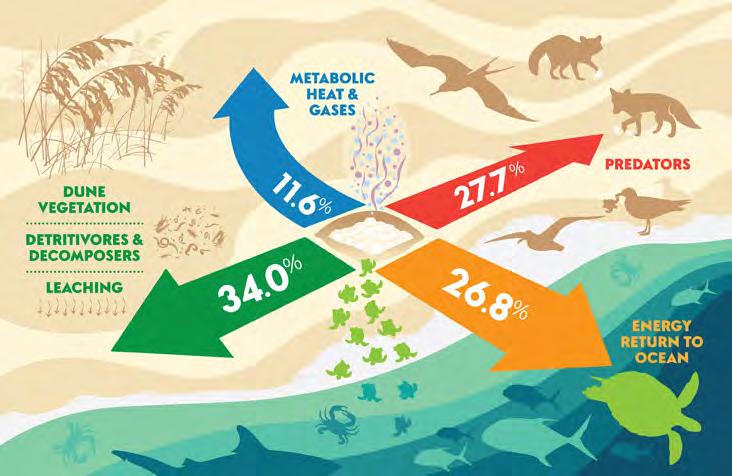
almost 60% of the world’s 357 turtle species are threatened or have become extinct since the year 1500. Moral, esthetic, or legal arguments are additional rationales given by some for protecting turtles. Turtles are remarkable and beautiful animals, and some are protected as threatened or endangered species under penalty of law. In addition, turtles have value to humans culturally, as a food resource, via tourism value (e.g., Galápagos Islands), and increasingly as pets. In a recent article (Lovich, J.E., J.R. Ennen, M. Agha, and J.W. Gibbons. 2018. Where have all the turtles gone, and why does it matter? BioScience.), we provide a new paradigm by assessing the ecological value of turtles.
Ecological value can be defined as the worth attributed to a plant or animal in terms of their benefits to the environment. Think of the ecological value of trees to us as an example. By maintaining healthy forests, we get access to economically important products like wood and paper. Turtles also have value to the ecosystems they occupy, including to humans who share those same environments in many cases. In our BioScience article, we bring attention to the global plight of turtles and identify what we will lose from an ecological
perspective as populations continue to decline and species disappear.
Before humans caused widespread declines of turtle populations, due primarily to overharvest and habitat destruction, turtles often occurred in very large numbers and had high biomass in the various ecosystems they occupied. As a result, they made valuable contributions to soil processes, mineral, nutrient and energy cycling, scavenging of carrion, and seed dispersal and germination enhancement of various plants. For example, many turtles propagate plants across the landscape by eating and defecating seeds that remain viable after passing through their digestive tracts. Aquatic turtles transport seeds of plants such as water lilies. Box turtles and tortoises disperse the seeds of numerous terrestrial plants. In addition, some tortoises dig burrows that turn over the soil, making minerals and nutrients available to other animals and plants. In addition, those same burrows provide shelter for hundreds of other commensal species, many of which cannot dig burrows by themselves. Other turtles are important scavengers that keep waterways cleaned of dead aquatic organisms including fish. Turtles
are even being used to restore degraded ecosystems in places like the Galápagos Islands where their numbers were greatly reduced over time. As turtle populations continue to decline worldwide, these known ecological roles are greatly diminished with incompletely-known consequences for ecosystem health and the survival of other species, especially those that have commensal relationships with turtles.
A fundamental question is, why is public awareness of declining turtle populations and the importance of healthy turtle populations lagging relative to other charismatic species? There are three possible explanations. First, reptiles are generally not as well-liked as mammals and birds by the public. However, turtles are the only reptiles that are generally admired and even elevated as cultural icons (e.g., the fable of The Tortoise and the Hare, Teenage Mutant Ninja Turtles). Second, shifting baselines obscure what has been lost in the past. People born into a world with few turtles accept that as a new norm. Third, is what we call the “perception of persistence.” Since many turtle species can live a long time, populations that are not reproductively viable can consist of surviving adults that persist for decades before they too eventually die, with no recruitment of juveniles for the future.
Many turtle populations continue to slide toward extinction around the world and the ecological consequences are still not fully understood. It would be a sad world indeed without turtles, the only animals that ever lived with their shoulders and hips inside the rib cage. They are arguably nature’s greatest success story, having outlived the dinosaurs by a wide margin. Will they outlive us?
Contact: Jeffrey Lovich, U.S. Geological Survey, Southwest Biological Science Center, 2255 N. Gemini Drive, MS-9394, Flagstaff, AZ 86001-1600, USA; [ jeffrey_ lovich@usgs.gov]
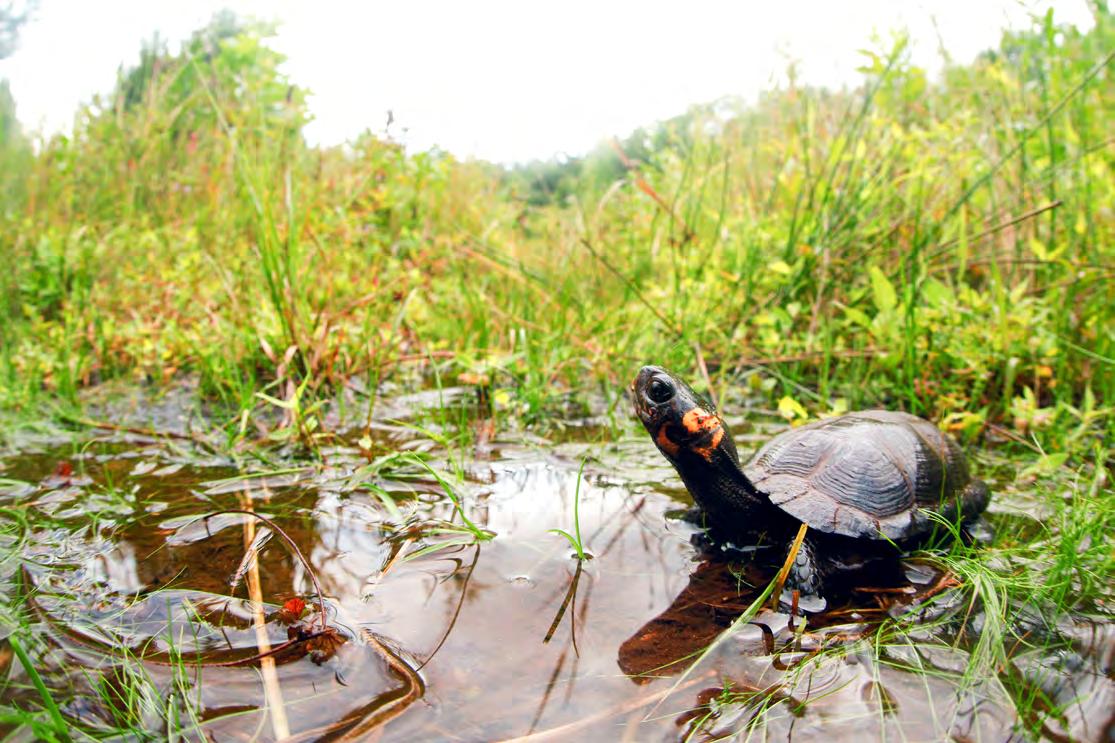
Bog Turtles (Glyptemys muhlenbergii) in the disjunct southern portion of their range exist in idyllic mountain fens, seeps, and wet meadows. Since the arrival of Europeans, approximately 90% of these rare habitats have been destroyed. Despite this significant habitat loss, the southern population network has historically been considered a stronghold for Bog Turtles. The viability of the populations that make up this network is likely critical to long-term survival of the species.
Unfortunately, the demographic characteristics of our most intensively studied sites
Mike Knoerr and Dr. Cassie Dresser
in North Carolina (NC) and Tennessee (TN) suggest population-level declines. For example, annual adult survival for these NC populations is low (0.86 – 0.94, Tutterow et al. 2017) when compared to northern Bog Turtle populations and other turtle species. Egg and juvenile survival can be low as well given field observations and skewed age class distributions. These populations are often dominated by old turtles with few/ no juveniles observed in recent decades. Although an aging demographic is characteristic of most sites, high egg survival (>50% annually) and a high proportion of juveniles
(>40% of encounters) have been observed in two stable NC populations. Analysis suggests that high survival at the beginning stages of life contributes to the stability and growth of these populations.
Although we have made strides in understanding drivers of decline, the mechanism(s) behind these demographic trends are not fully understood. At Bern Tryon’s TN site, where the entire known population is comprised of captive-bred, head started, and wild raised adult turtles, wild recruitment has not been observed, despite nearly 30 years of trans-
location efforts. At some of the “aging” NC sites, catastrophic nest predation, particularly by human-subsidized mesopredators, has been documented in recent years. Based on current trends, some NC populations may be experiencing 6-10% annual decline and the TN population may face extinction without continued stocking efforts. While vital rates certainly fluctuate in any given year, multiple decades of encounter data suggest that it is improbable for these declining populations to stabilize on their own.
With a handful of questions and objectives in mind (and support by the TSA’s Bern Tryon Grant), we (Dr. Cassie Dresser at Michigan State and Mike Knoerr in Clemson University’s Barrett Lab) joined forces to better understand drivers of recruitment failure and to implement applied management. Cassie spent the summer working in Bern Tryon’s TN site, the same site where she had spent years studying the population as part of her PhD dissertation. Accompanied by her undergraduate research assistant, Sarah Klein, and supported by Zoo Knoxville staff, they set out to find and track gravid turtles in order to locate their nests. To assess drivers of nest fate, a subset of nests was protected with predator excluder cages, while others were left undisturbed. Furthermore, nests were monitored using wildlife cameras to identify potential nest predators and inform future predator management. Mike and his technician Cody Davis spent most of their season working with two “aging” populations in NC (with additional support from the North Carolina Wildlife Resources Commission, United States Fish and Wildlife Service, and NC-The Nature Conservancy). Their goal was to assess the effectiveness of in situ recruitment augmentation and habitat restoration at increasing survival and populationlevel stability. This field work included: caging nests with excluders, building solar-powered electric fences around core nesting areas, mesopredator trapping, and
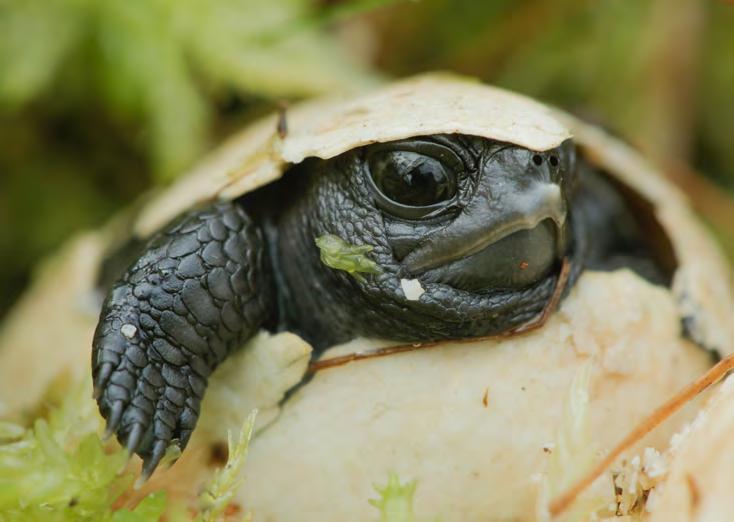
hydrological/vegetative restoration.
Preliminary observations at Bern Tryon’s TN site differ from those made in NC. While most female turtles of adequate size and health in NC become gravid annually (>90%), <50% of the females monitored at Bern’s site became gravid in 2018, a trend observed across multiple field seasons. Why comparatively fewer females produce eggs here has yet to be determined. As of this writing, four eggs from the five nests monitored have hatched. The remaining eggs have either not yet hatched or appear infertile. We anticipate that these data and the questions they generate will help us better assess whether Bern’s population has the capacity to become self-sustaining long term.
In NC, 27 nests were found across three sites. Results from the management efforts look promising as predation, the primary driver of failure in 2016/2017, was reduced to nearly zero. Photos and video suggest that the electric fences and nest cages were effective at excluding a multitude of predators. Gravid turtles successfully nested in areas cleared of woody vegetation. Egg survival was fairly high (64%)
with 65 hatchlings having been marked and released. This is likely the largest cohort of hatchlings to survive in decades. Many of these hatchlings have since been observed active in newly inundated areas created via hydrological restoration efforts.
Bog Turtles offer a unique challenge to those dedicated to saving them. While facing the acute problems inherent in avoiding extirpation, we have arrived at a place where we must consider pragmatic and imperfect solutions. In best case scenarios, research and management efforts like these implemented in TN and NC may help stabilize populations. In precipitously declining populations, they may be only stop-gap measures that boost turtle numbers and buy us more time. Regardless, we have more turtles today than we did earlier this spring. That is a start.
Contact: Mike Knoerr, Clemson University, School of Agriculture, Forest, and Environmental Sciences, 244 Lehotsky Hall, Clemson, SC 29634 [mike.knoerr@ gmail.com]; Cassie Dresser, Michigan State University, Lyman Briggs College, 919 E Shaw Ln, East Lansing, MI 48825 [cdbriggs@msu.edu]
Cris Hagen, Nathan Haislip, Carol Alvarez, Clinton Doak, and John Greene
The Turtle Survival Center (TSC) had its best year yet for egg production. Over 400 eggs from 21 species were laid in 2018. Eggs were divided between three different incubators at temperatures of 78° F (25.5° C), 82° F (27.7° C), and 85° F (29.4° C) for different temperature sex determination among the species. This was the first year that the TSC successfully hatched the Sulawesi Forest Turtle (Leucocephalon yuwonoi) and the Asian Black Giant Tortoise (Manouria emys phayrei). Other species that reproduced at the TSC this year include Yellowheaded Box Turtles (Cuora aurocapitata), Chinese Box Turtles (Cuora flavomarginata), Indochinese Box Turtles (Cuora galbinifrons), McCord’s Box Turtles (Cuora mccordi), Southern Vietnam Box Turtles (Cuora picturata), Ryukyu Black-breasted Leaf Turtles (Geoemyda japonica), Spiny Hill Turtles (Heosemys spinosa), Sulawesi Tortoises (Indotestudo forstenii), Vietnamese Pond Turtles (Mauremys annamensis), Red-necked Pond Turtles (Mauremys nigricans), and Beale’s Eyed Turtles (Sacalia bealei). For the fourth year in a row, Big-headed Turtles (Platysternon megacephalum) have reproduced at the TSC, for a grand total of 30 offspring. Outside of the TSC, Zhou’s Box Turtle (Cuora zhoui) reproduced in the U.S. for the first time since 2015. The two C. zhoui hatchlings are the first offspring produced from a male imported from the Munster Zoo in Germany last year as part of an international bloodline exchange.
Contact: Cris Hagen, Turtle Survival Alliance, 1030 Jenkins Road, Suite D, Charleston, SC 29407, USA [chagen@turtlesurvival.org]
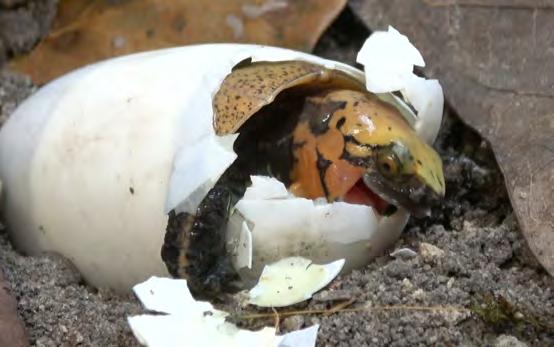
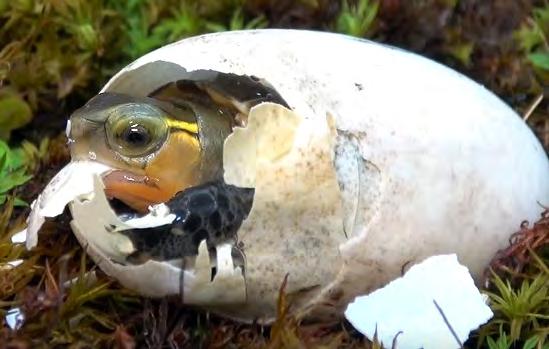
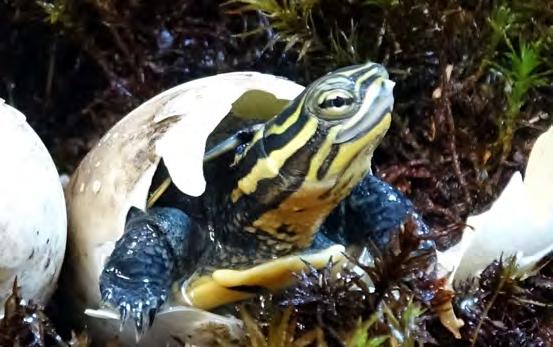
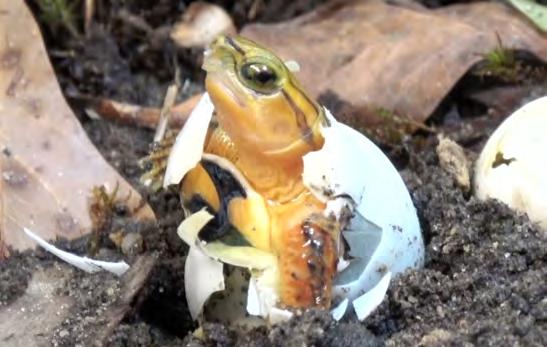
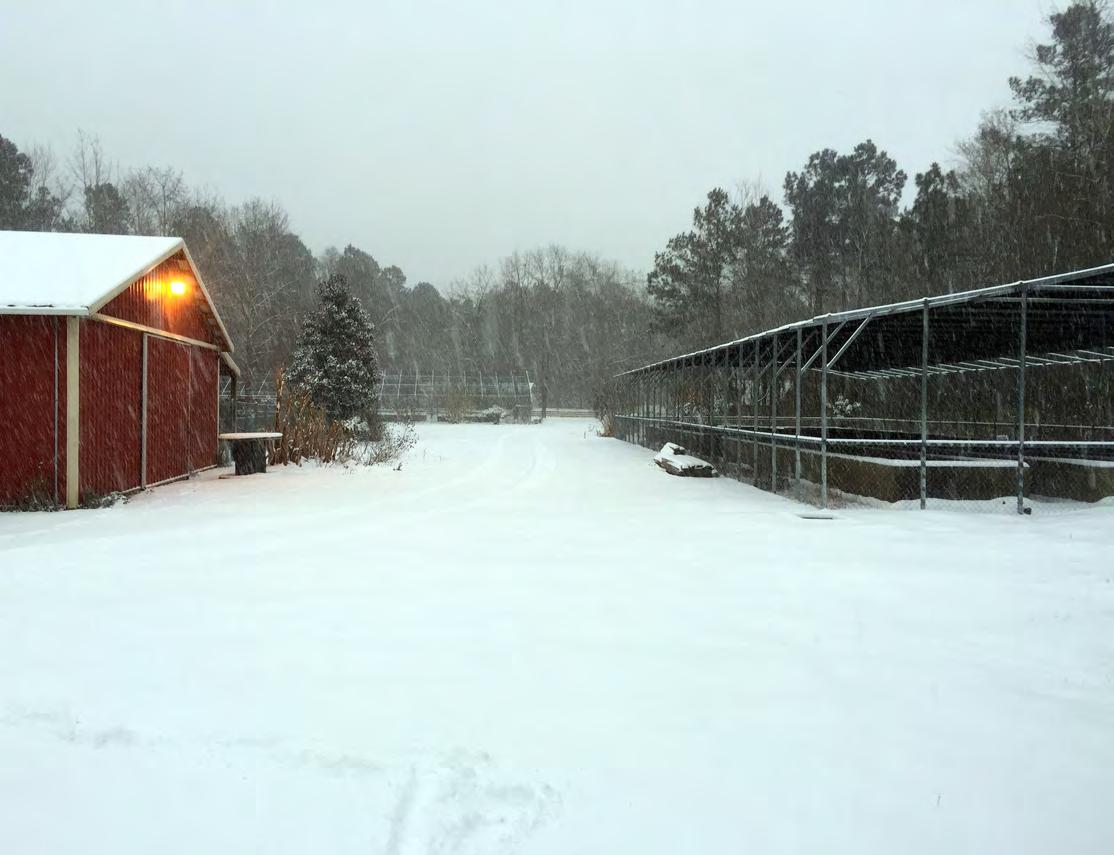
During the first week of 2018 an extremely rare weather event occurred in Charleston, SC blanketing the region with 5-6 inches of snow for nearly a week before it all melted. The outdoor residents at the Turtle Survival Center remained dormant either underwater in ponds or under piles of mulch and leaves on land during this winter anomaly. PHOTO CREDIT: CRIS HAGEN
This year marks the 5-year anniversary of the Turtle Survival Center (TSC). Thinking back to its humble beginnings and the 2013 TSC article in the TSA magazine, it’s been amazing to witness the growth and transformation that has taken place. The TSC started with a staff of one, quickly growing to four during the first few months of operation, and currently maintains five full-time employees. The living collection has grown
from about 300 individuals in the first year to around 700 individuals, representing 29 species. During the first five years of construction, seven separate facilities have been built, as well as renovations to existing facilities, for a current total of more than 400 enclosures for turtles and tortoises. The initial construction phase of the TSC is nearly completed. However, the continued growth of the Center to meet animal man-
agement needs of the institutional collection plan will require another phase of construction over the next decade. This will include new utilities, facilities, and a few hundred more enclosures.
As the years go by and turtle residents of the TSC become more acclimated to their environment, reproduction increases. While
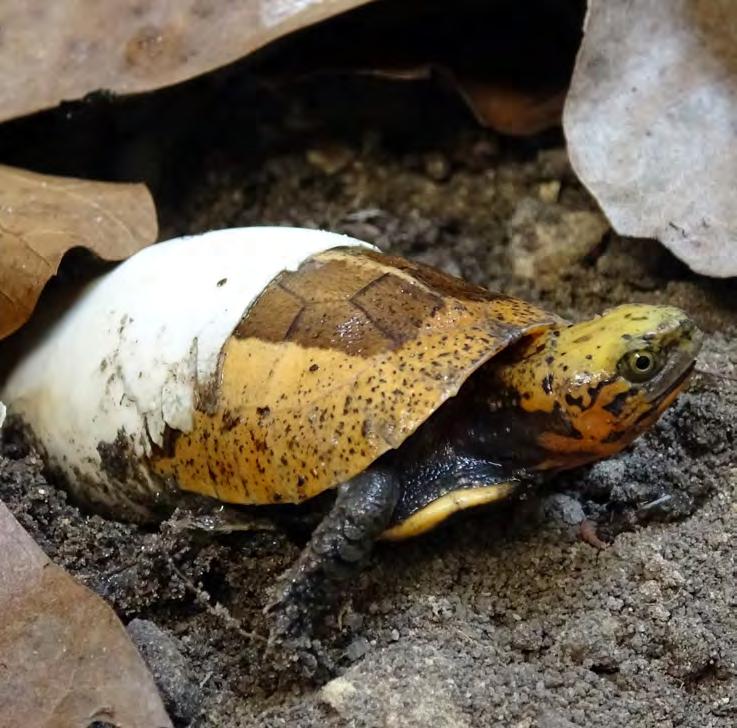
time and acclimation are likely to be the most prominent factors for an increase in egg production, some changes in husbandry and diet over the past year may also be important contributing factors. This year was a record year for reproduction at the TSC. More than 400 eggs from 21 species were produced, compared to only 160 eggs from 18 species in 2016 and 125 eggs from 15 species in 2017. The priority species chosen for captive management at the TSC are thriving and reproducing exponentially, a testament to the knowledge and dedication of the staff.
Time, some enclosure modifications, diet additions, and probably several other factors have led to this year’s record-breaking reproduction. Examples of recent husbandry changes include: many turtles now have their own individual enclosures instead of being housed in pairs or small groups, and
males and females are only put together for mating encounters at appropriate times. This greatly reduces stress and injury from intraspecific aggression and constant mating attempts when housed together year-round. Additionally, since the wild diet of many species kept at the TSC is largely unknown, a wide variety of commercially available and cultivated food items are regularly being added to the diet mix in an attempt to provide the most complete diet possible. Furthermore, a regular vitamin/calcium supplement routine began in 2017. With regard to young specimens, hatchling Big-headed Turtles (Platysternon megacephalum) are now on a filtered recirculating system featuring spray bars to help simulate the flowing water of a stream habitat. This has been observed to aid in the proper shedding of their scutes.
One of the only known genetically unrep-
resented wild-caught pairs of Rote Island Snake-necked Turtles (Chelodina mccordi) in the U.S. resides at the TSC. The female has been in captivity since 1999 and has been without a mate for the majority of that time. The male was in a similar situation and was obtained in 2017. This year, the female produced a total of 23 eggs. One egg partially developed, yet failed to hatch. However, this is a good sign that this pair is becoming reproductively active again after nearly 20 years of solitary captive existence. Hopefully this pair will be producing many offspring in the future and adding a new bloodline to the U.S. captive population. With only 154 individuals in the Association of Zoos and Aquariums (AZA) managed studbook, many of which are related, a new genetic line will be an important addition for captive conservation efforts.
In October 2017, the TSC began the process of applying to become a certified related facility of the AZA. After a lengthy application preparation and submission process, an onsite inspection was conducted in June 2018. The AZA accreditation hearing was held in Seattle, WA on 23 September 2018 and there the TSA/TSC was granted certified related facility status. The certification will open doors for additional funding possibilities, provide eligibility for specific conservation awards, allow TSA staff to be studbook keepers, and will hold the TSC to a high standard of animal care. The AZA inspection team was very impressed with the TSC, including the institutional collection plan and operating procedures, demonstrating that the TSC staff have always held a high standard of animal care.
Contact: Cris Hagen, Turtle Survival Alliance, 1030 Jenkins Road, Suite D, Charleston, SC 29407, USA [chagen@ turtlesurvival.org]

The island of Sulawesi, in the Indonesian archipelago, is known to have two endemic species of turtles, the Sulawesi Forest Turtle (Leucocephalon yuwonoi) and the Forsten’s Tortoise (Indotestudo forstenii). Both species have proved challenging to successfully breed in captivity. These species are tropical and can mate and produce eggs any month of the year in the captive setting. At the Turtle Survival Center (TSC), both species are housed in the tropical Sulawesi Greenhouse. The breeding season is structured to coincide with winter months, as this is the off-season for many of the TSC’s other temperate and subtropical species. Mating events are brief, with animals paired for only a short time to allow copulation and prevent any unnecessary aggression. Throughout the year, we house both
species individually or, in rare cases, two female Forsten’s Tortoises in a larger enclosure, to limit these antagonistic interactions.
There are approximately 160 Forsten’s Tortoises spread amongst 29 institutions in the Association of Zoos and Aquariums (AZA) Studbook, with nearly one fourth of that total living at the TSC. The TSC has maintained a population of Forsten’s Tortoises since 2013, however, we have had low reproductive output. They receive a varied diet that includes a variety of vegetables and some fruit. In 2017, vitamin/mineral supplements and cuttlebone were regularly added to all turtle diets. Prior to this, supplements and cuttlebone were sporadic. During the 2017/2018 breed-
ing season, Forsten’s Tortoises were paired the same as they have been in years past, however egg production increased dramatically. We saw a more than threefold increase in egg production for the 2018 egg-laying season (23 eggs) when compared to the 2016 egg-laying season (seven eggs). We hypothesize that some of the observed increase in reproductive output could be correlated to acclimation time since moving to a new environment at the TSC. However, we would expect to see a somewhat gradual increase as individual animals “come online,” whereas production increased by 228%, suggesting that husbandry changes may have contributed to the increase in egg production.
For the Sulawesi Forest Turtle (Leucocepha-
lon yuwonoi), major husbandry changes were implemented this year. Initially, these animals were housed in medium Waterland Tubs with a shallow water area, however, keepers noticed that animals were struggling to come onto land to feed, which may also have restricted their ability to nest. After a brief pilot study in 2017, we decided to deepen the water for all individuals and provide rocks, which aid the turtles in climbing the ramps and offer perches in the deeper water. For the 2017/2018 winter breeding season, animals were paired similarly to the previous breeding season except we extended the time-frame to approximately twice as long (six months versus three months).
This extension allowed us to gain more breeding data and better detect if there were any peaks in egg production. Eggs were laid between April-October at the TSC with peaks in June and July (five and four eggs respectively). The lowest months of egg production were September and October with one egg produced each month. Prior to 2018, less than 12 eggs had been produced since 2013. We observed a 700% increase in egg production in 2018 compared to 2017, with 17 eggs produced. The majority of these eggs were produced from animals brought to the TSC in 2013.
This year saw the production of the first captive-hatched Sulawesi Forest Turtles at

the TSC. The first hatchling was found in March from an egg that was most likely laid sometime in October 2017 from a female that has laid non-viable eggs for over a decade. On June 1st the same female laid another egg that was collected and placed in an incubator at 26° C (78° F). This second hatchling emerged after 5 1/2 months of incubation. Time, husbandry changes, diet additions, and extended breeding periods all likely played key roles in making 2018 such a successful year.
Contact: Nathan Haislip, Turtle Survival Alliance, 1030 Jenkins Road, Suite D, Charleston, SC 29407, USA [nhaislip@ turtlesurvival.org]
Deadline for Summer 2019 internship application is February 28th.
Deadline for Fall 2019 internship application is May 31st.
Start Date can vary based on availability after May 1st and August 1st.
The Chelonian Internship Program is perfect for undergraduates and graduate students who plan to pursue a career in conservation and captive management of turtles and tortoises.
Key Benefits:
• Gain hands-on experience with the day to day operations of a chelonian conservation center.

• Build husbandry skills for ex situ conservation for some of the most endangered chelonians in the world.
• Develop basic veterinary care techniques as they apply to captive chelonian husbandry.
For more information including responsibilities, expectations, qualifications, costs, and how to apply contact Clint Doak at cdoak@turtlesurvival.org.
Cris Hagen, Nathan Haislip, Carol Alvarez, Clinton Doak, and John Greene
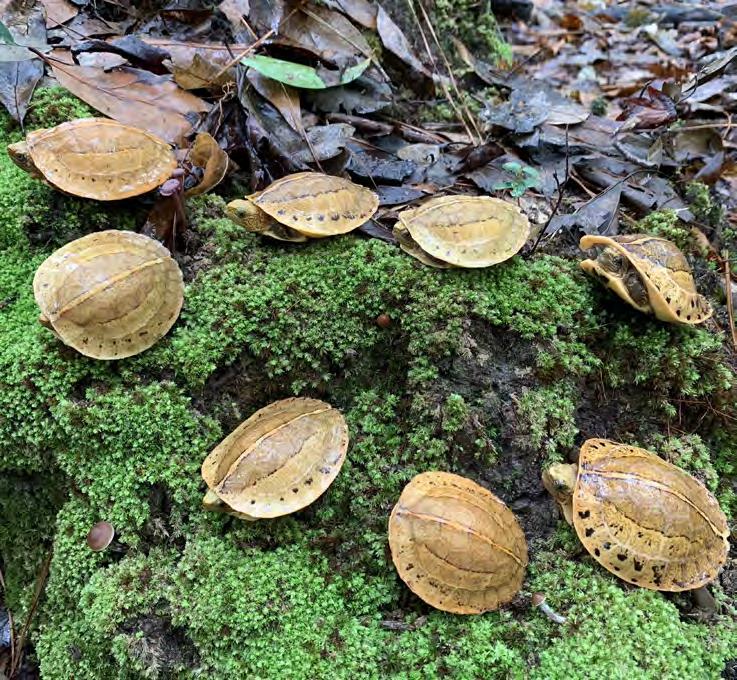
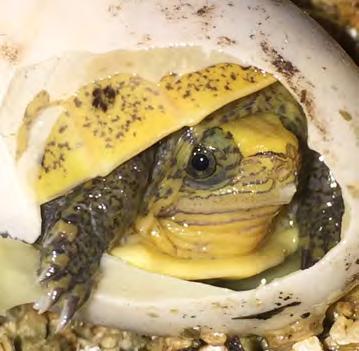
ing all 8 adult females in the collection. The adults arrived in different groups during 2014, 2015, and 2017. Double clutching, and in one case triple clutching, was documented in 5 females. There was a 45% hatch rate and eggs were incubated at various temperatures to produce both sexes. To our knowledge, this is the most captive bred C. picturata produced worldwide in a single breeding season at any one location.
The Southern Vietnam Box Turtle (Cuora picturata) was described in 1998 and for many years was known only from trade specimens until the first scientific documentation in the wild occurred in 2011. Originally recognized as a subspecies of the Indochinese Box Turtle (Cuora galbinfrons), further molecular research elevated C. picturata to full species status in 2003. They have been commercially collected and observed in the international food and pet trades since at least the early 1990’s.
This species has generally been considered difficult to breed in captivity with limited, yet steady success among a handful of turtle specialists worldwide. The Turtle Survival Center (TSC) is the only institution in the U.S. known to have successfully bred them.
This has been a banner year for C. picturata propagation at the TSC. Prior to 2018, a total of 8 C. picturata eggs were produced, resulting in a single hatchling. During the 2018 reproductive cycle, February to June, a total of 20 eggs were produced represent-
TSC staff collect data on eggs (measurements, developmental stages, temperature for sex determination, incubation durations, etc.), as well as life history information in regards to growth and maintenance of hatchlings and juveniles. Preliminary data, from a sample size of only two, suggests that C. picturata may grow and mature at a faster rate than its closest relatives C. galbinifrons and Bourret’s Box Turtle (Cuora bourreti) when raised under similar conditions.
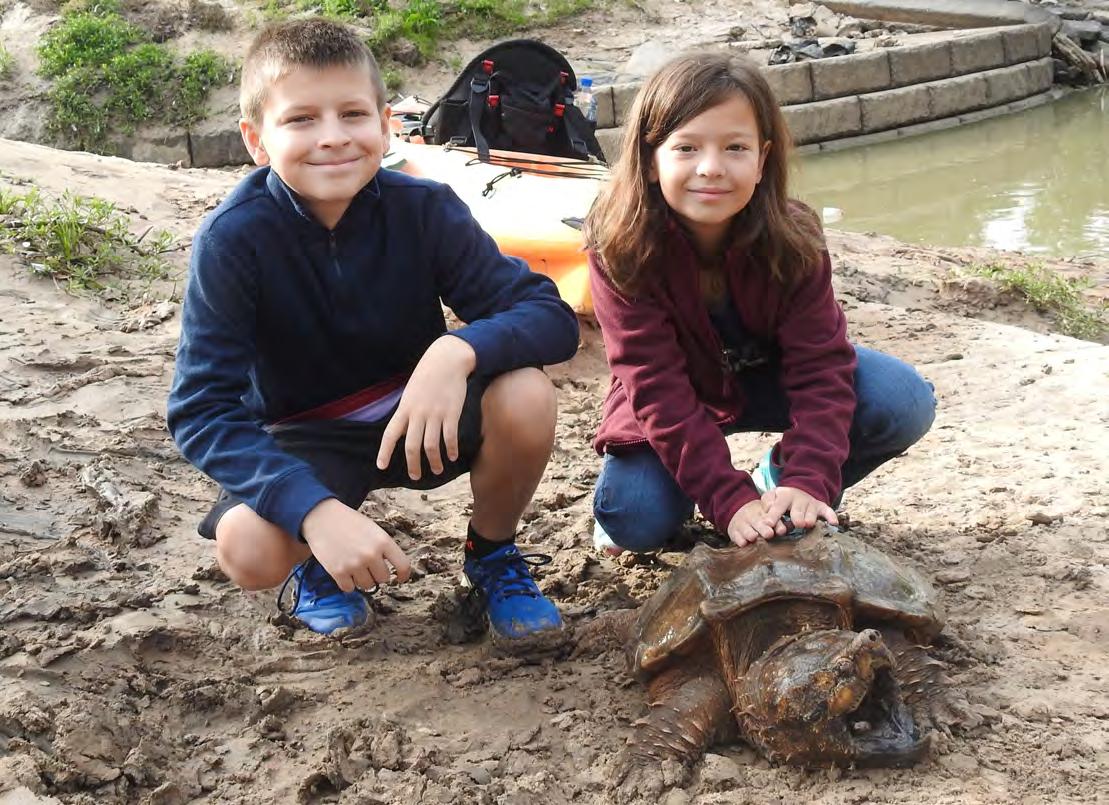
“The future is in your hands.” An oftrepeated statement in speeches to young audiences meant to inspire them, this statement, unfortunately, is often an absolvement of responsibility of the current generation, and bestowment of burden upon those of the future. We currently face a worldwide biodiversity crisis that will not be solved in a single generation alone. It is paramount for current leaders in biodiversity conser-
vation and research to foster involvement and encourage younger generations to both appreciate and take an interest in the world around them. In essence, we must champion our children and their children to not only carry our torch, but to light the path for others, promoting the understanding that wildlife conservation is not a whim. Rather, it should be an intrinsic part of who we are as human beings. After all, children are
naturally inquisitive, and it is said that scientists are kids that never stopped exploring.
It’s been clinically proven that fostering cognitive abilities, creativity, problem-solving skills, physical health, social relationships, self-discipline, and stress reduction enhance children’s growth and development. The environment for fostering these can be found all around you; in back yards, in neighbor-
hoods, in parks—it’s called nature! Conservationists need to find ways to move and empower younger generations to explore and protect the natural world. An emerging environmentalist sees the natural world not as a resource, but a delicate web of which we are just one part, and deserving of our utmost respect and care—a line of argument that is particularly appealing to young people. We must teach our children to live and learn as part of nature, not apart from it. What does it take to get today’s young people excited about environmental conservation? How do we harness their energy, creativity, and desire to take part in conservation efforts? The Turtle Survival Alliance’s North American Freshwater Turtle Research Group (TSANAFTRG) believes it should begin with hands-on work in an outdoor setting, giving them real-world experiences that boost their interest and enthusiasm for the natural world. If we show kids the value of research and conservation, while having fun doing it, then maybe we can persuade some to become conservationists themselves. We have been fortunate to have a large group of young volunteers assisting with our research in Florida and Texas over the years, ranging in age from 8 to a 17-year-old high school senior. They are future conservationists and researchers; they are the future of TSA-NAFTRG.
Herein we focus on several of these young volunteers’ experiences to gather a better understanding of what young people find important and how they see themselves being able to participate in conservation efforts.
Michael Skibsted: I began volunteering with the TSA in late 2016, however, I had known about the TSA long before I learned I could join it! Unlike most, I first experienced the wonder of turtles through books. Living in California, I didn’t have much access to them in the wild. As I began to delve deeper into chelonian literature, I began to learn about the dire situation they face. Moreover, I realized that it was largely due to human related actions. Once I fully grasped this, I became restless and

yearned for more than books; I began to search for opportunities. Surprisingly, as a 4th grader (back in 2013) there weren’t many opportunities to help the world’s turtles. This all changed three years later when I got involved with TSANAFTRG, assisting with field studies at their Comal Springs research site. Through the TSA, I have really gotten a grasp on what conservation means, and the feelings that accompany it. Many people associate the term with working to protect an already threatened animal. Through TSA-NAFTRG I have realized that this interpretation is far from the truth. Conservation is simply working to conserve something that you love and, in return, receiving a feeling of great accomplishment that you have played a part in prolonging its survival.
Being 14 years of age, I have a different perspective than most. I believe anyone with a passion, no matter the age, has the power to change the field they work in and do great things for the animal they are working to save. If the passion is there, nothing can stop an individual from doing great things. I believe that incorporating more young people who truly radiate passion for the
field of conservation would benefit the future of conservation as a whole.
Madeleine Morrison: When I first began working with the group, I honestly didn’t understand the importance of the group’s research for conservation. In fact, I didn’t really know why they were doing their research—I was just happy to get to work with and learn about turtles. All of this changed, however, once I learned more about the organization. I now realize that one of the most important things scientists can do to protect a species is to learn everything they can about it. This information (mostly collected through field research) is paramount for learning the most efficient and effective ways to tailor conservation towards any specific species or organism. This is a powerful piece of information for me to have learned at such a young age, as it has truly changed the perspective that I approach my academics with. Additionally, performing species investigations with TSA-NAFTRG has heightened my appreciation of nature in all its complexities, and has therefore made me even more passionate about conservation. I cannot stress enough the importance of allowing people to have this realization at a young age.
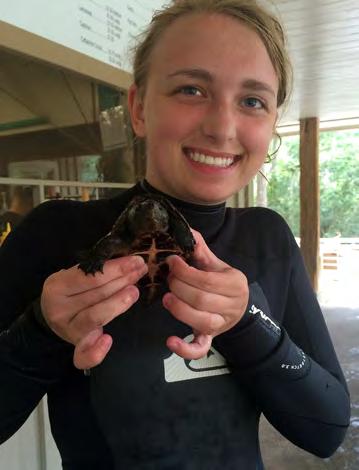
Tristan and Hailey Munscher: Both Tristan and Hailey Munscher have grown up with turtle research and conservation through their father Eric Munscher’s role within the TSA. One might think that being around such work on a constant basis would potentially dissuade them from wanting to participate. That couldn’t be further from the truth. Tristan and Hailey have taken to turtle research in their own way. Tristan (12)joined the TSA-NAFTRG team at Bull Creek in May and was able to capture 102 turtles on his own, a full third of the captured turtles that weekend. Hailey (9) has taken a shine to Alligator Snapping Turtles (Macrochelys temminckii) and joins her father on every trapping session there is. Both children understand the importance of turtle conservation and have a natural love and appreciation for the animals. Last year they devised a bait study for a local bayou in order to see if they could capture county record Common Musk Turtles (Sternotherus-odoratus) in Harris and Montgomery counties, Texas. They were successful and now have a distribution note in Herpetological Review
There are ever increasing numbers of conservation groups, including some state programs, who are creating programs geared toward younger generations. A few good examples of how conservation groups can enlist the help of younger generations and in so doing create a lasting impression on them are:
• Green Hour Program: The National Wildlife Federation’s Green Hour program is designed to encourage parents, schools, childcare centers, park agencies, camps, grandparents, and others to adopt a goal dedicating an hour of time per day for children to play and learn about nature in the outdoors.
•National Recreation and ParkAssociation: Wildlife Explorers Program (5-10); Nature Tykes (3-6)
•Pennsylvania Department of Conservation

Tabitha Hootman has been involved in the Turtle Survival Alliance – North American Freshwater Turtle Research Group’s (TSA – NAFTRG) turtle population studies in Florida for 14 years. Currently, Tabitha is a graduate student in Jacksonville University’s (JU) Marine Science Master’s Program. She is teamed with JU and TSA-NAFTRG to complete her thesis: Movement Patterns of Peninsula Cooter (Pseudemys peninsularis) and Florida Red-bellied Cooter (Pseudemys nelsoni) Found in Wekiwa Springs, Florida. The study stemmed from observations noted in our long-term population study at Wekiwa Springs State Park (WSSP). Over the years, the team would notice individuals leaving the sample area and then reappearing years later, sometimes in what seemed like groups. Originally, these observations were thought to be attributed to sampling bias, but as the data set grew, and other springs were added, it was noted there was movement into and out of the spring. The team would catch turtles at Kelly Park, approximately 14 km upriver, that were originally caught at WSSP, and vice versa.
In July 2018, 48 turtles from the sample area were outfitted with radio transmitters. Additionally, four turtles were outfitted with GPS data loggers. Starting on 4 August 2018, Tabitha has tracked these turtles every weekend. She covers about 48 km while tracking their movements and logging locations into a handheld GPS unit. She will continue to track the turtles for one full year. At the end of the year, Tabitha expects to discover the extent of the turtles’ movements and assess their migratory nature from her observations so that we can better understand how far they travel, or if they leave the area for any period of time.
This study is the first of its kind to track the movements and migration patterns of both freshwater turtles. Little information exists concerning the habitat requirements and movement patterns of the Peninsula Cooter and Florida Red-bellied Turtle. The data acquired will provide vital information, elucidating habitat preferences and critical habitats required to maintain these populations.
and Natural Resources (Good Natured)
• National Park Service Junior Ranger Program (https://www.nps.gov/kids/jrRangers.cfm)
As conservation stewards, we must further empower and cultivate younger generations with
the aim that they can stand up together with us and say, “The future of wildlife is in our hands.”
Contact: Eric Munscher, SWCA Environmental Consultants, 10245 West Little York, Houston, Texas, USA [emunscher@swca.com]
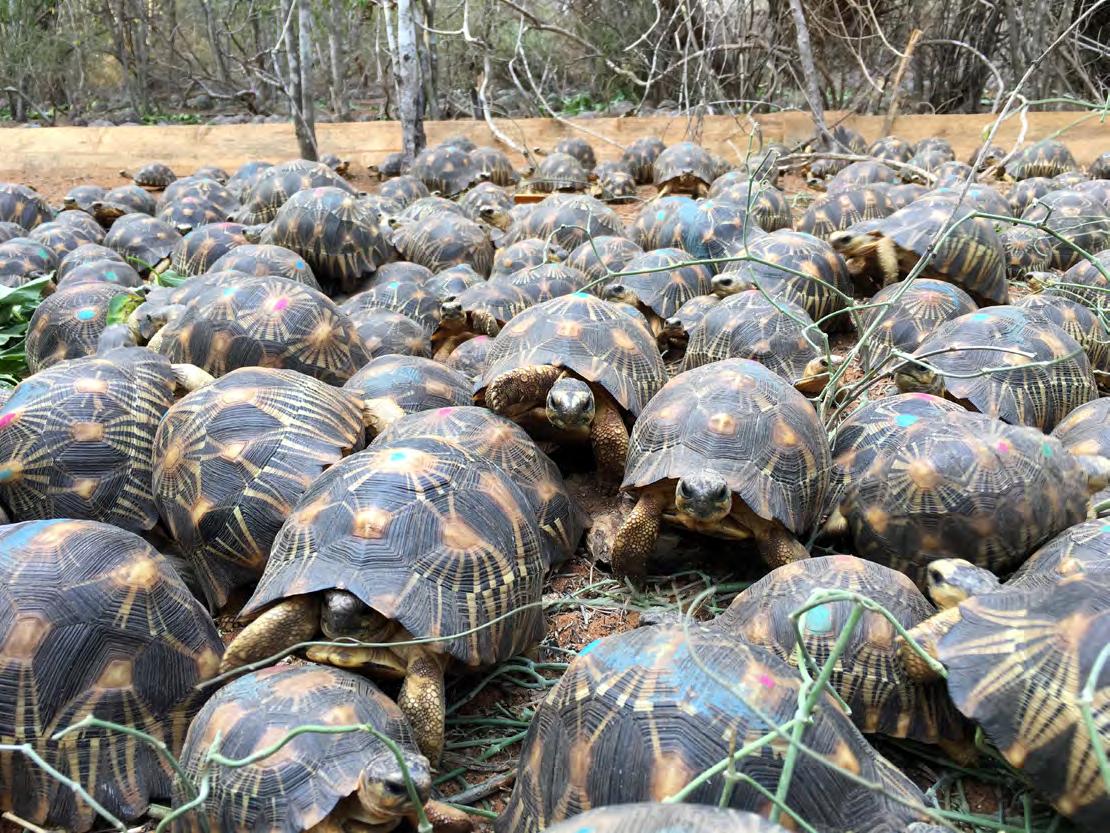
2018 was to become an unforgettable year for TSA Madagascar, unfortunately for many of the wrong reasons. Tortoise confiscations continued to mount, and dominated program activities for the third year straight—punctuated by the largest tortoise seizure on record. Over 10,000 Radiated Tortoises (Astochelys radiata) were seized in Toliara (Tuléar) in April, the magnitude of which rocked both the global conser-
vation community as well as Malagasy authorities. In the words of an ambassador at the U.S. Embassy in Antananarivo, “This one crossed the line.”
Officers and first responders from the Ministry of Environment, Ecology, and Forests (MEEF/Atsimo-Andrefana region) were shocked by the horror of so many sick and dying tortoises, and faced innumerable challenges in moving and caring for them.
Fortunately, a tortoise center in nearby Ifaty – SOPTOM’s Village des Tortues – was available to receive the tortoises. TSA Madagascar rapidly responded by sending in a vet team led by Dr. Ny Aina Tiana Rakotoarisoa (TSA) and colleagues from Durrell Wildlife Conservation Trust and the veterinary school in Antananarivo. For the first 10 days, this small team worked tirelessly to save tortoises suffering from starvation, dehydration, and
neglect at the hands of cruel and greedy wildlife traffickers.
Meanwhile, at TSA headquarters, this became an all hands on deck moment and we immediately began mobilizing all available resources. By April 21st, the first wave of U.S. responders — Team Radiata 1 — had arrived in Madagascar, with staff representing TSA, Bronx Zoo/WCS, Oklahoma City, Dallas, Knoxville, and Hogle Zoos, and led by Dr. Bonnie Raphael. Armed with nearly 590 kilograms (1300 lbs.) of veterinary supplies, Team 1 continued the tasks of tortoise triage and determining which tortoises were strong enough to be moved to a permanent facility. The team was divided upon arrival, with some staying in Ifaty to treat tortoises and others going south to Lavavolo to prepare the existing tortoise center for A LOT of new arrivals. Prior to this time, the facility in Lavavolo was no more than a walled enclosure with no infrastructure for the people caring for tortoises. Due to an overwhelming response from the U.S. zoo and aquarium community, the TSA was able to deploy another six teams of wildlife warriors over the course of three months, consisting of vet techs, keepers, construction and maintenance workers, as well as some of the leading chelonian veterinarians in the world. Together these men and women — 75 in total — endured long hours and hardships, bonding together under harsh conditions and limited resources, to save nearly 10,000 Radiated Tortoises AND build a functioning tortoise center in a remote and isolated area of southwest Madagascar. It was one of TSA’s finest moments, illustrating our ability to deploy resources rapidly and effectively in times of crisis.
The TSA prides itself on being able to respond in these kinds of situations, but it must be noted that our job was made easier by the amazing outpouring of financial support from the global turtle conservation community. Over 70 organizations stepped up in this time of need, 45 of them

Association of Zoos and Aquariums (AZA) institutions, along with over 500 individual donors. While the number of donors and dollars raised is impressive and illustrates the generosity of our community in times of crisis, the brutal fact is that TSA Madagascar is now caring for over 23,000 tortoises spread over six centers. The financial impact of maintaining this many tortoises is considerable, and diverts resources from other important aspects of our organization. Our long term goal at the TSA is for zero turtle extinctions and, in order for this to become a reality, harsher punishments for poachers need to be established. Organized poaching syndicates must understand that there will be consequences for such griev-ous offenses. If not, the future of the Radi-ated Tortoise in the wild is doomed.
In a year that saw a publication describing the rapid extinction of the last wild populations of Ploughshare Tortoises (Astrochelys
yniphora), we must realize that we are on a similar trajectory with A. radiata and ask ourselves if we will allow this to happen on our watch.At the time of this writing, the three primary perpetrators of the Radiated Tortoise smuggling ring were recently given six years in prison and fines of $30,000, the most severe sentence ever handed down for poaching in Madagascar. However, this verdict is being appealed and we anxiously await the final word. It is important that this conviction and harsh penalty be upheld in order to send a strong signal to poachers, else this case will have been in vain. Without dogged persistence and enforcement, we could be writing the epitaph for this species in the not-too-distant future.
The TCC welcomesAndrew Leith, our first Peace Corp volunteer, who comes to us with a background in agriculture.Aside from im-
proving our vegetable garden, he is charged with working with the local communities and training them on improved agriculture techniques, enabling them to produce more food, as well as creating a source of revenue when they sell surplus produce to the TCC for tortoise food. On the construction front, we just broke ground on a new ultra-secure facility for our group of young Ploughshare Tortoises. As part of this project, and in keeping with our goal of improved security at the TCC, we will soon be bringing a greatly expanded solar power system to the Center. This will allow for a high-tech security system for our A. yniphora that is specifically designed to keep them safe. In addition to a range of other security measures, we are also finalizing plans for a sturdier and more predator proof perimeter fence to surround the 12-hectare core area. Finally, our new Community Outreach Center (COC) is taking shape and Phase 1 is nearing completion. Funds for the next two phases are secured, all supported through Utah’s Hogle Zoo. True to the vision of Christina Castellano, the COC will, once completed, have space for special community events, provide opportunities for education and outreach activities, offer comfortable accommodations for visiting scientists, donors and guests, and create a welcoming environment to the five local communities that, together, provided TSA with the land for the TCC (over 90 hectares total). In addition, a water collection cistern will provide much-needed water to these impoverished communities, which endure extreme hardships during the ever-worsening drought conditions in the south.
The tortoise poaching crisis is getting worse and, thusly, our concerns for the safety of the staff and tortoises at our Centers are increasing. To ensure that our security guards are better prepared to deal with potential threats, we have contracted with a leading global security solutions group, G4S. In July, staff from the TCC and LTC traveled to Ampanihy
for three days of intensive training. Soon, G4S will make site visits to both Centers to make recommendations for improving security measures and to train staff in their specific work environments. Maintaining good relations with the local communities is integral to our security plans as they are our first line of defense against poachers.
Josh Lucas (University of Central Oklahoma and OKC Zoo), in pursuit of his MS degree with financial support provided by Oklahoma City Zoo, and the TSA, are partnering to pioneer a reintroduction strategy for confiscated Radiated Tortoises. This strategy will entail an extensive investigative effort over a minimum of two years, and the results will have the potential to shape how we manage reintroductions in the future. Since it is highly likely that tortoises will continue to be confiscated, it’s im-
portant that we develop and implement an effective system that protects, monitors, and stewards these animals back into the wild.
Our strategy focuses on evaluating three key components: 1) community engagement 2) habitat condition and 3) poacher accessibility. Also, a combination of intense groundtruthing, GIS mapping, and a multitude of follow up surveys will allow us to key in on sites with the highest potential for success. Local community involvement and engagement is certainly the most important aspect of this project and, ultimately, our success will depend upon the willingness of local people to protect the tortoises. To help us better understand the needs, traditions, and perceptions of local communities, we are supporting a study by Naomi Ploos van Amstel, a Dutch MS student who is conducting a broad social survey, the results of which will impact not only site selection but how we incentivize those communities selected.
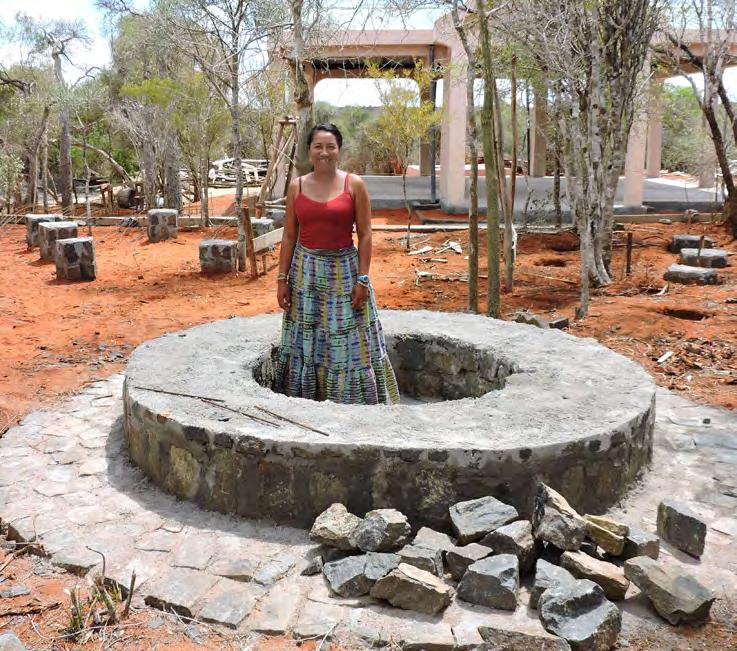
Once sites are selected, we will employ a soft release strategy to encourage site fidelity, the inclination of the tortoises to remain in the general vicinity where released. The goal is to establish large (~ 1- 2 hectares depending on number and size of tortoises) pre-release enclosures in each site selected, allowing tortoises to acclimate to their new surroundings over a period of one year. Once the enclosure walls are removed, the tortoises will be officially released and allowed to move where they choose. We will continue to monitor the health, movements, and survival of the tortoises via annual population assessment surveys.
As previously stated, reintroduction of the tortoises into their natural habitat is a multifaceted task that will require the collaboration of many people. Josh will be relying on, and working across, different scientific disciplines with local TSA staff and biologists who possess the skill and resolve to move this project ahead. Josh’s role will be to coordinate the efforts of this team from abroad, then spend summers in Madagascar pulling the various components together.
In Josh’s words: “The time to save Radiated Tortoises is NOW. No longer do we have the luxury of sitting idly by and hoping for the best. They are vanishing right before our eyes. The 10,000 are but a fraction of what disappears annually from Madagascar’s spiny forests. TSA has stepped up in a colossal way to be a force for change in the future of this species, and I am honored to be a part of this effort. By stepping into the role of Reintroduction Project Manager I am committed to use the wide array of resources at my disposal to make this project a conservation success.”
ENFORCEMENT MORE IMPORTANT NOW THAN EVER
Obviously, we cannot catch all tortoise poachers, but we must maintain vigilant and continue to apprehend and jail them as a strong, visible reminder that poaching has
• Arnaud Miarison has been hired as Lead Keeper for the Lavavolo Tortoise Center and is responsible for management of a staff of 12 keepers and security guards, as well as the procurement of food, water and supplies. Arnaud also provides oversight of TSA’s rescue centers at Betioky and Ampanihy, is well versed in farming techniques, and has installed gardens throughout the LTC that will help sustain the Center during times of drought. Arnaud comes to us from AVSF, a French veterinary support organization for livestock.
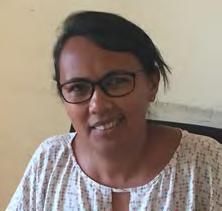

• Hanta Rasoanaivo is the new Finance Manager for TSA Madagascar and is in charge of all aspects of accounting, as well as other senior administrative duties for the office. Hanta graduated from the University of Antananarivo with a degree in law and economic studies and has 25 years of experience in finance management including managing a World Bank project.
• Christel Griffioen is the newly appointed Director of Tortoise Conservation for the Tandroy Region. Christel hails from the Netherlands and comes to us after a stint at the Angkor Center for Conservation and Biodiversity in Cambodia where her passion for chelonians became clear. She has over 15 years working experience with a diversity of species in zoos and wildlife rescue centers throughout Europe and the Middle East. Christel became enamored with Madagascar while spending three weeks helping with the big tortoise rescue earlier this year, and in September assumed the duties of managing the Tortoise Conservation Center. She oversees a staff of 14, including keepers and security guards, and will play a key role in overseeing construction and the myriad field expeditions necessary for developing reintroduction plans.
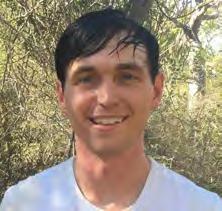
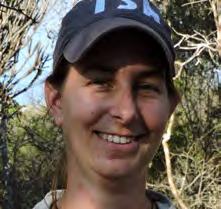
• Josh Lucas is currently the Lead Keeper of Herpetology at the OKC Zoo and was recently awarded the title of AZA Hero for his passion and devotion to reptile and amphibian conservation. He brings a diverse background of conservation experience into his new role with the TSA as the Reintroduction Project Manager for Radiated Tortoises in Madagascar.
serious consequences. This important aspect of the TSA program has not been well funded for several years, but in 2019 we hope to change that. Our Enforcement Officer, Sylvain Mahazotahy, will resume his important role in applying the dina (a taboo-based social by-law that punishes communities that tolerate poaching activity) throughout the Tandroy region. Further west, in the Atsimo-Andrefana region, the TSA established an emergency response fund that would allow DREEF officials to travel and investigate reports of poaching activity. We believe there is a critical threshold that enforcement must commit to; stay above it and we will maintain some wild tortoise populations, fall below it and we lose this war.
Radiated Tortoises are not the only species impacted by the illegal trade. Due to confiscations over the years we have acquired hundreds of Spider Tortoises (Pyxis arachnoides) that now represent the founders for our assurance colonies. When we conceptualized the TCC, we had plans to manage only a small colony of the Southern Spider Tortoises (P. a. oblonga), the most endangered and range restricted of the three subspecies. The TCC is located within good oblonga habitat, and a small wild population exists within the confines of the Center, so this was a logical decision. Today, though, we have a captive population numbering 130 animals and a new management facility is being built, funded by our strong partner Zoo Knoxville. Eggs are already incubating in situ and the future for these tortoises is looking brighter. In addition to this success at the TTC, we have a nucleus of 120 Common Spider Tortoises (P. a. arachnoides), at the LTC near Itampolo where hatchlings are already being found. Like the TCC, the LTC is located within good Pyxis habitat so success is predictable. Finally, we also have a group of over 100 of the Northern Spider Tortoises (P. a. brygooi), located in two of the rescue centers. We have not decided whether to maintain this group or not but, to date, we have been unable to identify a local
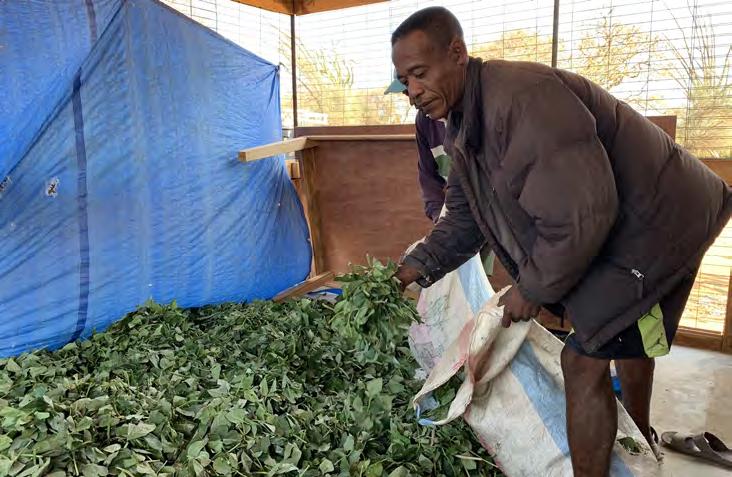
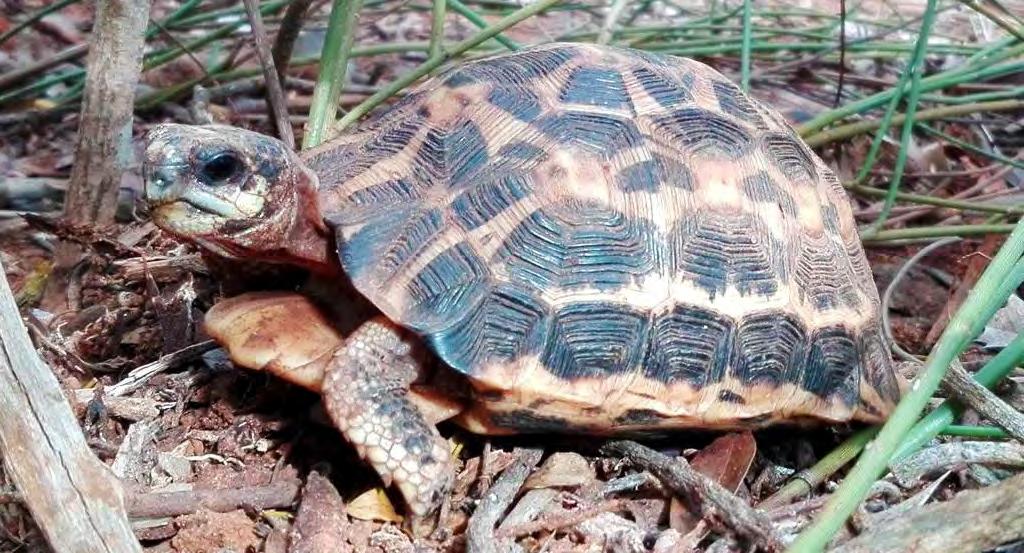
partner with the capacity to help repatriate them to a protected area within their range.
Acknowledgements: For ongoing programmatic support we thank the following: Utah’s Hogle Zoo, Gregory Family Charitable Fund, Nature’s Own, Owen Griffiths/Francois Leguat Ltd., Zoo Knoxville, Columbus Zoo, LA Zoo, The Marjean and Richard Brooks Family Fund, Radiated Tortoise SSP, AZA Radiated Tortoise SAFE program. We would like to thank
all of the numerous zoos, aquariums, non-profit, NGO’s, governmental agencies, and individual donors that provided personnel, equipment, and financial support for our rescue efforts on behalf of confiscated tortoises this year. A special thanks goes to the Wildlife Conservation Society/Bronx Zoo for their exemplary contribution during the April crisis.
Contact: Rick Hudson, Turtle Survival Alliance, 1030 Jenkins Rd. Ste. D, Charleston, SC, USA 29407 [rhudson@turtlesurvival.org]
When April’s record shattering Radiated Tortoise confiscation first took place, I was sent on behalf of the Oklahoma City Zoo to provide aid. At the time I didn’t quite understand what this would entail, but I knew that I had a passion for these animals and wanted to do everything that I could to help. I am privileged to have been a part of the very first team on the ground, now known as Team Radiata 1. We all stepped off of the plane with an overwhelming eagerness to get started, but that initial enthusiasm descended into a tangle of anxiety and head strong determination upon arrival on the scene.
My recollection of day one is still vivid in my mind and I won’t soon forget seeing some 10,000 critically endangered tortoises clustered together en masse. Many were weak, dehydrated, and malnourished. My role was split into two phases; the first involved participation in immediate triage and hydration work at the center in Ifaty. The second saw me travel much further south, to TSA’s new facility in Lavavolo. It was here that I witnessed TSA’s incredible resolve to include local communities in tortoise conservation. The first thing we did was petition the village elder to use sacred land in order to protect these tortoises (I say “we” but really I just sat back in amazement as the process unfolded; Herilala Randriamahazo is the true champion of this effort).
I was one of two Team Radiata 1 members to see the Lavavolo site in its earliest stages. Now, I am the only one to have returned to the site since the confiscation took place so I have a unique perspective on the exponential progression of this place in just five months. When we first arrived at Lavavolo the only thing separating the tortoise site from the wilds of southern Madagascar was a 12-18” rock barrier that circled the perimeter of the tortoise habitat. That is all that was there; no construction had taken place yet but rocks had been dug up from

surrounding areas, standing upright, partially in the ground, enclosing what would later become a an advanced tortoise rescue facility.
It was hard to imagine back then, but amazingly the rescue site has been transformed entirely and the hard work of the local community and Teams Radiata 2-7 is not lost on me in any way. When we first arrived, we had no access to water and had to send a driver at least twice daily with 4-6 empty barrels to fill up at the nearest well which was half an hour away. Nonetheless we pushed on. It wasn’t until our last hour on the ground that a truck loaded with construction supplies finally arrived. By the end of my time in Lavavolo, we had divided the rocky perimeter into quadrants for different sized tortoises and we devotedly watered and fed some 1,800 tortoises that had arrived from Ifaty. Longer-term facilities were built at the site as time went on, and members of later waves may recall watching the start of a vet clinic, storage shed, and food prep area going up.
Now, five months later, the Lavavolo Tortoise Center is beaming with life and fortitude, standing as a beacon of light for Radiated Tortoise conservation. Well- constructed rock walls
topped with security wire contain 9,925 tortoises, 8,900 from the Tuléar confiscation and 1,025 from previous seizures. Fourteen staff members manage this Center, including six security guards and six keepers. That equivocates to 1,650 tortoises per keeper. The vet clinic has been completed, and an immaculate food prep kitchen sits adjacent to a large room for receiving food, much of which is grown by the local people and purchased by TSA. The facility now has adequate water storage and it’s easier to keep the tortoise water bowls full and clean. All of the surviving confiscated tortoises have been transferred and are recovering from this horrific confiscation better than we expected.
On my latest visit, I found primarily brighteyed tortoises with good weights, clear eyes, and mouths stuffed with food. Simply thinking about them has me smiling from ear to ear as I write. These tortoises are in capable hands and are undoubtedly going to thrive in their temporary captivity until we can guide them back into the wild where they belong.
Contact: Josh Lucas, Oklahoma Zoo and Botanical Garden, 2101 NE 50th St, Oklahoma City, OK, USA 73111 [jlucas@ okczoo.org]
Bonnie L. Raphael, DVM
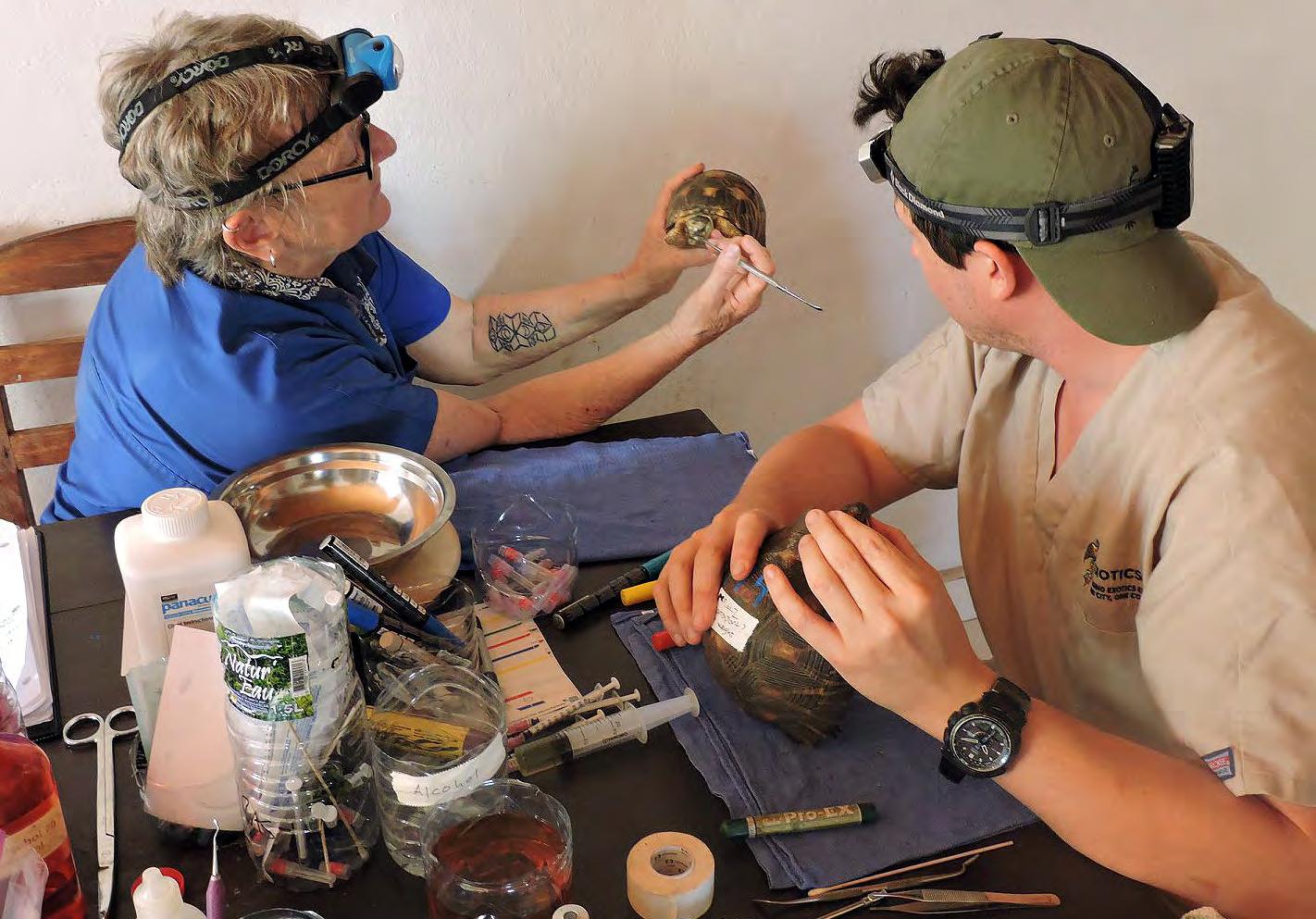
As word of the large confiscation of Radiated Tortoises (Astrochelys radiata) reached veterinarians, procedures for dealing with the anticipated medical problems were initiated. Based on previous confiscations, estimates of the supplies needed were made and distributed to TSA members, zoos, and aquariums.
We knew we could expect stress related illness and depending on how long the tortoises had been held in captivity, and the conditions in which they had been kept, nutritional disorders could also be anticipated.
We knew that the TSA’s Malagasy veterinary team had been providing excellent emer-
gency care with scarce resources, and that supplies were desperately needed. Donations of approximately 590 kilograms (1300 lbs.) of medical supplies were carried to Madagascar with the first wave of responders until conditions on the ground could be assessed.
In the first wave of ex-pat responders were 2 clinical veterinarians and a veterinary pathologist from the Wildlife Conservation Society (WCS). Once we arrived on site we were able to provide immediate assistance to the Malagasy veterinarians. Dr. Conley, the pathologist, set up a post-mortem area and began necropsy examinations on dead
tortoises. In addition to photographing, measuring, and examining each tortoise, hundreds of samples were collected from these cases for further examination such as histopathology and molecular analysis (PCR). Due to limited laboratory facilities in Madagascar the samples were designated for export to WCS in New York City.
Remarkably, a large majority of the tortoises were in fair condition. After being soaked in water and being fed daily, many of them rebounded quickly from their initial lassitude. Approximately 10% of them showed signs of moderate to severe illness requiring
medical treatment with fluids, vitamins, antibiotics, and analgesics. Most of the ill ones were emaciated from chronic malnutrition resulting in softening shells, and about 25% of the sick ones had severe inflammation of the mouth. There was concern that the mouth lesions could have been caused by viral infections such as herpesvirus, picornavirus, or bacterial or parasitic infections (Mycoplasma or intranuclear coccidia). During the first month of intensive treatment the medical case load was reduced from 1,000 animals to approximately 200. Very few new cases developed after medical care was begun.
In order to import the tissue samples into the USA, permits from both the Madagascar government and the US Fish and Wildlife Service (USFWS) are required. Thanks to special attention by the Malagasy authorities, the registrar at the WCS and the USFWS, an emergency import permit was issued. All of the samples arrived safely at the WCS by mid-June and when Disney’s Animal Kingdom provided funding, the processing and testing all the samples was able to start in a timely manner.
The samples were sent to multiple labs in the US. In addition to microscopic examination of all tissues (histopathology) by 5 pathologists, testing included PCR for herpesviruses, ranaviruses, adenoviruses, intranuclear coccidian, and Mycoplasma species. In addition to those, a subset was tested for tortoise picornavirus (Rafivirus) and for Reptilian orthoreovirus. All tested samples were negative for all pathogens. Finally, to understand if pathogens may already be present in the wild, samples that had been collected across the Radiated Tortoise’s range in Madagascar in 2010 were also tested. Those samples, too, tested negative.
Lesions related to long-term starvation were the most consistent findings in the tortoise mortalities. There was complete lack of fat stores at necropsy. Abnormal findings such as heart, kidney, or vascular disease were
not seen. Additionally, a large number of tortoises had soft shells. This is consistent with lack of normal levels of calcium, phosphorus, or vitamin D in the diet and lack of access to sunlight, or underlying kidney disease. One of the most striking findings seen at necropsy was severe irritation of the mouth (stomatitis) in many of the cases. Testing has eliminated the most common infectious causes of stomatitis and indicated that bacterial infections were a secondary process, likely occurring opportunistically after a primary insult. Parasites were present in a large percentage of cases, but neither parasites nor intramuscular parasites were associated with disease and were considered incidental.
In summary, most of the lesions seen in the tortoises from the confiscation were consistent with suboptimal nutrition and/ or husbandry. The result of all of the histopathology and PCR testing have not uncovered any infectious disease in these confiscated tortoises. Combined with the advanced laboratory testing, we believe that these confiscated tortoises do not present a disease threat to free ranging wild tortoises.
Although the results of the testing from the April confiscation weren’t completed until November, they are and will be important for future plans for the tortoises now housed at the Lavavolo Tortoise Center. Furthermore, the results informed treatment for the year’s second large confiscation that occurred in late October, by providing information regarding the most likely or unlikely causes of clinical signs in the tortoises.
A special acknowledgment goes out to Disney’s Animal Kingdom, without whose generosity and willingness to immediately provide funding, the medical testing could not have been done. Thanks to all the veterinarians and veterinary technicians that donated their time and expertise, the many husbandry persons and interested volunteers, and all the institutional support for responding to this crisis and helping to assure that most of the animals have been placed in a secure facility for long-term recuperation.
Contact: Bonnie L. Raphael [bonnielrahzv@gmail.com]
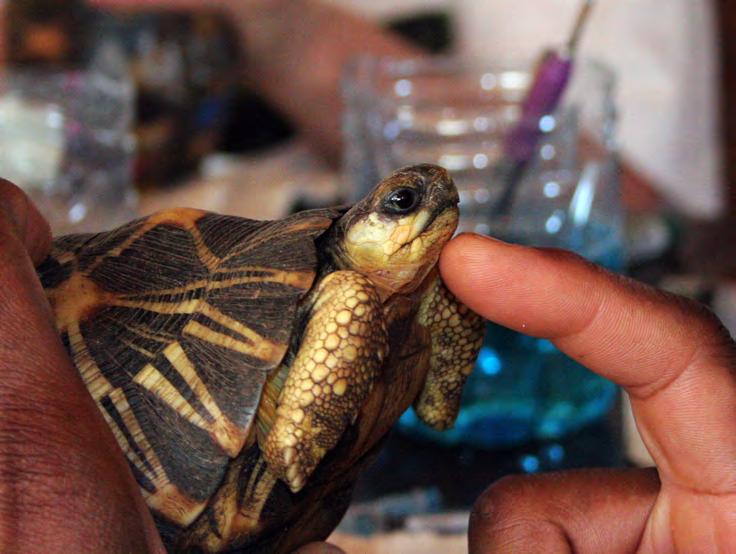
Scott Trageser
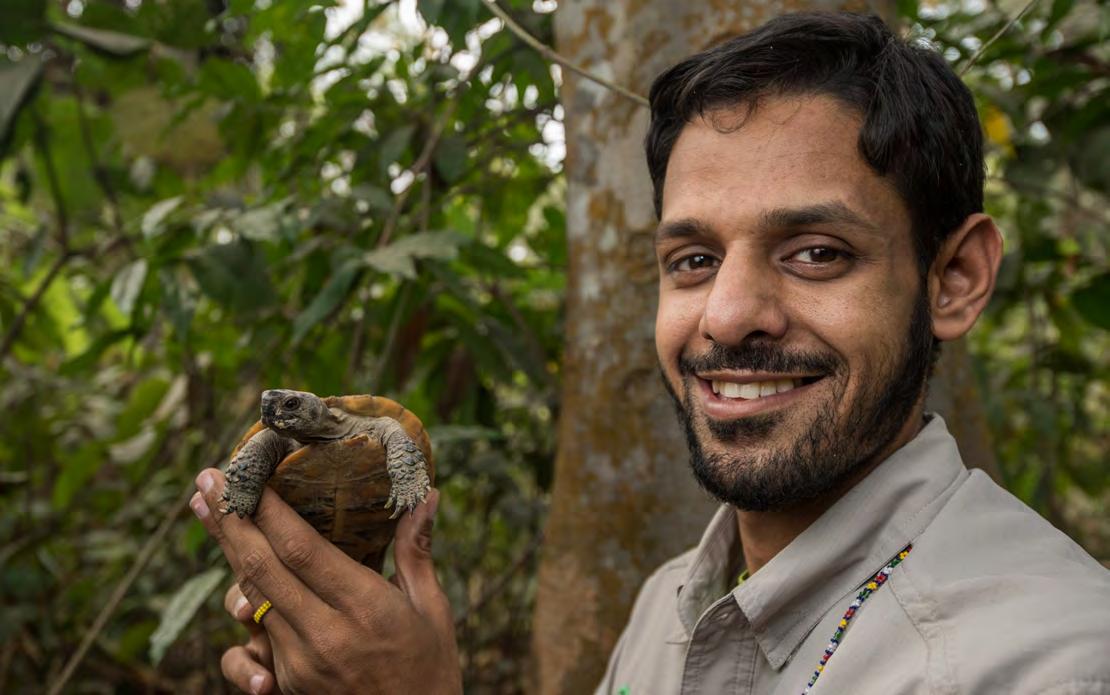
Each year, Bangladesh becomes more unpredictable; it’s the nature of the beast. This is a country where just a few decades ago, over 80% of the population was suffering from extreme poverty, but in 2024 it is predicted that poverty will be eliminated amongst its population of 166 million. This is a country of change, and the Creative Conservation Alliance (CCA) is a part of that change.
Our work focuses on the most remote region of the country, the Chittagong Hill Tracts (CHT). This region, in southeastern Bangla-
desh, is the only area with significant rises in elevation in the otherwise flat floodplain that comprises much of the country. Here in these hills, the last stands of old-growth tropical forest can be found — if you’re willing to make the long and sometimes treacherous trip down! It remains the least explored area in the country, as most of the limited exploratory research occurred during British colonial times. Since the rousing departure of the British more than 70 years ago, the area has become so politically complex and volatile that the Bangla-
desh Forest Department has had little to no influence over their own protected area: The Sangu Matamuhuri Reserve Forest. With no one to enforce environmental laws in the region, threats to the forest and its wildlife have taken a heavy toll. These forests serve as the last refuge in the country for many of the 30 globally-threatened species that call it home—all of which are becoming more threatened by the day. The situation here is dire, and not only for Bangladesh. Any win-lose scenario here will be felt across the greater cross-boundary region from Myan-
mar, through India, and into the Himalayan foothills of Nepal and Bhutan.
It’s not just the wildlife that call the CHT home; several tribes such as the Marma, Tripura, and Mro still practice some level of traditional life in the hills. The older generations of such tribes can still recount many of their traditions and remain formidable hunters. Ironically, it’s these traditional hunters that have been a boon to turtle conservation. We have repurposed their traditional ecological knowledge and empowered them as conservationists—which we refer to as parabiologists. Our parabiologist team is our wheelhouse; without them very little progress would be made. Ten hunter-turned-conservationists conduct routine village surveys to liberate harvested turtles and return them to the wild. They also provide us with reports of poached bears, gaur, tigers, and more—knowledge we would never be privy to without their local connections. Perhaps most beneficial of all, the parabiologists are ambassadors to the local communities for our organization and conservation, which promotes trust and fosters a willingness to partner so that we can change the forest together.
To date, our relationships with the indigenous have resulted in several sizable accomplishments. Ten Indigenous Community Protected Areas have been established, which currently protect 500 hectares and we have plans to expand these areas in the near future. Since 2016, six primary schools have been supported in the most remote regions of the CHT, where access to education was previously non-existent. We have also established indigo plantations for dye production and sale, and nationally marketed traditional indigenous crafts—the revenue of which goes to social businesses operated by indigenous women. Most recently, we have established a plant nursery and arboretum which has raised 10,000 native bamboo saplings as well as 3,000 seedlings representing 20 different native plant species, all for reforestation efforts. The bamboo seedlings
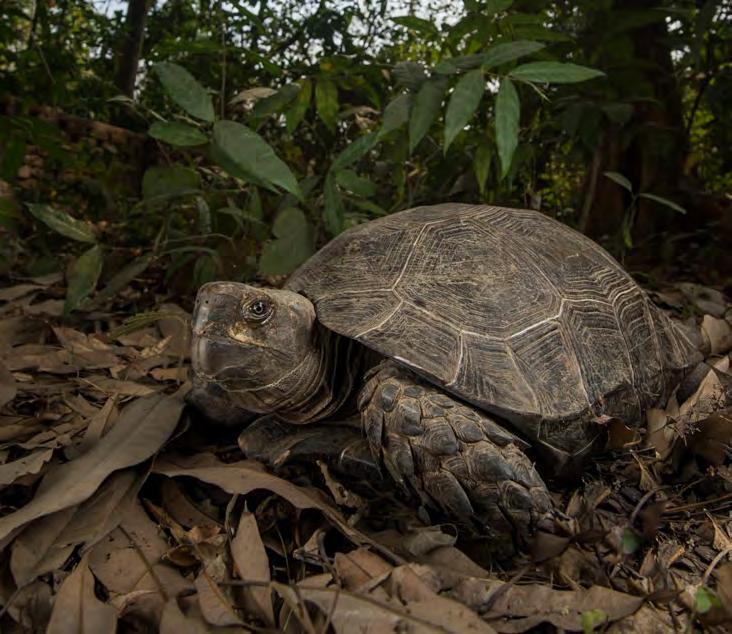
will also be distributed freely to the local people to begin sustainable bamboo cultivation. This can provide sustainable income while also restoring degraded land.
In 2017 we established the first in-country chelonian breeding center which safeguards eight Arakan Forest Turtles (Heosemys depressa), eight Asian Giant Tortoises (Manouria emys), a single Keeled Box Turtle (Cuora mouhotii), and four Elongated Tortoises (Indotestudo elongata). It is our hope to soon release hatchlings from our breeding center into the newly established community protected areas to repopulate the hills with species of turtle and tortoise that once roamed there in delightful abundance. Turtles are great seed dispersers and, as such, the reinforcement of turtle populations will also aid the health of the forest and promote reforestation in degraded areas. This is conservation breeding at its finest!
I’d like to end this with a request for your assistance. Funds in 2018 were scant, and running
a program of this magnitude in Bangladesh is no simple matter. Unfortunately, donors are rarely excited to fund human resources like our parabiologists—without which our conservation programs would have never gotten off the ground. With as little as $100 a month you can support the employment of one of our parabiologists or even cover the costs of running one of our indigenous primary schools for a month. That’s about $3/day which is what most of us will spend on our daily coffee fix. Your support is crucial for the conservation of our beloved turtles and tortoises!
Acknowledgements: We would like to thank Whitley Fund for Nature, Future for Nature, The Rufford Foundation, and the European Outdoor Conservation Association for their generous support of the Chittagong Hill Tracts Program in 2018.
Contact: Scott Trageser, Creative Conservation Alliance, Avenue 3, Road 13 A, House 925, Mirpur DOHS, Dhaka, Bangladesh [trageser.scott@gmail.com]
Doris Preininger, Rupali Ghosh, Peter Praschag & Anton Weissenbacher
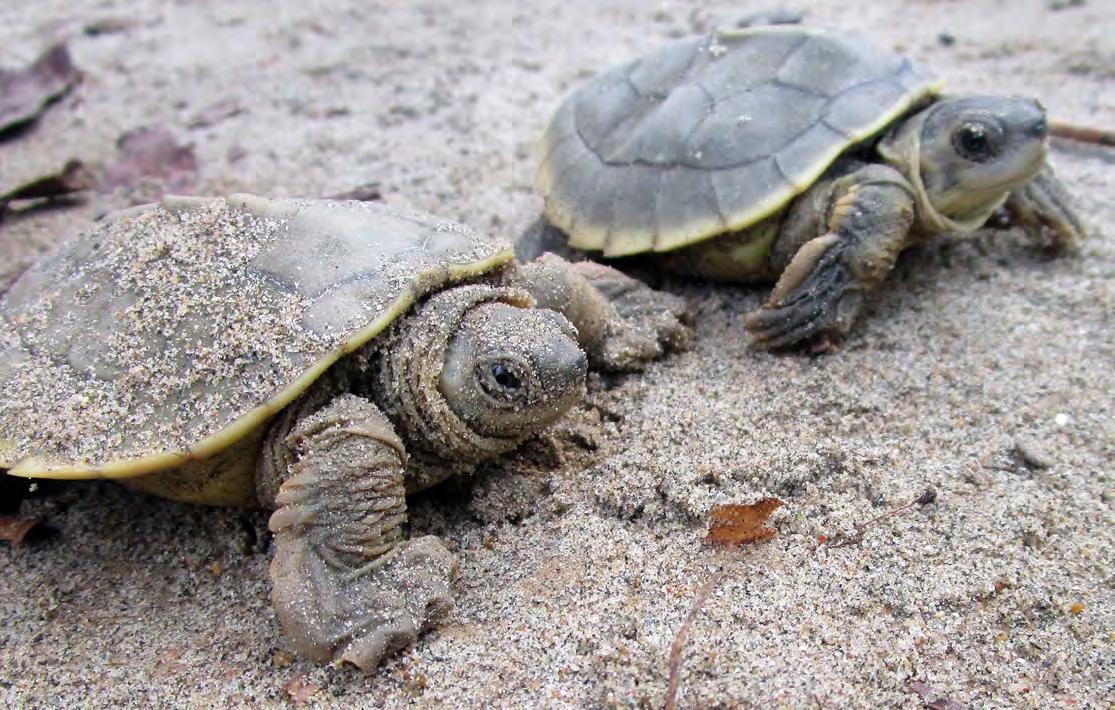
Three years ago the Batagur baska Project, a multinational conservation initiative for the critically endangered Northern River Terrapin (Batagur baska), established a second breeding facility in southern Bangladesh to complement the program’s existing conservation area in Bhawal National Park. In this time, new breeding environments, nesting beaches, and hatcheries have been established there. Today, this facility within the Karamjal Forest Station houses almost 150 individual terrapins.
This year, to accommodate the growing ju-
venile terrapins, we built an additional pond, which provides a better, more expansive habitat for the large number of four and fiveyear-olds. The Bangladesh Forest Department dedicated an unused area adjacent to the current project site, and a 40 x 20 x 3 m pond was dug with the help of local workers. This new juvenile habitat is surrounded by a sloping shoreline that serves as a basking area, and fortified walls which protect the terrapins from predators.
Meanwhile, the reproductive adult females at
both the Karamjal and Bhawal facilities laid their annual egg clutches in March. Roughly 70 days later, 44 young turtles successfully hatched. The continuously growing number of captive-bred individuals at the two facilities demonstrates that the Batagur baska Project provides a secure and productive captive environment for the Northern River Terrapin to successfully reproduce and flourish.
For the Batagur baska Project to ultimately be successful, it is imperative that the captive-breeding component connects to a
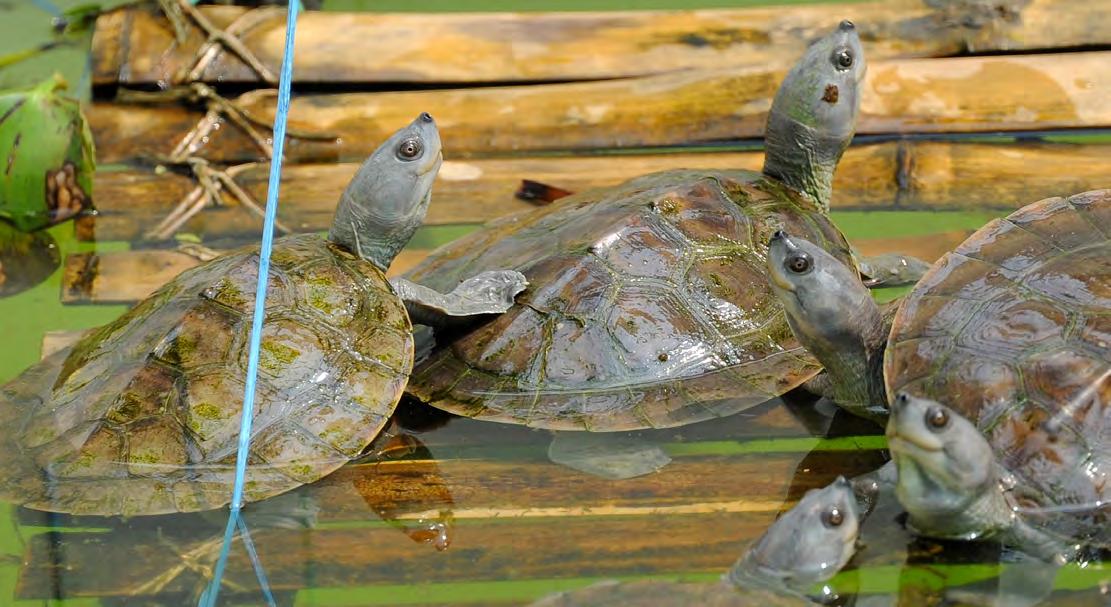
strategy for a sustainable reintroduction of the terrapin in the near future. This strategy includes fieldwork aimed at finding and protecting natural habitats utilized by the species. With the help of several funders, we were not only able to enlarge and renovate the breeding facilities, we were also able to finance new satellite transmitters for specimen tracking in their native habitat. The project team will equip five males with transmitters and release them in the Sundarbans at the beginning of the breeding season in October. Movement transmissions will hopefully help indicate habitat preferences and identify travel routes, which will be taken into consideration when strategizing a prospective release program in the future.
Acknowledgements: The project team of the Vienna Zoo, Turtle Survival Alliance, Prokriti O Jibon Foundation & Forest Department Bangladesh thanks the Zoological Society for the Conservation of Species and Populations (ZGAP), Deutsche Gesellschaft für Herpetologie

und Terrarienkunde (DGHT), REWE Group, the Austrian Zoo Organization (OZO), Turtle Conservation Fund (TCF), European Union of Aquarium Curators (EUAC), and the Edith HaberlandWagner Foundation for their grateful and continuous support.
Contact: Doris Preininger and Anton Weissenbacher, Vienna Zoo, Max-
ingstraße 13b, 1130, Vienna, Austria [d.preininger@zoovienna.at; a.weissenbacher@zoovienna]; Rupali Ghosh, Shant Kamal Kunj, 1, Shakti Colony, Rajkot 360001, Gujarat, India [rupali2001in@hotmail.com]; Peter Praschag, Turtle Island, Am Katzelbach 98, 8054 Graz, Austria [ppraschag@turtleisland.at]
Shailendra Singh, Bhasker Dixit, Arunima Singh, Rishika Dubla, Parimal Chandra Ray, Chandan Jani, Pawan Pareek, Rachna Tewari & J. Daren Riedle
India has long mesmerized the world as an emblem of rich cultural and natural heritage. Spanning approximately 3.25 million square kilometers, it is known for its kaleidoscopic range of climates and landscapes, such as the mystic Himalayan range in the north, semi-arid desert habitats in the west and central plains, and lush tropical forests in the south. It’s also home to iconic, yet endangered, wildlife like the Asian Elephant, Bengal Tiger, and Leopard. With a burgeoning population of 1.3 billion, and an expected growth of 16% by 2030, finding the balance between development and safeguarding the environment, especially aquatic systems, will continue to be a challenge. Of the 28 species of tortoises and freshwater turtles found in India, most are in a perilous state due to unsustainable harvesting and habitat degradation. The 3rd Indian Strategic Meeting, hosted in New Delhi by TSA and the Ministry of Environment, Forests & Climate Change, identified 17 species of turtles either Critically Endangered or Endangered. Currently, the Wildlife Conservation Society-India, with support from TSA, implements six turtle conservation projects across five states and reviews various national environment policies and planning initiatives in favor of endangered turtles.
Native to southern and southeastern Asia, the Asian Black Giant Tortoise (Manouria emys phayrei) in northeast India had been

extirpated, warranting immediate surveys and recovery efforts. The major goal this year was to document extant captive cohorts of M. e. phayrei and set up a recovery program via zoological networks. With only a marginal response from potential centers, physical visits to zoos across eight regional states were required in February 2018. These visits led to the discovery of Manouria in six of the fifteen zoos.
Starting with a modest breeding program in Nagaland Zoo, Dimapur, the animals were sequestered from display into specially designed breeding enclosures and provided a more balanced diet. One of the few handfuls of turtle species displaying parental care behavior, twelve adults were separated into four groups, and additional males were iso-
lated after courtship to prevent disturbance of nesting females. Of the four clutches deposited from April to June (158 eggs), 66 viable eggs were translocated to an incubation room for a more controlled environment. The 22 emergent hatchlings marked the first successful breeding event of this species for the zoo and the third in the region, after Mizoram and Manipur. Future goals entail surveys of potential release sites in Nagaland, where half the hatchlings released will be fitted with transmitters to discern dispersal and survival.
The Brahmaputra basin along the IndoMyanmar Biodiversity Hotspot is home to
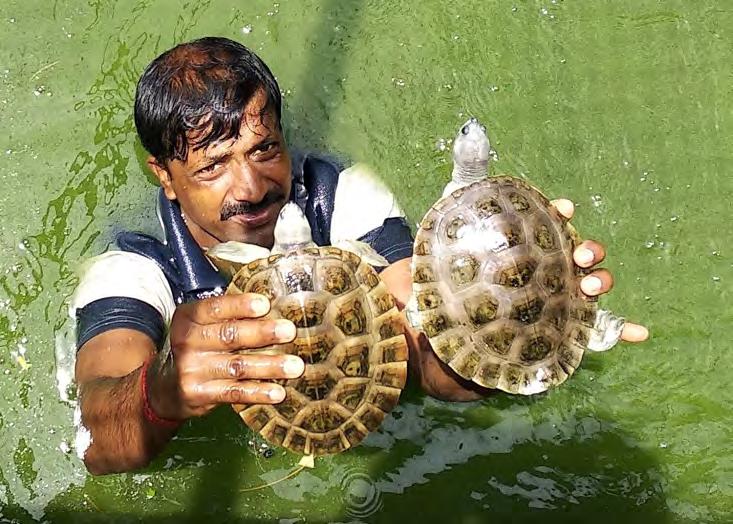
21 non-marine chelonians. Identified as a Turtle Priority Area, it has long-held global significance for the conservation of threatened and endemic species. The project broke ground last year with the acquisition of a defunct building from the Assam Tourism Development Corporation near the town of Bishwanath. Located on the northern banks of the Brahmaputra near Kaziranga National Park, this picturesque facility provides an ideal location to develop a long term hub for turtle conservation and outreach. Along with maintaining proactive field conservation and research efforts, five outreach programs conducted at the facility on environmental calendar days have reached over 1000 youths and community members. Additionally, 33 bi-lingual (English and Assamese) displays and interactive panels have been designed and installed, with three facilities for endangered turtles and tortoises scheduled next.
Nearing functional extinction in India and Bangladesh, the Northern River Terrapin (Batagur baska) is dependent on captive
breeding and management for survival in both countries. Fortunately, with the TSA’s proactive assistance, facilities and husbandry at the Sundarbans Tiger Reserve (STR) in Sajnekhali have improved, and now experiences significant annual breeding success. In 2017-2018, 110 offspring (F1), from 2012-2015 batches maintained in Sajnekhali, were distributed to multiple colonies across three freshwater ponds identified at various range stations. These colonies are located on islands within the park to avoid any loss of animals due to stochastic events. Whilst salinity and pH levels of the selected ponds were analyzed, comprehensive health assessments were conducted in semi-permanent holding facilities prior to shifting. While the STR provided financial support for improved infrastructure of the dedicated breeding enclosure there, none of the clutches from the four translocated, gravid females hatched in 2018, possibly due to high temperatures. Alternatively, the discovery of two wild juveniles sighted within the park’s periphery provided for great excitement. They were subsequently captured and translocated to our facility. Hopefully, additional activities
such as keeper training workshops held for the staff of all four facilities holding B. baska within the park in March, and future programs like the release of head started turtles with satellite transmitters, will help establish a viable population.
The Chambal River is recognized as the stronghold for two species of river terrapin, the Indian Red-crowned Roofed Turtle (Batagur kachuga) and the Three-striped Roofed Turtle (Batagur dhongoka), as well as the Indian Gharial (Gavialis gangeticus). The recovery project for Batagur in the river has protected tens of thousands of nests from predation and released hundreds of thousands of hatchlings over the past twelve years.
From 5 - 10 a.m. each day during the months of February and March, nest detection teams patrol the river’s banks, covering 10-15 km a day in scorching temperatures. Nests deemed vulnerable to predation and human disturbances are translocated to two temporary riverine hatcheries set up in the lower (near Chilonga / Garhaita villages) and middle sections (Malbasai / Barsala villages) of the river. Measuring 30 m x 20 m, these hatcheries are fenced with wire mesh to ward off predators, and provided roundthe-clock manned protection for the duration of the incubation period. This year, the field team was further challenged, risking their own lives as they continued to man the hatchery through violent dust storms that destroyed the hatchery infrastructure and field survey boats. Due to their heroic efforts, they managed to save all 317 nests (74 B. kachuga and 243 B. dhongoka). In all, over 5000 hatchlings were safely returned to the river at their corresponding natal sites within 24 hours of exiting the nest. Concurrently, 100 B. kachuga hatchlings were retained for a “rear-and-release” program at
our Garhaita Turtle Conservation Centre in Lucknow.
Simultaneous to the nest patrol, incubation, release, and head start efforts, sonic-telemetry is also carried out in the Chambal to ascertain the survival, home range, preferred habitat utilization, movement patterns, and natural history of B. kachuga. Data from ten individuals tagged in 2017 yielded a total of 196 pre-monsoon locations, showing the movement of animals within a 10 km area and confirming 100% survival.
2018 also saw the implementation of new training and initiatives for our staff, associates, and community with regard to Batagur in the Chambal. With a focus on running capacity building and training programs, in tandem to animal-driven conservation initiatives, a Spatial Monitoring and Reporting Tool (SMART) training program component was instituted this year for 50 frontline staff. Its aim is to make patrolling teams more efficient in terms of documenting and quantifying animal populations, habitat, and threats. Introduced to India for the first time, the next step of training will be the setup of a data collection center to analyze data pertaining to monitoring, encounters, and threats, and generate periodic maps for threat analysis. Furthermore, the “School for Aquatic Wildlife Biology and Conservation”, the first of its kind in India, was a week-long course run in March 2018. It was designed to equip early career researchers, conservationists, and students with the necessary skills required to conduct scientifically robust studies in an aquatic environment.
The Tarai Arc Landscape (TAL), situated in the foothills of the Himalayas, represents a turtle priority hotspot supporting nearly 50% of the chelonian diversity in India. Providing optimal habitats for a host of species of special concern, this ecosystem is one of TSA India program’s highest conservation

priorities. Unfortunately, multi-dimensional issues such as large-scale poaching for consumption and export, anthropogenic pollution, and unmitigated infrastructure projects in this unprotected area have created a perfect storm of environmental crises. In response, the Tarai project works closely with riparian communities to establish a socially integrated program.
In addition to previously successful “poacher conversion” workshops and pilot tests of turtle friendly nets, this year the team collaborated with the University of California, Los Angeles to resume a handicraft training initiative, training women from the villages of Chudipurwa and Dhobinpurwa to provide environmentally friendly livelihood options. This project secured a multitude of resources such as a website, a YouTube presentation, an official report that reevaluated the efficacy and market linkages to sustain the program, and a list of potential partners that would assist in this venture. Moreover, community-based initiatives such as a riverside nature camp, a livelihood promotion workshop, a river clean-up campaign in
association with local youth organizations on World Environment Day, and stakeholder meetings in association with the Centre for Environmental Education-Himalaya, have also strengthened this initiative.
Lastly, our population monitoring efforts this year for the turtle assemblage in the Ghaghara-Sarju River system resulted in a total of 748 animals representing eight species. Moreover, of the 42 female Crowned River Turtles (Hardella thurjii) captured and x-rayed as part of an experimental reproductive ecology study, 9 were confirmed with the presence of calcified eggs. These females were administered with oxytocin to induce artificial oviposition. The resultant eggs are currently under incubation with hopes of providing further information on this little-understood species.
The Kukrail Gharial and Turtle Rehabilitation Centre was established in 1978 by the Uttar Pradesh Forest Department to help mitigate the decline of the Indian Gharial.
Since 2014, TSA India has been developing assurance colonies of endangered turtles through animal and egg translocations from other captive locations, as well as building the Laboratory for Aquatic Biology to further sustain new activities like parasitological studies. The Centre maintains 81 turtles representing seven endangered species for conservation breeding, temporary transit, and pre-release quarantine; the most recent additions being 18 newly hatched Crowned River Turtles in May. Additionally, in taking advantage of the Centre as a central tourist attraction in Lucknow, we have sustained the Kukrail Guided Nature Tour (KGNT), our flagship reptile education and outreach program there. Furthermore, we have assisted in the handling and release of 980 turtles representing 8 species rescued from illegal trade, as well as conducted five Forest Department frontline trainings regarding identification of turtles, primary handling during confiscation, and implementation of the Indian Wildlife Protection Act to apprehend the accused.
Reaching a maximum number of stakeholders and community members has been a major objective of this project, for which
a variety of educational resource materials were designed and distributed. Awareness activities such as a Teacher Training Program, cluster-level education programs, riverside school follow-ups, community awareness programs, exhibitions, clean-up campaigns along important turtle habitats, poacher conversion, and fishermen workshops, were conducted on various days of the environment calendar; notably World Turtle Day, International Biodiversity Day, and National Wildlife Week. We are proud to say that, overall, the project addressed over 15,000 community members and children across the country, organized seven Forest Department trainings targeting 200 personnel, supervised three Master’s dissertations, and we have been invited on several occasions to share our experiences by esteemed universities such as the University of Lucknow.
Acknowledgements: We acknowledge the logistic support, partnership, and permit approvals to the Forest Departments of Uttar Pradesh, Madhya Pradesh, West Bengal, Assam, Nagaland and Karnataka. The Wildlife Crime Control Bureau and Ministry of Environment, Forest, and Climate Change of the Gov-
Dr. Shailendra Singh was invited as resource personnel for a South Asian regional investigative support meeting to combat illegal turtle and tortoise trade in Bangladesh from July 24-25, 2018. The meeting was organized by the International Police’s (INTERPOL) Environmental Security Wing and Dr. Singh was nominated as a primary resource by the Wildlife Crime Control Bureau (WCCB). Dr. Singh conducted an interactive session at Hazrat Shah Jalal Airport, Dhaka, for 50 highlevel representatives from police, customs, airport authorities, and the forest department about turtle product identification, national and international (CITES) laws, and primary handling techniques for rescued turtles. Later, participants were taken for a demonstration and hands-on session for the detection of turtles in airport scanners. Various mediums, such as aluminum foil and black cloth, were used to hide a variety of consignments of turtles and tortoises, and participants were tasked with their detection. Photos of real-time imagery from the scanners, as well as live turtle specimens were also taken to aid the authorities in future identification of wildlife trafficking.
ernment of India are thanked for various approvals and assistance. We thankfully acknowledge the financial support and partnerships from the Disney Conservation Fund, Oklahoma City Zoo and Botanical Garden, San Diego Zoo Global, Madhya Pradesh State Biodiversity Board, People’s Trust for Endangered Species, Delta Foundation, Turtle Conservation Fund, Alan and Patricia Koval Foundation, Turtle Limited, Phoenix Zoo, British Chelonia Group, San Antonio Zoo, Woodland Park Zoo, Sedgwick County Zoo, Jill Jollay, Roy Young, Wildlife Trust of India, Wildlife Conservation Society, University of Los Angeles, Centre For Environment Education. We greatly appreciate the guidance and supervision from forest and wildlife department officers, especially Kalpana Awasthi, SK Upadhyay, Pawan Kumar, SK Tripathi, Shanawaz Khan, DP Bankhwal, Tillotama Verma, Alok Kumar, Sunil Pandey, Sanjay Singh, Sanjay Srivastava, R Sreenivasa Murthy, Nilanjan Mallick, Sanjay Kumar, Rupak De, SK Awasthi, SK Mohanta, Rajendra Kumar Singh, Ram Kumar Shukla, Anand Kumar Srivastava, Anand Kumar, GV Gravial, Arvind Chaturvedi, Obed Swu, RK Tripathi, Abu Arshad Khan, Kausar J Hilali, Noor Begum, Elizabeth Thomas, Sarvesh Bhadauria, Amit Singh and Rajesh Mukherji. We thankfully acknowledge Peter Clyne, Prakriti Srivastava, Andrew Walde, Rick Hudson, Richard M. Hills, Lonnie McCaskill, Dwight Lawson, Peter Clyne, Ullas Karanth, Kim Lovich, Donal M Boyer, Peter Paul van Dijk, Brian D Horne, Hugh Quinn, Anders Rhodin, Anish Andheria, Jose Louis, Himanshu Joshi, Brett Bartek, Sandeep Behera, Mrunmayee Amarnath, Ram Pratap Singh, Jordan Gray, Suresh Pal Singh, Renu Singh for necessary support and guidance. We thank Gowri Mallapur, Tarun Nair, Asghar Nawab, Jason Alexander, and KB Bhadauria for assisting with School for Aquatic Wildlife Biology and Conservation.
Contact: Shailendra Singh, Phd, WCS India/ TSA India Field Program Office, D1/317 Sector F, Jankipuram, Lucknow, Uttar Pradesh, India [shai@turtlesurvival.org]
Steve and Kalyar Platt
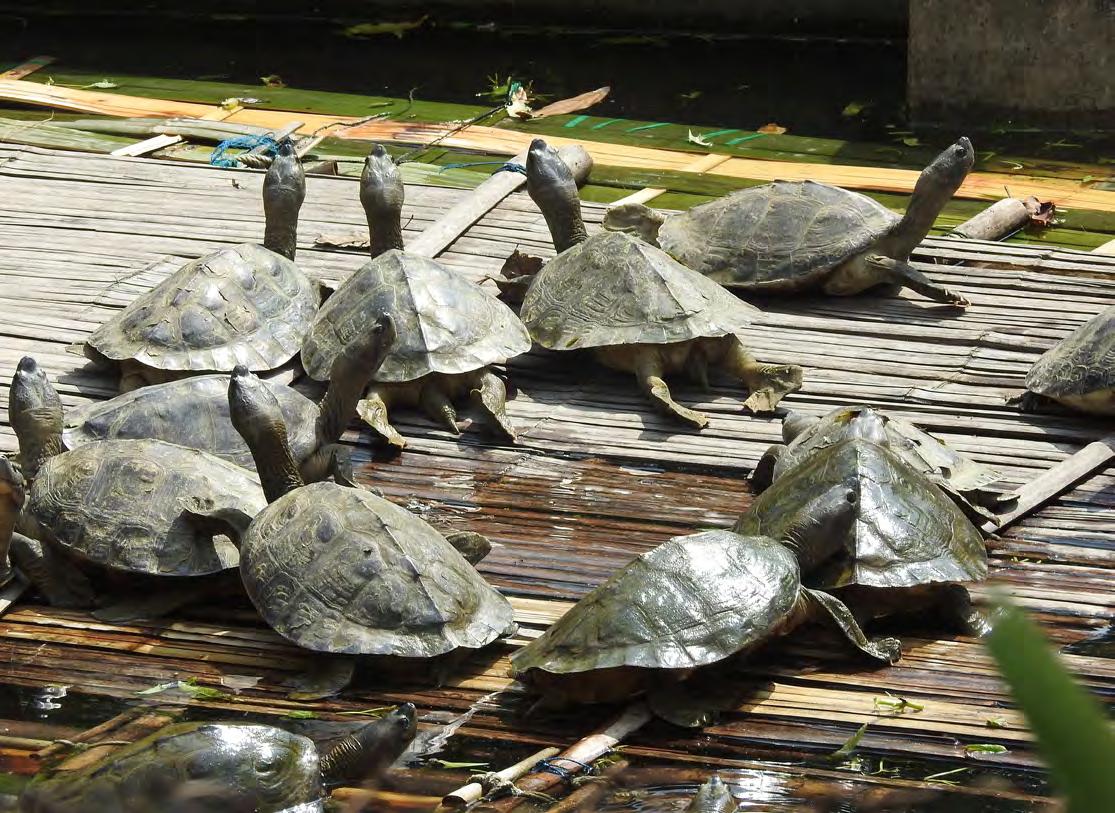
Since the early 2000s, the Turtle Survival Alliance (TSA), working in partnership with the Wildlife Conservation Society (WCS), has sought to check the seemingly inexorable decline of Myanmar’s turtles using a combination of in and ex situ programs focused on the most critically endangered species. From its modest beginnings in the early 2000s, the TSA/WCS program has
since grown into a conservation task force of almost 100 full and part-time personnel including village-based staff, beach wardens, community conservation volunteers, enforcement rangers, assurance colony caretakers, researchers, and managers. Stationed at far-flung locations across Myanmar, this assemblage of personnel works toward a common goal of safeguarding Myanmar’s
turtle diversity for future generations. With porous international borders, an entrenched network of illicit traffickers, subsistence harvesting by the agrarian poor, widespread habitat destruction, and a rapidly developing economy, turtle conservation in Myanmar is, without question, a daunting task. Nonetheless, the tide appears to be slowly turning. As Winston Churchill said in a speech
to parliament during the early days of World War II, “…this is not the end. It is not even the beginning of the end. But it is, perhaps, the end of the beginning.” Perhaps the past year (2017-18) was indeed the “end of the beginning” in our fight to save Myanmar’s turtles. Notable among the many promising developments is our continued success in restoring wild populations of Burmese Star Tortoises (Geochelone platynota), the great strides in ex and in situ conservation of the Burmese Roofed Turtle (Batagur trivittata), and the triaging of another major confiscation of Big-headed Turtles (Platysternon megacephalum).
The Burmese Star Tortoise is endemic to the dry zone of Myanmar, a desert-like region in the central part of the country where subsistence harvesting and habitat loss have long been factors in the decline of this species. Sadly the death knell for the Burmese Star Tortoise sounded in the late 1990s when this stunningly beautiful animal became avidly sought by the high-end international pet market. Within a decade, wholesale collecting had emptied the dry zone of its tortoises. By the mid-2000s, the Burmese Star Tortoise was ecologically extinct in the wild. Fortunately, however, ecological extinction failed to translate into biological extinction. Recognizing the few remaining wild tortoises could not be effectively protected, the Myanmar Forest Department working together with TSA and WCS, established assurance colonies at Lawkanandar, Minzontaung, and Shwe Settaw wildlife sanctuaries with the objective of producing offspring for headstarting and eventual restoration into the national protected area system.
A National Star Tortoise Action Plan we prepared with our governmental partners set forth the ambitious goal of restoring viable wild populations of Star Tortoises at every
protected area within the dry zone. Our strategy to achieve this objective is twofold: reintroduce captive bred and headstarted tortoises; then effectively protect restored populations through efficient law enforcement, a must considering the high-dollar value these beautiful tortoises continue to command in the illegal wildlife trade.
Minzontaung Wildlife Sanctuary (MWS) was selected for our first attempt in restoring a wild tortoise population using captive bred offspring from the assurance colonies. The reintroduction was preceded by an intense community awareness and education campaign that sought to “win the hearts and minds” of villagers living adjacent to the sanctuary. Modeled on pioneering efforts to restore Gopher Tortoise (Gopherus polyphemus) populations in the southeastern United States, we crafted a “soft-release” strategy for repatriating captive bred Star Tortoises into the wild. In brief, tortoises are held in 1-ha acclimation pens deep within the sanctuary before being released 12 months later. Based on what we learned by radio-tracking liberated tortoises, releases now occur at the height of the annual dry season (JanuaryFebruary) when tortoises are less apt to
wander. Post-release dispersal is a critical consideration given that MWS is surrounded by village agricultural fields where wandering tortoises are at risk from poachers. Releases took place in 2014, 2015, 2016, and again in 2018 and to date, 862 Star Tortoises have been liberated at MWS. In addition, numerous instances of successful nesting by reintroduced tortoises have been documented, a fact that bodes well for the future of this population. At present, another 300 tortoises are in acclimation pens awaiting release in February 2019.
Building on lessons learned at MWS, we launched a second, more ambitious reintroduction program in 2016 at Shwe Settaw Wildlife Sanctuary (SSWS), an expansive protected area that could ultimately support tens of thousands of wild Star Tortoises. Before releasing any tortoises at SSWS, it was first necessary to wrest control of the area from poachers and timber cutters, who had long enjoyed unfettered, albeit illegal, access to the sanctuary. As part of this effort, we recruited Community Conservation Volunteers (CCVs) from local villages, who assisted with field work and served as our eyes in nearby communities, ever
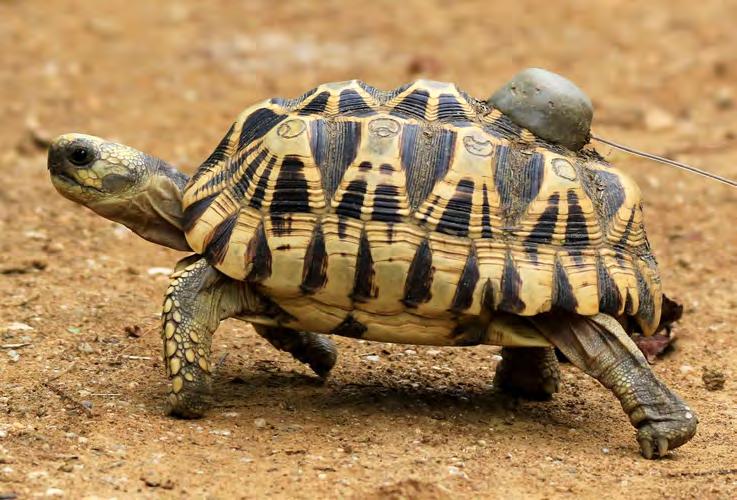
alert for information on poachers and their nefarious activities.
Using the proven reintroduction protocols we developed at MWS, three acclimation pens were built in SSWS in 2016 and stocked with 150 headstarted tortoises. After a year of residence, the tortoises were released into the surrounding forest where we continue to monitor their movements with radio telemetry. Survival has been high and most of the liberated tortoises quickly established a home range near the acclimation pens. During 2017, and again in 2018, we encountered hatchlings just out of the nest, confirming these reintroduced tortoises are now successfully reproducing.
Given the success of the first reintroduc-
tion at SSWS, we dramatically scaled-up our efforts in 2018. We combed all three assurance colonies, selecting 950 tortoises for release. The carapace of each tortoise was emblazoned with a set of unique identification numbers on one side and Buddhist iconography on the other; the latter designed to deter superstitious villagers who may be tempted to purloin a tortoise they chance upon in the forest. In January 2018, after a ceremony involving area villagers, government officials, community leaders, and Buddhist monks, the 950 tortoises were transferred to acclimation pens with release slated for mid-January 2019.
Complimenting these efforts, in late 2017 we initiated an experimental egg translocation program at MWS and SSWS, whereby
eggs produced by females in the assurance colonies are unearthed and reburied in the wild. Although widely used to restore populations of threatened birds, to our knowledge, egg translocation has never been attempted with any species of tortoise or freshwater turtle. In addition to being much less expensive than traditional headstarting, allowing eggs to hatch in the wild will subject young tortoises to a regime of natural selection that cannot be duplicated under captive conditions. Mortality among wild-born hatchlings will undoubtedly be high, but low juvenile survival is a typical life history trait of long-lived tortoises, and survivors are expected to be hardier, more robust, and better adapted for life in the wild. Furthermore, the natural loss of
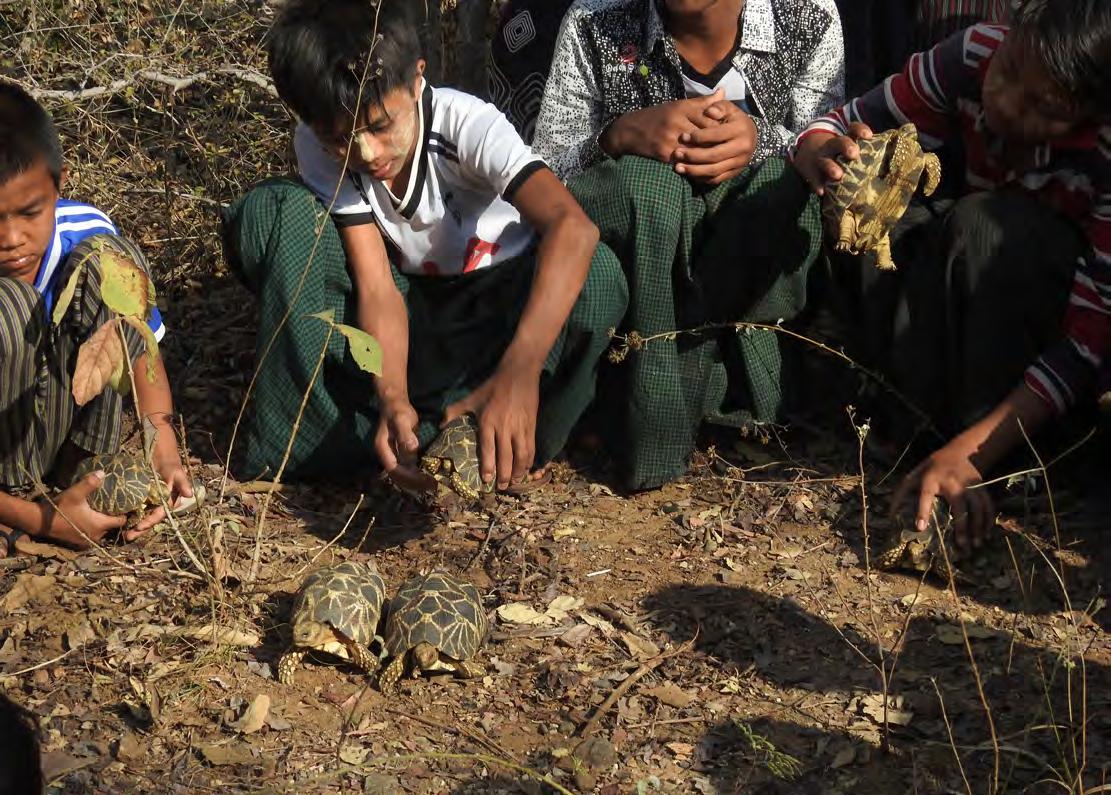
juvenile tortoises poses no risk to the captive population, which continues to increase at an annual rate of 30-35%. In the end, the results of our experimental program were mixed; with many nests at SSWS lost to flooding caused by unprecedented rainfall. In contrast, some nests at MWS experienced lethally high temperatures during the incubation period, although others hatched successfully. In light of these setbacks, translocation protocols are being revised prior to the 2018-19 nesting season.
The Burmese Roofed Turtle is endemic to the larger river systems of Myanmar, most notably the Ayeyarwady and Chindwin rivers. Historic accounts indicate these river turtles were once abundant, even assembling in “herds” to bask along sandbars in the Ayeyarwady Delta. Tragically, intensive sustained harvesting of the tasty eggs by riverside communities led to slow but inevitable population declines. The Burmese Roofed Turtle was feared extinct until 2001 when small remnant populations were “rediscovered” in the Dokhtawady and upper Chindwin rivers. In and ex situ conservation programs implemented at the last possible moment arrested the death spiral of the Roofed Turtle, although numbers remain perilously low and are but a fraction of historic levels.
Our efforts to restore the Burmese Roofed Turtle continue to make headway and remain critical for the continued survival of this species. The Mandalay Zoo houses an assurance colony founded with turtles rescued from pagoda ponds as well as others confiscated from fishermen. This is the only facility anywhere in the world that has succeeded in propagating Burmese Roofed Turtles in captivity. In 2017, small adjustments in husbandry protocols resulted in 91 hatchlings being produced at the zoo. 2018 proved to be yet another banner year, with

155 hatchlings emerging from two artificial nesting sandbanks at the zoo. These hatchlings are now being headstarted at the zoo and we hope to return them to the wild in the next five to seven years. Two additional assurance colonies in Myanmar consisting of almost 200 Burmese Roofed Turtles are expected to begin producing eggs in the next 1-2 years, and another group of 25 adults on loan to Wildlife Reserves Singapore will hopefully begin reproducing at about the same time.
Standing in marked contrast to the situation in captivity, the status of the only remaining wild population of Burmese Roofed Turtles remains tenuous at best, with fewer than 10 breeding adults surviving in the upper Chindwin River. Every year, we collect eggs from these turtles and head start the offspring at Basecamp Batagur, a TSA/WCS facility in Limpha Village along the Chindwin River. A trial release of 60 headstarted Roofed Turtles in 2015 yielded mixed results when many of the transmitters attached to turtles failed, turtles dispersed long distances up and down the river, and some
falling victim to monofilament fishing nets. Although none of the reintroduced turtles can currently be accounted for, our efforts nonetheless seem to have yielded positive results. In the year following reintroduction (2016), one of three clutches excavated from nesting sandbanks near Limpha Village proved fertile. In 2017, all three clutches we recovered consisted of fertile eggs (only infertile clutches were produced in 2014 and 2015, perhaps because the few surviving males had perished). Even more exciting, one of these clutches consisted of a small number of eggs which led us to speculate that a young female released in 2015 had returned to nest. By early June, 68 Roofed Turtles had successfully hatched, and combined with record reproduction at the Mandalay Zoo, made the 2017-18 breeding season the most productive since recovery efforts were launched in 2006.
In March 2018, a second group of 30 headstarted turtles were plucked from the grow-out ponds at Basecamp Batagur and transferred to an acclimation pen in the Chindwin River near Limpha Village. Work-
ing under the technical guidance of Sitha Som (WCS Cambodia Program), we attached sonic transmitters to 10 of the turtles just a few days prior to the transfer. Our plan was to hold the turtles in the pen for about 30 days before releasing the group, but even the best laid plans of mice and men go astray, and this one was no exception –after only a few days in the pen the turtles had escaped! All was not lost though, as we immediately began tracking the escapees using the sonic telemetry apparatus. Early results indicate the turtles took up residence in the deep pools near Limpha Village. Whether the turtles will remain in the release area when wet season floodwaters surge downstream later this year remains an open question.
One quandary that continues to perplex us is the case of “Lonely Ma Gyi” (Lonely Big Female), a solitary female turtle dwelling far up the Chindwin River near Sein Naing Village that produces a clutch of infertile eggs every year, presumably because a suitable male consort is nowhere to be had. Given the inbred status of the Roofed Turtle population (both in the wild and captivity),
the inherent genetic value of Lonely Ma Gyi is obvious. In 2018, Lonely Ma Gyi was joined by a second female, possibly one of the turtles released in 2015, that somehow managed to find her way upstream after running a gauntlet of fishing nets in the 40 km of river between Sein Naing and Limpha villages.
Like her partner, this second female also produced a clutch of infertile eggs. In hopes of capturing the genes from both females, we are now undertaking the reintroduction of 20 captive-bred males into the Chindwin River at Sein Naing Village. In a variant of our soft-release strategy, the males are being held in a floating acclimation pen for about two months and will be released in late November, just before, we assume, when mating naturally occurs. We intend to incorporate any offspring produced by these females into the captive breeding program in order to ensure their genetic representation in future generations.
Finally, hoping to reduce incidental capture of Roofed Turtles in fishing gear – the leading cause of mortality among reintroduced

turtles – we launched a community-based fisheries project in late 2017. Working together with local fishers in 39 villages along the Chindwin River, we are currently delineating critical habitat for both fisheries and turtles, and developing guidelines for protecting these areas. These mutually agreed upon guidelines are designed to protect turtles while, at the same time, ensuring the sustainability of local fisheries. Given the recent nesting success among wild turtles on the Chindwin River, booming production of hatchlings at the Mandalay Zoo, and efforts to reduce fishing-related mortality, the future prospects of the Burmese Roofed Turtle are much brighter than we would have dared imagine just a few years ago.
The Big-headed Turtle is fast rising to prominence in the traffic of illegal wildlife emanating from Myanmar The sudden high demand stems in part from commercialscale farming plans by turtle breeders in southern China. In dire need of mature breeding stock, turtle farmers are now paying top dollar for adult Big-headed Turtles and, as a consequence, this species appears to be safe nowhere within its range. Even well-protected national parks in Thailand have suffered repeated incursions by organized gangs of poachers bent on capitalizing on the high demand for this species.
The situation was brought home to us in late 2016 when authorities chanced upon almost 1000 Big-headed Turtles in the compound of a shadowy Hong Kong-based wildlife trafficker operating in southern Myanmar on the Thai-Myanmar border The turtles were confiscated by the Myanmar Forest Department and turned over to the TSA/ WCS Turtle Rescue Center near Maymyo. Unfortunately, the vast majority were neardeath having suffered months of abuse, starvation, and uncaring neglect at the hands of the traffickers.
Despite weeks of heroic medical care by an
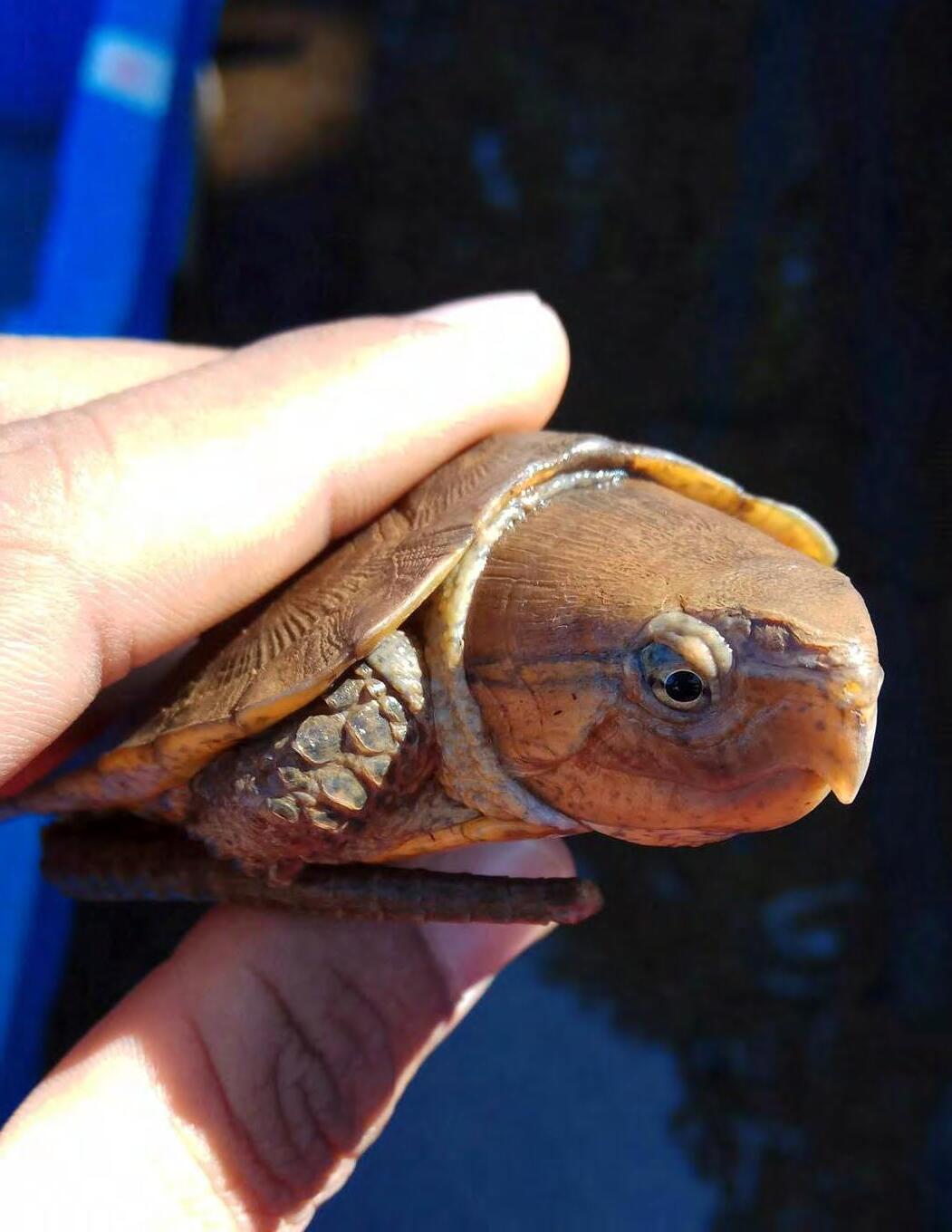
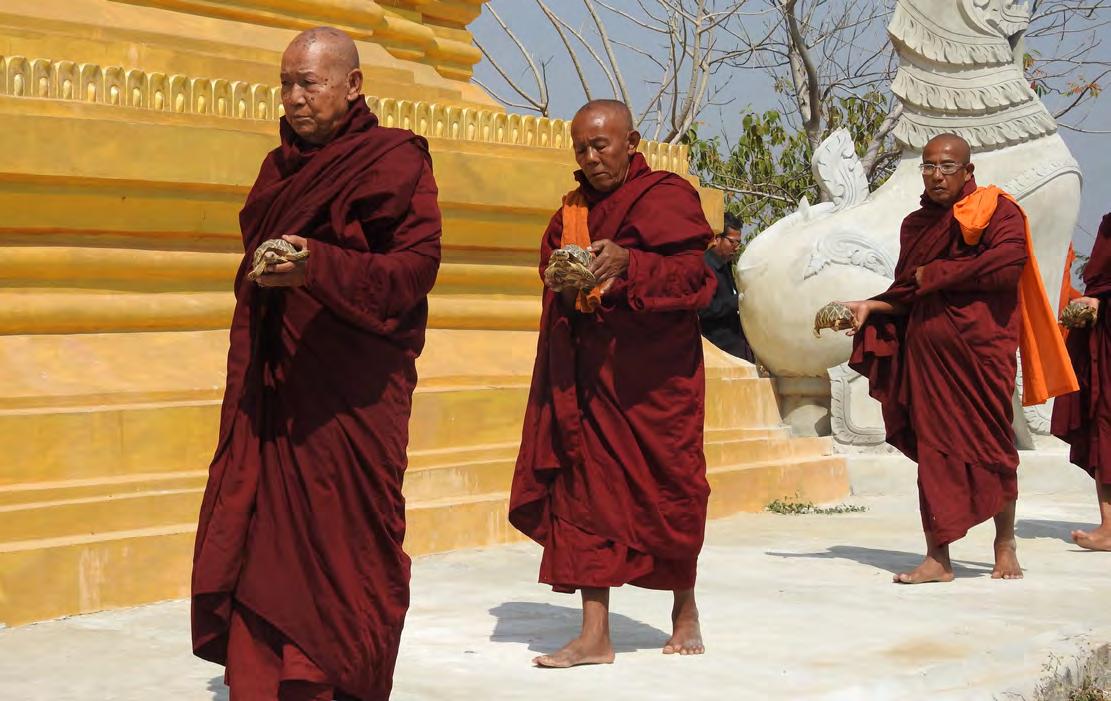
international team of wildlife veterinarians, most of the turtles eventually succumbed. This scenario was repeated in late 2017 when 385 Big-headed Turtles were discovered at a compound in Tachileick, a lawless town on the Myanmar-Thai border with a well-deserved reputation as a smuggler’s haven Customs authorities immediately contacted TSA/WCS and we transported the turtles to the TRC and another weekslong rescue operation began. This group proved to be in much better condition and 359 of the 385 confiscated turtles survive to this day
Housing the surviving Big-headed Turtles from both confiscations (almost 500 turtles) has strained our resources to the breaking point, owing to the exacting husbandry requirements of this cantankerous species, which, except when breeding, refuse to tolerate the presence of conspecifics. It was
thus with great relief that in early 2018, we secured funding to construct a state-of-theart facility specifically tailored for Bigheaded Turtles. The design of this facility will draw heavily on the expertise of husbandrymen from the TSA’s Turtle Survival Center (South Carolina) and the WCS-Prospect Park Zoo (Brooklyn, New York), both among the few facilities worldwide able to successfully maintain and consistently propagate Big-headed Turtles. Our plan is to incorporate 100 Big-headed Turtles into the nascent assurance colony and repatriate the remaining turtles into protected areas in southern and eastern Myanmar. Although methodologies for successfully repatriating Big-headed Turtles into the wild currently do not exist, we recently secured additional funding to conduct a pilot study to test different soft-release strategies for this species. Contingent on the outcome of this study, we
hope to begin returning the bulk of our Bigheaded Turtles to the wild in early 2020.
Acknowledgements: For their steadfast and generous support of the TSA/WCS Myanmar Turtle Conservation Program, we wish to recognize the following donors: Andrew Sabin and the Sabin Family Foundation, Andrew Walde, Critical Ecosystem Partnership Fund, Paul and Linda Gould, Helmsley Charitable Trust, Holohil Systems, Ltd., Panaphil Foundation, Debbie Behler, Turtle Conservation Fund, and Wildlife Conservation Society.
Contact: Steven G. Platt and Kalyar Platt, Turtle Survival Alliance and Wildlife Conservation Society, No. 12, Nanrattaw St., Kamayut Township, Yangon, Union of Myanmar [sgplatt@gmail.com; kalyarplatt@gmail.com]
The Satucita Foundation, a TSA partner, has implemented conservation activities for the critically endangered Painted Terrapin (Batagur borneoensis) on the island of Sumatra, Indonesia since 2011. Nest patrols, egg-clutch translocations, hatchling and head start release programs, population monitoring, community empowerment and outreach, and field research are the foundations for our conservation activities. To date, a total of 1,637 hatchling and juvenile terrapins, varying in age from neonate to 14 months old, have been released into the rivers and estuaries of the District of Aceh Tamiang.
NEST PATROL AND MONITORING
Annual nest patrols are the cornerstone for our initiative to conserve Painted Terrapins on the island of Sumatra. This activity is conducted every nesting season, from late November through March or April, to safeguard eggs through translocation. Threats that would otherwise result in the partial or total loss of annual population recruitment, including predation from wild pig (Sus scrofa), beach refuse, and unsustainable harvesting, have sharply decreased since we began conducting this activity several years ago.
This past year’s nest patrols in Aceh Tamiang were carried out from December 2017 to March 2018. To completely canvas the nesting beaches, we work together with staff members of the Department of Natural Resources and Ecosystem Conservation of the Ministry of Forestry (BKSDA) - Aceh, staff members of the Aceh Tamiang Fisheries Office, and local villagers. Nest locating is a considerable endeavor. Each night for 120 patrol nights, the teams conduct two patrols
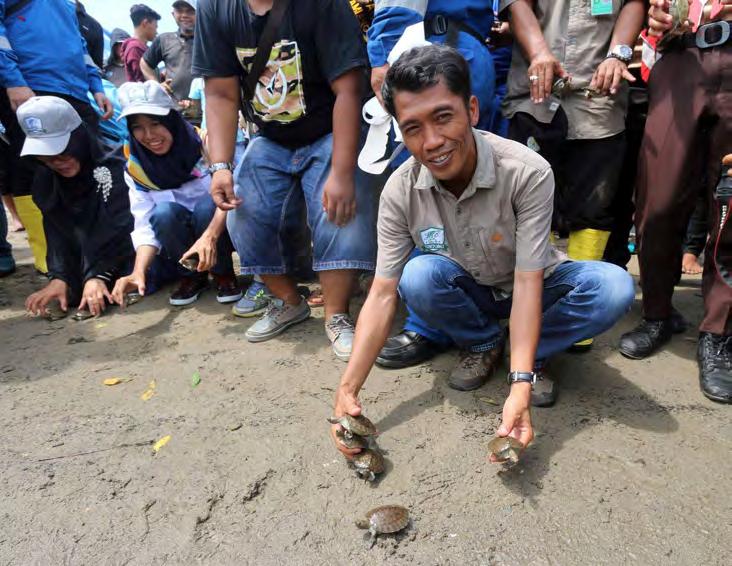
at 2000 hours and 0400 hours. Over the course of 6 hours, the team canvases approximately 10.4 km of beach for a seasonal total of 1,248 km walked over 720 search hours. Over the four-month duration of patrols, we successfully located and secured 28 nests containing 460 eggs from two beaches.
Of the 460 eggs translocated and incubated by us at the Satucita Foundation village hatchery, 343 eggs (75%) successfully hatched, while 4 nests exhibited total failure. One hatchling from each of the 24 successful clutches will be head started at the Painted Terrapin Information Center as per our long-term objective. The remaining 319 were released on 19 August 2018 at their natal beach. The release ceremony was attended by government officials, our local partners, program supporters, and villagers.
In addition to our annual nest patrols in Aceh Tamiang, this year we began nest patrols in collaboration with the BKSDA Utara Region II Stabat in the District of Langkat, North Sumatra. These patrols were enacted after two adult female terrapins were accidentally caught by fishing nets in the district. The two females were successfully PIT tagged, had morphometric data taken, and released by Satucita Foundation and BKSDA staff. These adult female findings not only represented the Satucita Foundation’s first records of the species in North Sumatra, but were a good indication that a reproductive population exists in the province.
Concluding on 28 January 2018, patrols on the beaches of Langkat yielded the translocation of only one viable nest containing 24 eggs despite
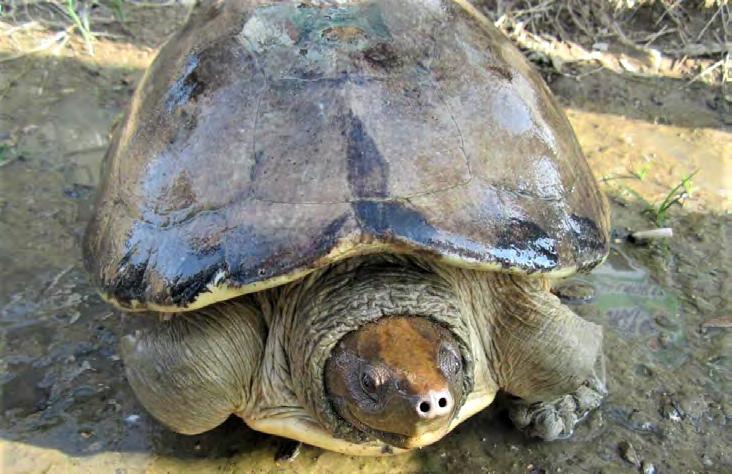
5 nests being located. The other nests were found to have been depredated or exhumed by humans. Incubated at a hatchery in Langkat, this single clutch of eggs unfortunately did not successfully hatch on account of their depredation by ants in the artificial nest. Although this first year of nest translocations in Langkat was met with limited success, we plan to patrol its beaches again next nesting season.
Poverty is a general phenomenon commonly observed around the habitats of threatened species in Sumatra, including that of the Painted Terrapin. The Satucita Foundation believes that to recover wild populations local communities must be empowered through the attainment of knowledge, skills, and sustainable activities. This will provide them the abil-

ity to utilize natural resources in a sustainable manner should a conservation organization or program exit from that location. To achieve that vision, the Painted Terrapin Information Centre was completed and inaugurated in October of 2017. The Centre was built by PT Pertamina, a state-owned oil and natural gas corporation, is owned by the village government of Pusung Kapal, and managed by a community group approved by the village government. Satucita Foundation supervises the management of the facility and community group, and also aids the community group in developing educational tourism related to Painted Terrapin and mangrove forest conservation. As of 15 September 2018, approximately 800 hundred visitors have toured the facility — most of them students and scouts from Subdistrict Seruway, Aceh. Although revenue generated by these visitors for the community group is still small, it’s a good start!
To increase local knowledge capacity for ecotourism, a member of the community group visited well-known ecotourism enterprises in Tangkahan and Lubuk Kertang. About 20 years ago, illegal logging was rampant in both locations. Now, these places have become
destinations for ecotourism activities. In three days of visitation, the members of the community group learned the history of, practical skills for, and experiences from their transition from a culture of illegal logging to one of ecotourism. Additionally, we have monthly meetings with the community group to evaluate complications in developing tourism, and how to solve them. Furthermore, beach cleaning and mangrove and pine tree plantings were performed this year. All these endeavors are taken in order to build a foundation for developing villagers’ economic income and strengthen long-term Painted Terrapin conservation. However, we are aware that these activities are centered around the assumption that community empowerment must be based on terrapin and wildlife conservation. Therefore, proper criteria and guidelines must be prepared carefully, so as not to bring negative impacts upon the terrapins.
The Satucita Foundation is currently conducting two research initiatives for the Painted Terrapin: one, a fecal analysis study to determine natural diet; and the second, an analysis of genetic variation within the wild population. For the latter study, DNA was collected from 30 hatchlings representing 30 unique nests. Results from this genetic analysis demonstrate that the regional population is at risk of experiencing a long term bottleneck. Improving knowledge of our species through larger sample sizes, discovery of other wild populations, further genetic analysis, and establishing assurance colonies are future priorities for the Satucita Foundation’s Painted Terrapin conservation efforts.
Acknowledgements: We would like to thank Turtle Survival Alliance, Houston Zoo, Chester Zoo, Taronga Conservation Society, and Pertamina EP Field Rantau.
Contact: Joko Guntoro, Satucita Foundation, Dusun Mawar, Bukit Rata, Kejuruan Muda, Aceh Tamiang, Aceh, Indonesia 24477. [jokoguntoro@gmail.com]
Rich in herpetofaunal diversity, the Indonesian island of Sulawesi is home to two endemic chelonians, the critically endangered Sulawesi Forest Turtle (Leucocephalon yuwonoi) and the endangered Forsten’s Tortoise (Indotestudo forstenii). As there has been little previous research or conservation efforts focused on these species, their population status is based primarily on anecdotal information. Subject to the combined one-two punch of severe habitat destruction and collection for the pet and bushmeat trades, these species could soon face extinction in the wild. Furthermore, neither species is listed as protected within Indonesia, thus adding to the urgency of this project.
We have partnered with Bogor Agricultural University (IPB), West Java and Tadulako University (UNTAD), Central Sulawesi to conduct population surveys to determine both species’ distribution. This will allow us to work toward ensuring their long-term survivability as we gain a better grasp of needed conservation initiatives to employ (i.e. uplisted IUCN statuses and CITES listings, stricter import/export laws, and increased local protection) and what is needed to advocate for these changes. Survey results will initiate long-term, community-based monitoring programs. Radio-tracking will

their conservation needs, and the necessary husbandry requirements for the development of a captive breeding program. Concurrently, with our partners from UNTAD, we are developing an in situ captive breeding program, initially focusing on I. forstenii. This program will not only provide a platform for education and outreach, plus the opportunity to study a population of released turtles as an on-campus research and training project, but will also allow for the development of assurance colonies for future reintroduction programs.
provide valuable information on home-range, habitat preferences, foraging, reproductive, and nesting behaviors. This information will yield a better understanding of the requirements necessary for successful captive breeding, and assist in identifying suitable habitat for their future survival in the wild.
During population surveys conducted in early 2018, we identified a population of L. yuwonoi from which a subset of animals will be affixed with transmitters. Data collected and information attained will create a better overall assessment of this severely understudied species,
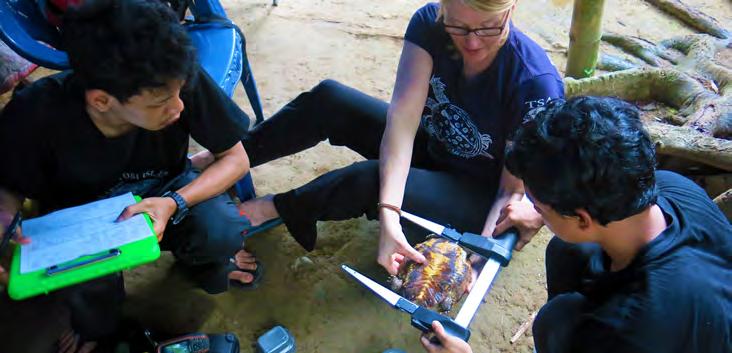
Through citizen science and capacity building, students and residents are trained and empowered to participate in field work and the breeding program, thus establishing more community awareness. In turn, educational programs are implemented at local universities, schools, and in communities to promote a positive perception toward the conservation of these species and their habitats. Combined findings will contribute to the long-term goals of building much-needed assurance colonies and identifying parcels of land that might be purchased and protected to become sustainable preserves for these and other species.
Acknowledgements: We would like to thank the Chicago Zoological Society/Chicago Board of Trade Species Conservation Fund, Cleveland Metroparks Zoo, Columbus Zoo and Aquarium, Global Wildlife Conservation, Holohil, Mohamed bin Zayed Species Conservation Fund, Oklahoma City Zoo and Botanical Garden, Phoenix Zoo, Riverbanks Zoo and Garden, Turtle Conservation Fund, and Wildlife Reserves Singapore for supporting this project.
Contact: Christine Light, Sulawesi Project Coordinator, Turtle Survival Alliance, 1030 Jenkins Rd. Ste. D, Charleston, SC, USA 29407 [clight@turtlesurvival.org]
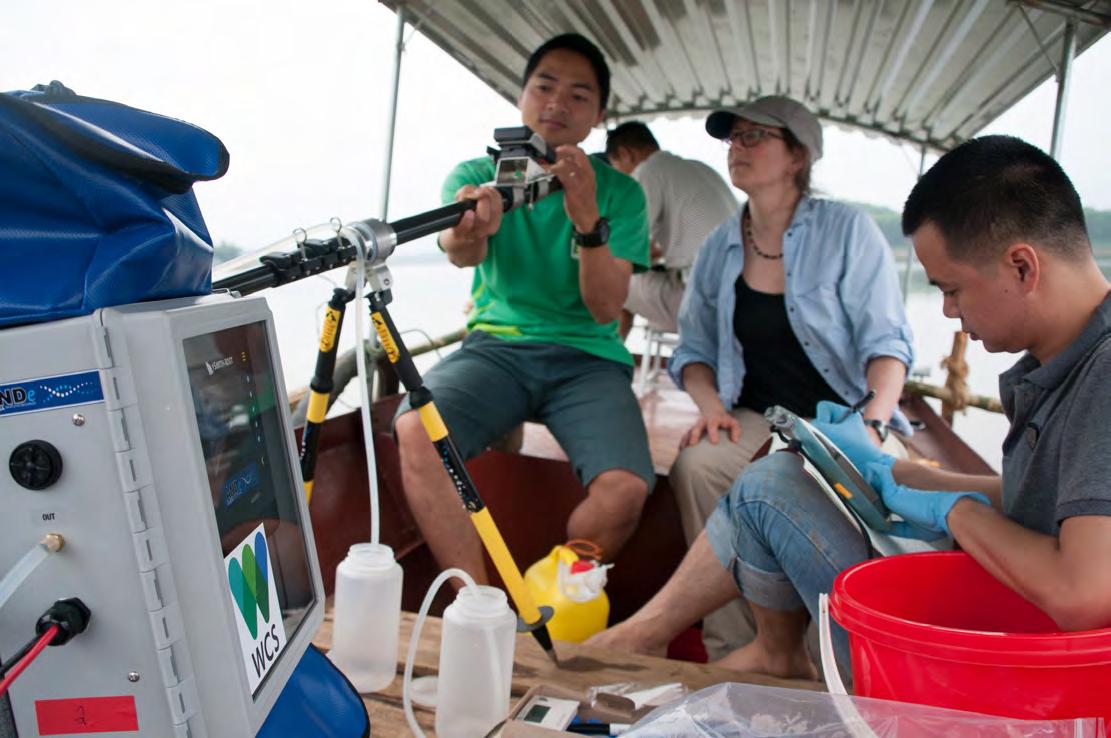
2016 brought the plight of the Yangtze Giant Softshell Turtle (Rafetus swinhoei) to international attention with the passing of the individual that lived in Hoan Kiem Lake in Hanoi, Vietnam. This animal, known affectionately as Cụ Rùa, meaning Great Grandfather Turtle in the local dialect, was considered sacred by the Vietnamese due to a 15th century legend claiming the turtle played a part in establishing Vietnam’s in-
dependence. The passing of this animal had dropped four known specimens of the species to three, making it the rarest of the rare. However, the legend lives on, and is aiding the search for more individuals. To this end, the body of the Hoan Kiem Turtle provided tissue samples that were instrumental in allowing genetic labs to start investigating the use of Environmental DNA (eDNA) to help search for new specimens.
For the past 15 years, The Asian Turtle Program (ATP) of Indo Myanmar Conservation (IMC) has undertaken interview surveys and identified sites where the Yangtze Giant Softshell Turtle has historically occurred and potentially might still survive. At some sites, intensive periods of observation have been used to try and confirm new animals. This resulted in finding the R. swinhoei in Dong Mo Lake in 2007. However, this
method is time consuming and the absence of a visual sighting does not mean an animal is not present. Thus, these sites remain on the list of potential sites. In 2016, a collaboration was formed to use eDNA in the search for R. swinhoei. That team consisted of Dr. Caren Goldberg from the Washington State University. Dr. Goldberg is a pioneer of the technique who, along with the Turtle Survival Alliance (TSA), has supported a team from the ATP to collect samples for analysis from a number of priority lakes. Lakes were chosen from the list created that had information on possible surviving R. swinhoei, using Dong Mo as a control lake with a confirmed individual of the species. Collection of samples is a time sensitive and laborious process that involves using hand pumps to pull the water samples in as well as papers that need drying, handling, and careful processing, all of which is difficult in the humidity.
One focus site for the eDNA sampling was Xuan Khanh Lake, not far from Dong Mo Lake. This lake first came to our attention in 2012 when fishermen reported trying to catch a very large turtle. A low resolution photograph taken with a local’s phone could have been a large turtle, but the image was too grainy to be sure. Intensive observations by the ATP team at the time could not confirm the animal, but a local counterpart was hired to provide updates from the site. Fast forward to 2016, and fresh information was reported from the lake. After months of observation, the team was able, on a number of occasions, to photograph a large softshell turtle. Although obviously a large softshell turtle, the images still could not provide a clear identification, but the team’s experience at Dong Mo had them convinced it was another Rafetus. This animal’s confirmation as Rafetus by use of eDNA, brought the known population back up to four individuals.
The success of the Rafetus identification spurred further eDNA research. The Wildlife Conservation Society (WCS) Molecular
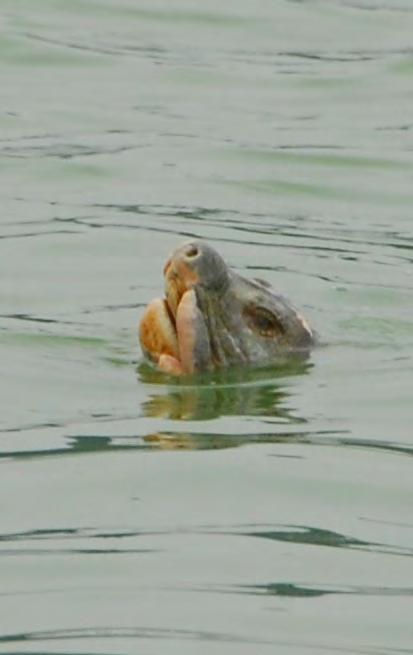
Program, based at the Bronx Zoo, has been working for the past two years to make testing of water samples more field-friendly through the development of portable DNA test kits which are used to identify R. swinhoei in water samples. This kit utilizes a purpose-built backpack containing a highly efficient peristaltic pump to filter water samples at the lake’s edge and capture eDNA on the spot—greatly reducing the time for sample collection and filtration.
Key to the new portable system is a mobile smartphone-driven handheld PCR machine (a DNA amplifier) that analyzes DNA data using the smartphone’s built in camera and app. Results are uploaded through cloud technology via Wi-Fi, thereby providing almost instantaneous results to the team.
In May and June of 2018, we hosted a training workshop and field testing of the new eDNA equipment. Participants included staff from the Wildlife Conservation Society - Vietnam Program, Asian Turtle Program (ATP) of Indo Myanmar Conserva-
tion (IMC), and Centre for Resources and Environmental Studies (CRES), of Hanoi University of Science. The CRES has a laboratory, PCR machines, and staff who will be involved in future R. swinhoei eDNA activities. Results from the larger lakes have been challenging with negative results thus far from our control locations, Dong Mo and Xuan Khanh Lakes, where an individual of Rafetus swinhoei is regularly observed and photographed. Important factors that likely affect the results include dilution of eDNA in the larger lakes (Dong Mo has a water capacity of over 110,000,000m3) and, at certain times of the year, high water temperatures that are known to affect the degradation or half-life of eDNA. The plan now is to investigate and optimize the sampling strategy, try sampling during different seasons (temperatures) to identify the optimal season of sampling, whilst simultaneously continuing with monitoring and other survey methods. We are excited to have this new tool in our turtle survey field kit, and look forward to unleashing its potential in the fight for the Yangtze Giant Softshell Turtle.
Acknowledgements: 1 - Asian Turtle Program (ATP) of Indo Myanmar Conservation (IMC); 2 - Wildlife Conservation Society (WCS); 3 - Turtle Survival Alliance (TSA; 4 - Centre for Environmental Studies of the Vietnam National University (CRES). This work received support from the Mohammad Bin Zayed Species Conservation Fund, Critical Ecosystem Partnership Fund, Turtle Conservation Fund, British Chelonian Group, Ocean Park Conservation Fund, the G. Unger Vetlesen Foundation, and anonymous donor support.
Contact: Timothy McCormack, Asian Turtle Program of Indo-Myanmar Conservation, 1806, CT1 - C14 Bac Ha Building, To Huu Street, Nam Tu Liem District, Hanoi, Vietnam [tmccormack@asianturtleprogram.org]
Daniel Gaillard, Haitao Shi, Liu Lin, Xiao Fanrong, Jeffrey Dawson, Shiping Gong
China has played a major role in the global decline of turtle populations. Previously, food and medicine markets were responsible for a massive trade in wild-caught turtles, seriously impacting both China’s native species as well as turtles abroad. While the demand for these products is now largely supplied by farm-raised turtles, tens of thousands of wild-caught turtles continue to be imported (often smuggled illegally) or captured in China each year. Today, a booming interest in pet turtles within China is the primary driver of trade. This hobby has spawned an obsession to obtain turtles, particularly rare or unusual species, from countries across the world. At the same time, however, conservation awareness is increasing in China. As a result, now is the perfect time to begin a concerted effort to educate the public about turtle conservation and initiate projects within China to mitigate the effects of the last several decades on turtle populations.
For a conservation program to be successful, local partners are essential. In China, we have formed collaborations with Hainan Normal University and the Guangdong Institute of Applied Biological Resources, two organizations with extensive experience in Chinese turtle research and conservation. These partnerships have been instrumental in enabling us to conduct field work on rare, native turtles. Field and village surveys in eastern and southern China have identified extant populations for 10 species, along with providing insights into their life histories and historical ranges. Moreover, we have learned of the broad distribution of Red-eared Sliders (Trachemys scripta elegans) in China and recent genetic work
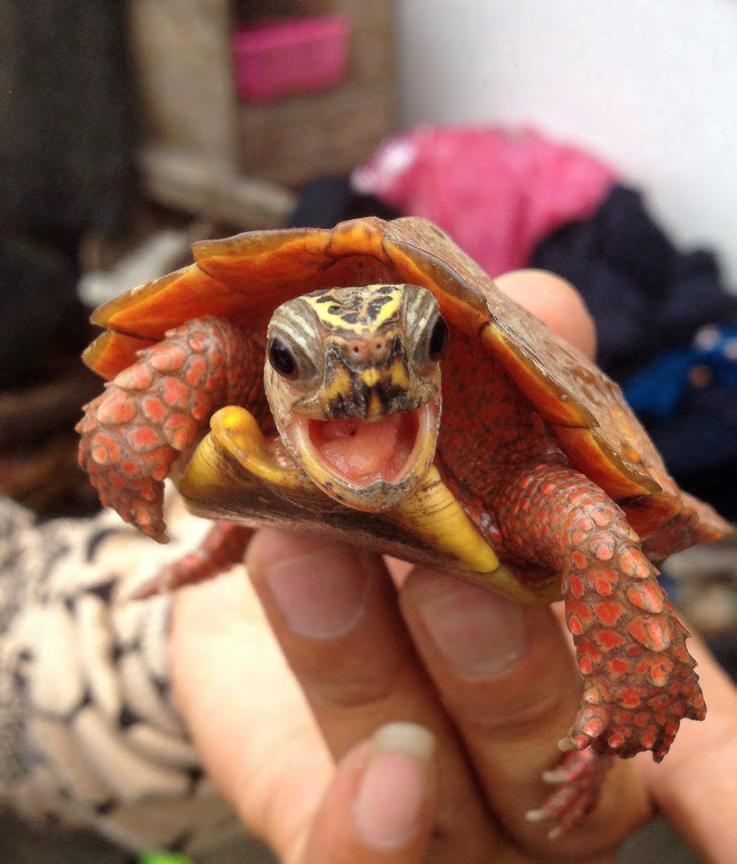
has shown the erosion of genetic diversity in Chinese Softshell Turtles (Pelodiscus sinensis) due to farming of conspecifics. A future challenge for conservation, and the Chinese food market, will be to promote and sell purebred, pricier lineages of P. sinensis and related species. If this is successful, it will
contribute significantly to the conservation of these species and their genetic diversity.
In addition to field and lab research, our efforts include the conservation breeding of several native species. Big-Headed Turtles (Platysternon megacephalum) and Beal’s Eyed Turtles (Sacalia bealei) have been
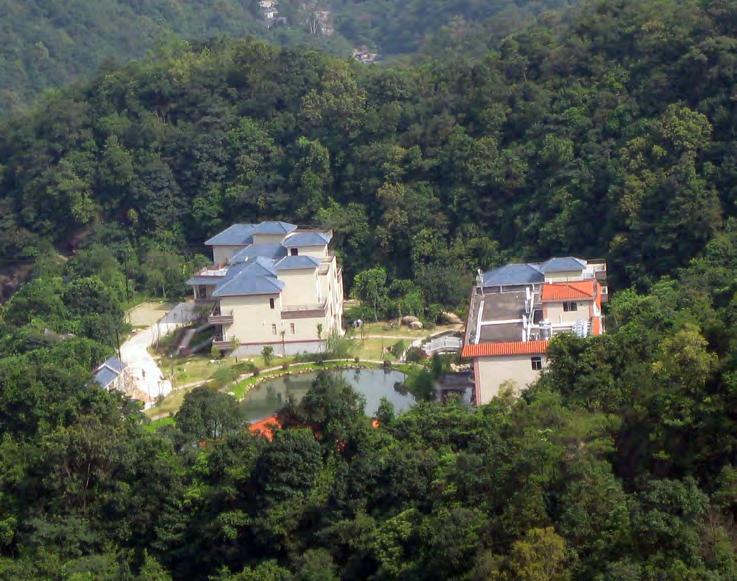
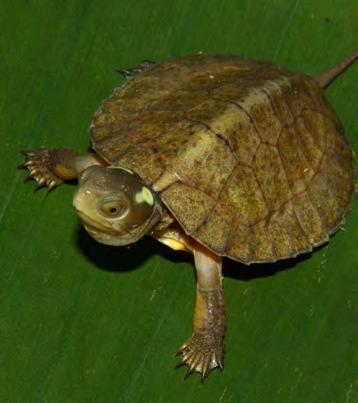
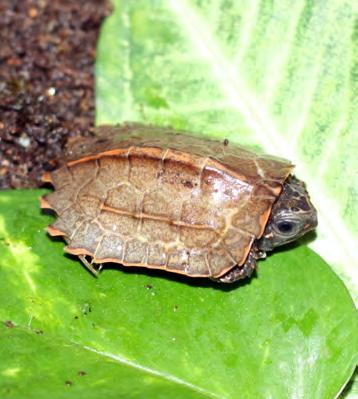
nine native species and one non-native species, the Southeast Asian Box Turtle (Cuora amboinensis). Information from these studies will be useful for pinpointing the geographic origins of farm and trade animals, managing captive populations in both China and abroad, and potentially identifying pure genetic stock for future conservation breeding facilities. Comprehensive ecological studies on G. spengleri are under way at multiple field sites in China. This work will provide new information on the preferred microhabitats, microclimate, and movement patterns of this species. In a nature reserve on Hainan Island, P. megacephalum is currently being studied using radio telemetry and observance of preferred microhabitat use. This project will also include long term monitoring to estimate the population size. In the future, we hope to continue to expand our work to additional threatened or less studied turtles throughout China, including more focus on species in the central and western regions, areas that have been historically underrepresented in field research.
Acknowledgements: The Mohamed bin Zayed Species Conservation Fund, The Turtle Conservation Fund, National Natural Science Foundation of China for their support, and Jichao Wang, Yan Ge, Dainan Cao, Torsten Blanck, Melita Vamberger, Markus Auer, Peter Praschag, Uwe Fritz, Huai-Qing Chen, Yichao Zeng, and Shu-Jin Luo for their contributions to these projects and review.
successfully bred at a research station of the Guangdong Institute of Applied Biological Resources. In 2018, the first successful hatchling occurred from an assurance colony of Hainan-locality Black-breasted Leaf Turtles (Geoemyda spengleri) at Hainan Normal University, utilizing expertise from the Saint Louis Zoo. In addition to G. spengleri, Hain-
an-locality Four-eyed Turtles (S. quadriocellata) have successfully bred at the university for several years and efforts are currently underway to breed Hainan-locality Indochinese Box Turtles (Cuora galbinifrons) and Keeled Box Turtles (Cuora mouhotii).
Recently, we began evaluating the phylogeographic and phylogenetic structure of
Contact: Daniel Gaillard, Liu Lin, Xiao Fanrong, and Haitao Shi, College of Life Sciences, Hainan Normal University, Haikou, China, 571158 [dgaillrd@gmail. com; kylelinliu@163.com; xiao71815@163. com; haitao-shi@263.net]; Jeffrey Dawson, Charles H. Hoessle Herpetarium, Saint Louis Zoo, MO, USA, 63110 [jdawson@stlzoo.org]; Shiping Gong, Guangdong Institute of Applied Biological Resources, Guangzhou 510260, China, [gsp621@163.com]
The critically endangered Central American River Turtle (Dermatemys mawii), aka Hicatee, is literally being eaten to extinction across its limited range. The lone surviving representative of the family Dermatemydidae, the Hicatee represents a unique evolutionary lineage dating back to the age of the dinosaurs.
Classified as Critically Endangered (facing an extremely high risk of extinction) by the International Union for Conservation of Nature (IUCN), Dermatemydidae is considered the most endangered turtle family in the world. The newest edition of the international report, “Turtles in Trouble: The World’s Most Endangered Tortoises and Freshwater Turtles – 2018,” features the Hicatee as one of the Top 25 most endangered turtle species facing extinction. For this reason, the Hicatee Conservation and Research Center (HCRC) was created at the Belize Foundation for Research and Environmental Education (BFREE) Field Station in Belize. The HCRC currently operates with approval and support of the Belize Fisheries Department, with the express purpose of investigating the reproductive biology of D. mawii, and the goal of building large assurance colonies to aid in reintroductions and ultimately save the species from extinction.
This year has been the most productive year to date for the HCRC, with 179 hatchlings produced from 17 clutches totaling 192 eggs. Eggs were laid into the edges of ponds at the captive breeding facility from November 2017 through February 2018 and were artificially incubated in ambient temperatures at the BFREE Field Station lab. The first hatchling
Heather Barrett and Jacob Marlin
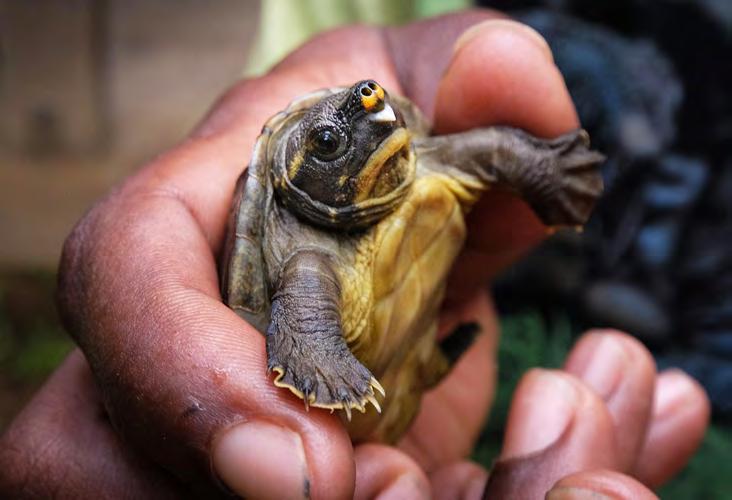
emerged on 4 June 2018, soon followed by nine more. In following weeks, the remaining eggs hatched, bringing the total population of turtles at the HCRC to nearly 300.
Reproductive success has been high at the HCRC. Since 2015, a total of 282 eggs have hatched, demonstrating a greater than 85% hatch rate. That success has not been without its challenges. Progress slowed substantially last autumn, when over 35% of the 2017 hatchlings suffered a quick and alarming die-off. Wart-like skin lesions were identified in turtles that suddenly lost weight, became lethargic, and one-by-one began to die. Low temperatures and water quality were investigated as possible contributing factors. Deceased turtles were transferred to the Belize Wildlife and Referral Clinic (BWRC) for necropsy. Liver failure was identified in the necropsies. However, histology is needed
to better determine the cause of death. Additional samples are being held by Dr. PaquetDurand at the BWRC while awaiting CITES permitting for import to the U.S. Turtles on the brink of death were also transferred to the BWRC for life-saving care in January 2018. Since that time, the turtles at the HCRC and the BWRC have improved greatly and are monitored closely for evidence of continued health issues.
Staff at the HCRC participated in several professional development opportunities this year. Elliott Jacobson, DVM, PhD, DACZM, Professor Emeritus of Zoological Medicine at University of Florida, visited BFREE and the HCRC to provide advice on animal husbandry, assess the status of turtles recovering from
previous illness, meet with a local wildlife veterinarian on the project, and offer training to HCRC staff. During his week-long visit, he participated in the autumn health assessment, gave a series of lectures on animal husbandry and zoological medicine, took blood and tissue samples, and performed a necropsy on a recently deceased turtle. Dr. Jacobson’s many decades of experience in reptile medicine is invaluable as the project continues to expand with a growing numbers of turtles on site and the likelihood of release in the near future.
Keepers Thomas Pop and Jaren Serano each spent one week at the BWRC training under the guidance of Wildlife Veterinarian, Dr. Isabelle Paquet-Durand. The BWRC has been caring for 16 Hicatee turtles that showed rapid health decline at the HCRC in December and January. Dr. Isabelle is the chief wildlife veterinarian on the project and continues to advise and provide first responder care to any turtles that require clinical diagnosis.
From the HCRC’s inception, BFREE and TSA recognized the need for a strong and structured awareness program. This awareness campaign has a two-part goal: to ensure that turtles bred in captivity can be safely released without fear of immediate hunting, and to help alleviate pressures on wild populations.
Using the message, “Let’s make the Hicatee our National Reptile,” materials and events were created for the second annual Hicatee Awareness Month in Belize. The goal of these efforts is to raise the turtle’s public status and set the stage for national pride of this rare and unique species.
During October, over 100 packets filled with educational materials were distributed to pre-schools and primary schools in the Cayo and Belize Districts. These districts were targeted specifically because they contain valuable Hicatee habitat that continues to see unsustainable harvest. Packet materials in-
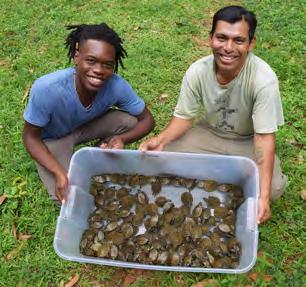
Jaren Serano of the Cayo District, joined the BFREE staff as our first Science and Education Fellow in January 2018. Jaren is a passionate advocate for the conservation of Belize’s natural resources including the Hicatee. After visiting BFREE during a field course with Sacred Heart Junior College, he applied for a two-week internship in the summer of 2017. Because of his obvious commitment to BFREE’s mission, Jaren was invited back to take part in the autumn Hicatee health assessments, and began full-time work with BFREE as part of a two-year fellowship program. Upon completion of the program, Jaren intends to continue his education in Conservation Biology and, ultimately return to his home country to pursue a career in conservation. As part of the HCRC team, Jaren provides important technical skills including writing monthly reports and data entry. Jaren primarily cares for the 2018 hatchlings and supports all work taking place at the HCRC.
cluded: Adventures of Herbert the Hickatee, a children’s book created by Gianni Martinez, a primary school teacher in Belize City, Hope for Belize’s Hicatee: Central American River Turtle, a documentary produced by filmmakers Richard and Carol Foster, and the Hicatee excerpt from Turtles in Trouble: The World’s 25+ Most Endangered Tortoises and Freshwater Turtles - 2018 report. Young Hicatee Ambassadors were selected to hand deliver packet materials to their classrooms. Adorned in a Hicatee t-shirt, these young conservationists read the poem “I am a Hicatee Hero,” and handed out Hicatee stickers to their classmates after delivering the complete educational packet to their teacher.
Prior to Hicatee Awareness Month, BFREE and the TSA Board of Directors embarked on a letter campaign to introduce the Belizean Government to the concept of the Hicatee as the National Reptile. The campaign was met with immediate interest and support from government officials. We are hopeful that
the animal will be adopted as the National Reptile of Belize in the very near future.
Plans are underway to build out a third pond for rearing hatchlings at the HCRC. In the coming years, plans include the possible establishment of a Hicatee Reserve, officially adopting the Hicatee as the National Reptile, developing a fully integrated recovery and management plan for the species, strengthening the outreach and awareness campaign, and beginning to release turtles back into the wild.
Acknowledgements: Funding support for the Hicatee Conservation and Research Center and our associated programs was generously provided by the Turtle Survival Alliance and Jacksonville Zoo and Gardens.
Contact: Heather Barrett and Jacob Marlin, BFREE, 4320 W. University Ave, Gainesville, FL 32607 [hbarrett@bfreebz. org; jmarlin@bfreebz.org]
Jacob Marlin
The conservation community and wildlife film industry recently lost a true pioneer and trailblazer The Belize Foundation for Research and Environmental Education (BFREE), TSA, and so many of us in the conservation community are shocked and deeply saddened by his passing.We wish to express our heartfelt condolences to his wife Carol, brother Simon, and daughter Olivia. His untimely death is a tragedy beyond measure; not only to his family and friends, but to the entire country of Belize. The loss of Richard has sent a shockwave throughout the conservation and wildlife filming industries, and is a tremendous setback in the ongoing effort to conserve the CentralAmerican River Turtle (Dermatemys mawii) aka Hicatee.
Richard’s lifetime was spent capturing the natural world through video and sharing it for the world to see.As true pioneers, Richard and his lovely wife Carol were among the first filmmakers to document the beauty and diversity of Belize’s wildlife. Richard and Carol were an inseparable and powerful team, working together all over the world for decades, filming and producing some of the richest wildlife documentaries ever made. The pair made dozens of documentaries for National Geographic and BBC, winning an EmmyAward, and making films such as Realm of the Serpents, Path of the Rain Gods, Journey Through the Underworld, The Land of the Anaconda, and many others.They also made numerous short films for local and international NGO’s, including in 2017 when they completed Hope for Belize’s Hicatee, the Central American River Turtle, which was debuted at the 2017TSA/IUCN-TFTSGAnnual Symposium in Charleston, South Carolina.
Richard and Carol were first introduced to Rick Hudson andTSAin 2009. BFREE
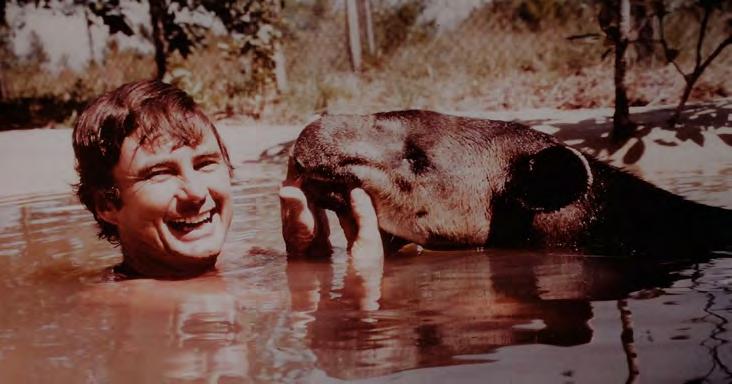
Executive Director Jacob Marlin and Hudson were traveling around the country, exploring possibilities and meeting stakeholders to get involved in developing a strategy and program to conserve the Hicatee. Richard and Carol were both very interested and wanted to help in any way they could. Richard suggested that they could assist with surveys, meet local hunters, work on a documentary, or other projects that they saw as helpful. Richard was enthusiastic and wanted to actively support the project, and shared his strong conviction that if something wasn’t done immediately for the species, it would likely be lost forever.
Over the course of the next nine years, Richard was instrumental in getting the program off the ground. Starting in 2010, the Foster’s home and guest house was base camp for the countrywide survey, conducted by Dr. Thomas Rainwater and team, that launched the conservation program. In 2013, after the Hicatee Conservation and Research Center (HCRC) was completed, the Foster’s home once again became central command for the collection of the founding turtle population for the center. Richard personally cared for all the turtles that were
brought in, filling his canoes daily with fresh water to house the turtles in ad-hoc enclosures. Richard provided boats and equipment which helped make this critical stage of the program a success. In following years, Richard’s home served as an off-site BFREE lab for incubating eggs collected from the HCRC, and investigating embryonic diapause and Temperature Sex Determination. Until recently, BFREE lacked the power to provide electrical current for the incubator, so Richard cared for and maintained the incubator for two consecutive seasons.
During production of Hope for Belize’s Hicatee in 2016, Richard was at his best. His passion for filming and set design was unmatched and his unique style and art form were without comparison. He designed and created an elaborate and naturalistic set for the film and captured Hicatee behavior that would otherwise never be seen by the public. In the wildlife film industry Richard Foster was a legend. His energy was endless, his enthusiasm contagious, and his creativity inspirational. Richard Foster: wildlife documentary film maker, Emmy Award winner, conservationist, and Hicatee hero. You are forever loved and missed.
Germán Forero-Medina and Igor Valencia
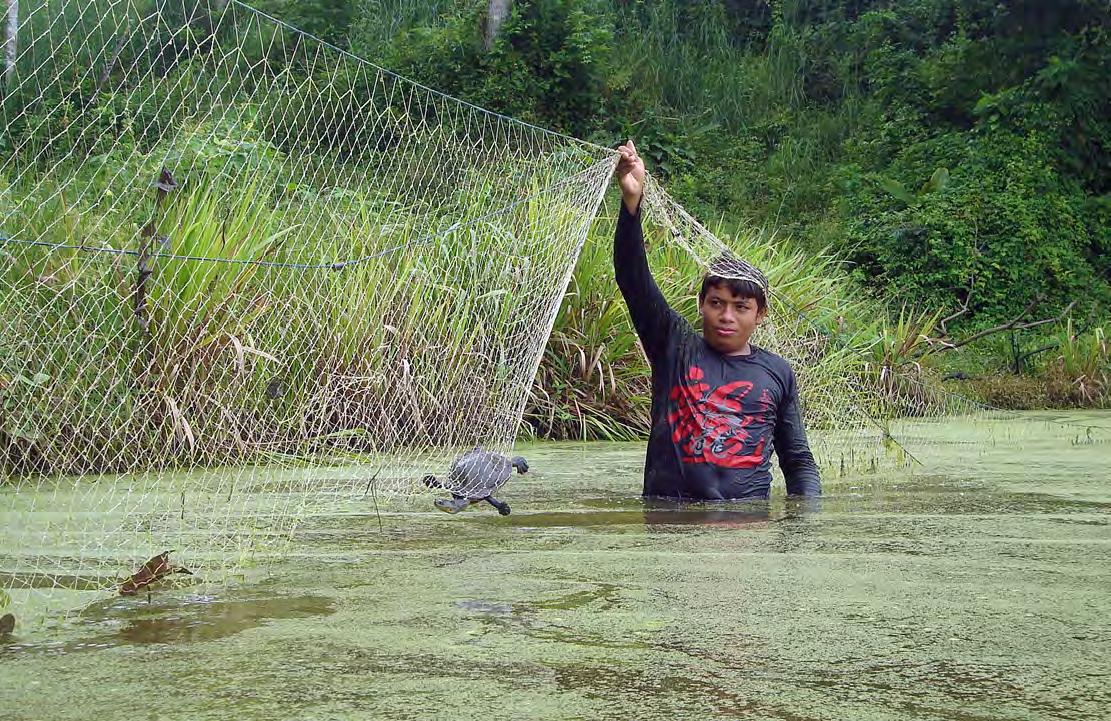
MONITORING AND EVALUATION OF A POTENTIAL PROTECTED AREA FOR DAHL’S TOAD-HEADED TURTLE
Between the months of October and November 2017, the mark-recapture study of Dahl’s Toad-headed Turtle (Mesoclemmys dahli) continued in the Bajo Limon, Cordoba, Colombia. The study was conducted over a period of 10 days. The team, formed of Oscar Negrette (a member of Econbiba cooperative) and 2 local workers, Jair Bonilla and Nilson Caraballo, performed
this activity with the technical and financial support of TSA/WCS. This is the third year of monitoring this population, one of the few known for the species.
The range of M. dahli lies completely within the tropical dry forest, one of the most heavily impacted and least protected ecosystems in Colombia. At all sites where populations have been detected, its habitat has been degraded and experiences regular human-induced fires, which cause mortality in adults and nests. Additionally, recent
research has shown that the species is experiencing high levels of inbreeding, potentially caused by the fragmentation of its original habitat. Persistence of the species in the long-term may require management (genetic rescue) to avoid deleterious effects of inbreeding. This management can only be done in a reserve, where the population is guaranteed to persist.
This year, TSA partnered with Rainforest Trust to explore the potential creation of a protected area for M. dahli. The goal of
this land acquisition initiative is to create the first protected area for this threatened species in a strategic site known for its local abundance and genetic diversity. This land acquisition will also provide an area to implement restoration efforts of the turtle’s habitat in order to protect and manage the population for its long term persistence. The area selected for the establishment of the protected area was carefully identified over the last 3 years. The location holds a relative abundance of the species, has some of the highest genetic diversity, and allows promising management of the reserve by a local community. Because the species is not currently protected by any type of national, regional, or private protected area, its habitat is highly degraded, and it is experiencing high levels of inbreeding, it is urgent to establish a site where a population of the species can be protected, its habitat restored, and the largest amount of genetic diversity preserved. Hopefully next year will see the
Table 1. Number of individuals of M. dahli found in the 2017 mark-recapture activity
creation of this preserve, crucial for the conservation of the species.
The joint Turtle Survival Alliance (TSA) and Wildlife Conservation Society (WCS) program continues to work in the location of La Virgen, in the Department of Arauca for the conservation of the Giant South American River Turtle (Podocnemis expansa). This year, nesting activities commenced
in the final weeks of January and ended in March. A total of 379 nesting females and their nests were protected by the community during the laying, incubation, and hatching periods. This initiative is part of “Proyecto Vida Silvestre,” a wildlife project focused on Colombia’s native fauna. Together with the community of La Virgen, they have protected species in this region since 2015. This year, the project was renewed for another three years, guaranteeing both the consolidation of the community work and the protection of P. expansa during that period. In celebratory news, Segré Foundation has joined as
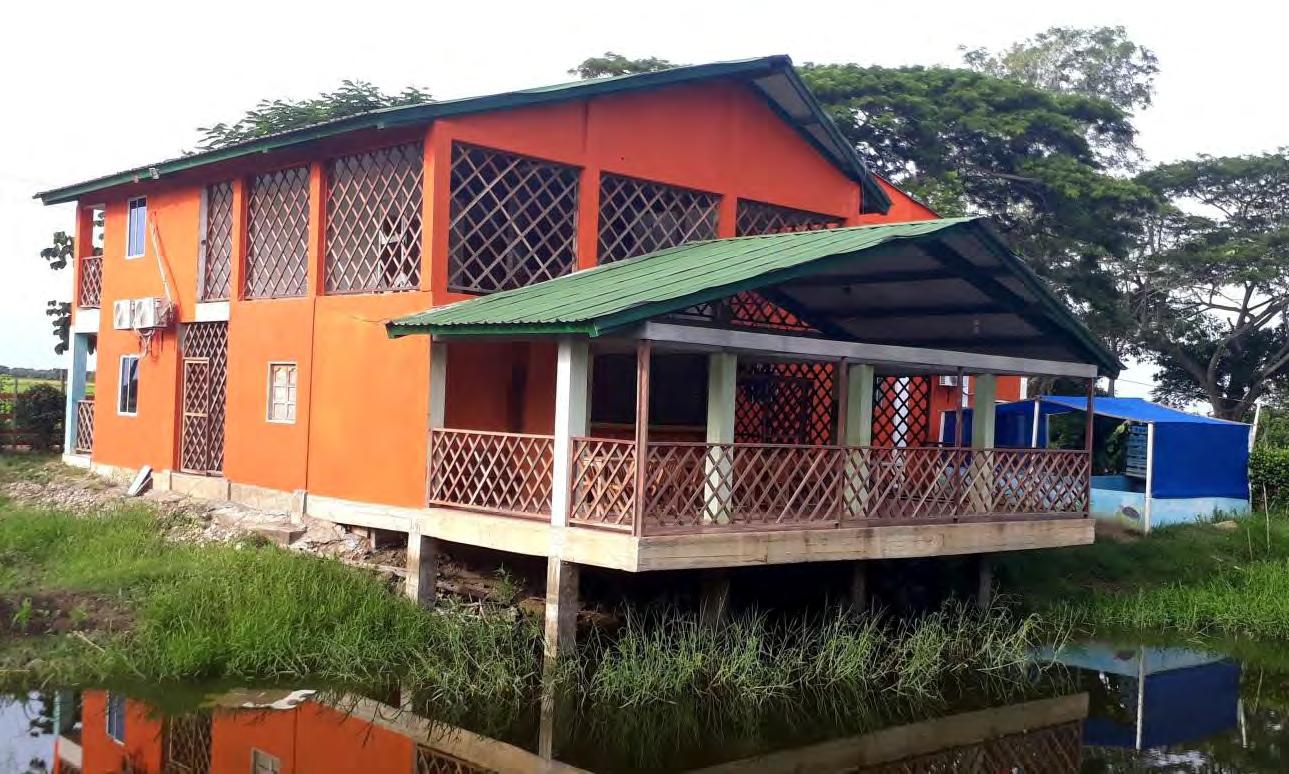
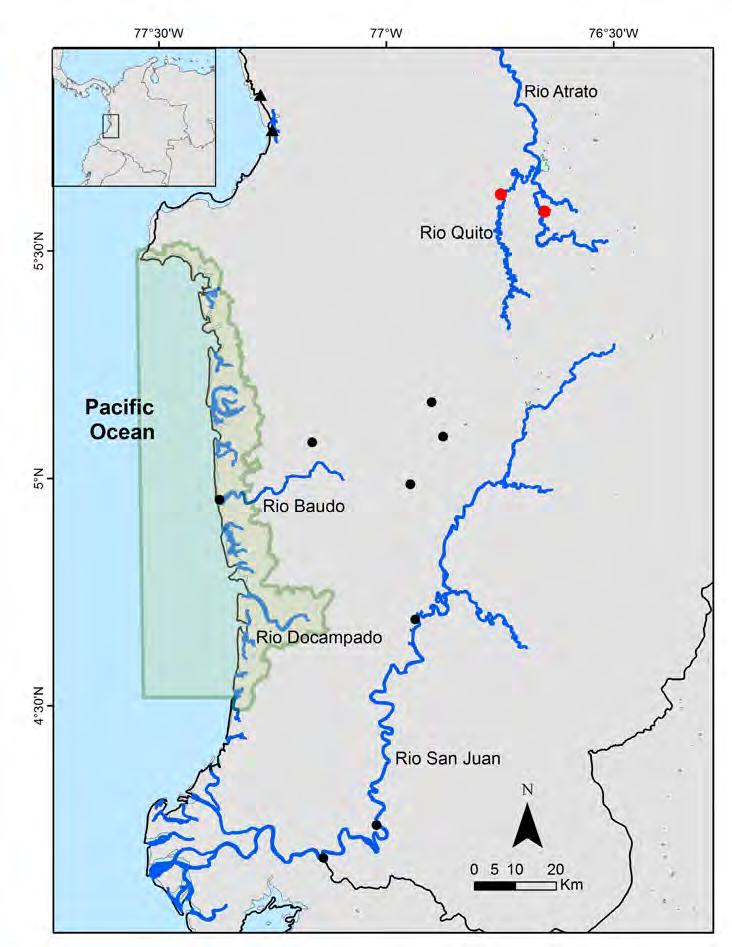
a supporter of the conservation efforts for P. expansa in La Virgen. The objective of their support is to continue female and nest protection, and to develop a strong environmental education program in local schools with the aim of integrating the turtle and its riverine environment into the elementary level curriculum. Additionally, this funding will focus on supporting the necessary science for and implementation of pilot projects designed for sustainable use of turtle eggs by the community. It is the goal that finding a sustainable compromise will stimulate protection for the
turtles long-term.
The participatory work of the Cotocá Arriba community for the conservation of the Magdalena River Turtle (Podocnemis lewyana) in the Sinú River continued for another year in 2018. This work has allowed the growth of a committed and empowered community. Over the last decade, the project has relied on external grants to fund conservation activities focused on reducing consumption of the turtle and counteracting the negative impacts of a hydroelectric dam on the river.
To guarantee the project’s persistence over time however, the community is implementing an ecotourism initiative aimed at improving the community’s standard of living and generating revenue to cover some of the costs of the conservation actions.
Luis Carlos Negrette, community leader, was hired to implement the business plan he developed as a Conservation Leadership Program award grantee and prepare the community for ecotourism activities. First steps included a series of infrastructure adjustments and equipment acquisition such as the purchase of a fiberglass canoe with a 10-person capacity. Counterpart to these infrastructure improvements, a series of workshops were carried out by Luis Carlos with members of Econbiba, for the purpose of strengthening their leadership and decision-making skills. Further work will be focused on the creation of visual material to promote the project and attract new visitors, including the creation of the official web site—currently under construction. The next year will see the launch and implementation of the tourism activities to evaluate their long-term potential.
Dunn’s Mud Turtle (Kinosternon dunni) is one of four endemic species to Colombia. First described in 1947 from two specimens originating from the locality of Pizarro, it exclusively inhabits localities within the San Juan, Baudó, andAtrato river basins of the Pacific/Chocó natural region, in the state of Chocó. With very few populations having been reported since its original description, it is one of the least known turtle species in the country and considered Vulnerable to extinction due to its restricted range and impacts from mining activities.
While Pizarro (Bajo Baudó) is the type locality for the species, its presence at the site had not been confirmed since its description over 70 years ago, until now. Recently, a
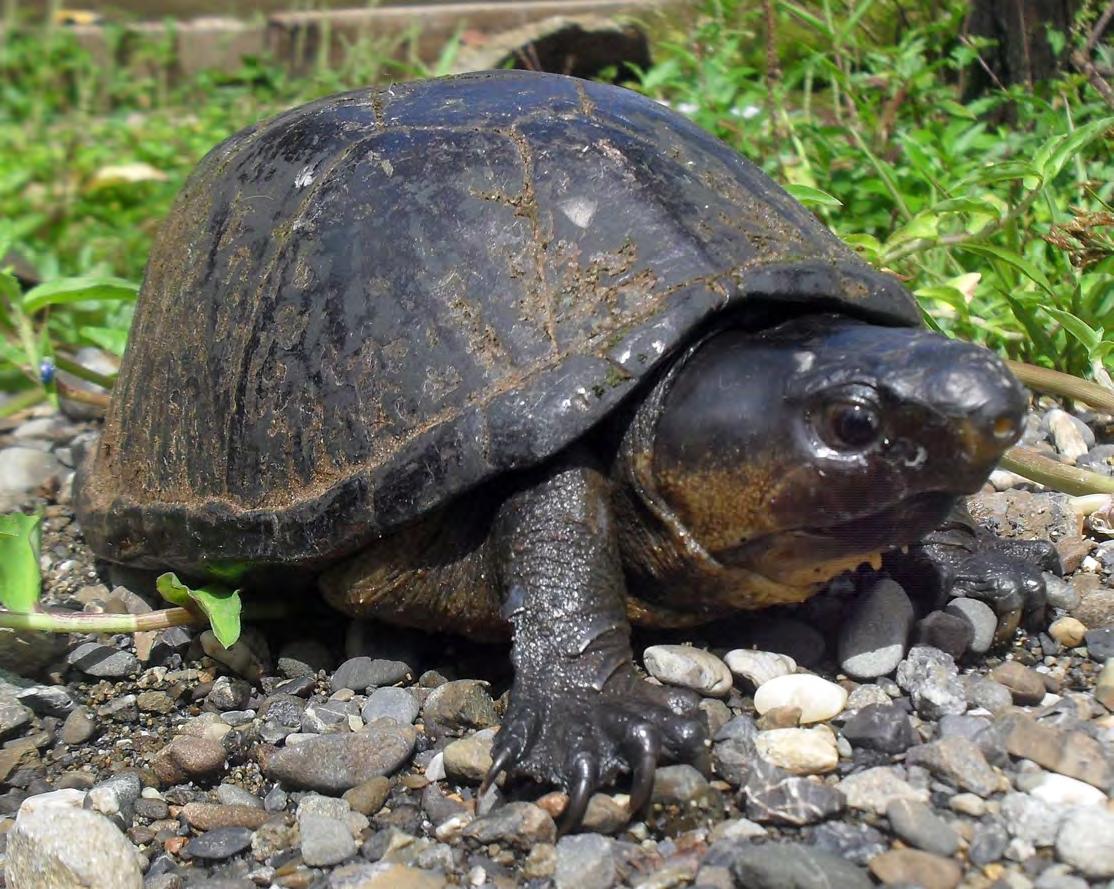
functional population was identified inside the newly created “Distrito Regional de Manejo Integrado Encanto de los Mangales del Baujo Baudó,” a protected area along Colombia’s Pacific coast (Fig. 1). This is the first and only protected area known to contain populations of this endemic and threatened species. Confirmation of its presence in the coastal wetlands of the protected area is of great importance, as it opens the possibility for research and conservation actions for the species within the framework of the area’s management plan.
This regional protected area was established by the regional environmental authority
Corporación Autónoma Regional Para El Desarrollo Sostenible Del Chocó (CODECHOCÓ), on 6 September 2017. The process had the participation and support of local communities (10 Afro Colombian collectives), government institutions (Mayor of Bajo Baudó, Alexander von Humboldt Biological Resources Research Institute), and varied NGOs such as Naturaleza Colombia Internacional, World Wildlife Fund, Wildlife Conservation Society, Turtle Survival Alliance, Fundación MarViva, and Corparién. Currently, these organizations are supporting the design process of the management plan, focused on sustainable use of natural
resources and conservation of key areas, including habitat of the recently discovered populations of K. dunni
Acknowledgements: Tim Gregory, Disney Conservation Fund, Fundación Mario Santodomingo, Ecopetrol, Fondation Segré, Wildlife Conservation Society, Fundación Omacha, People’s Trust for Endangered Species.
Contact: Germán Forero-Medina and Igor Valencia, Turtle Survival Alliance, Wildlife Conservation Society, Cali, Colombia [gforero@wcs.org; ivalencia@ wcs.org]
Last November, Wildlife Conservation Society (WCS) Cambodia and the Royal Government of Cambodia’s Fisheries Administration (FiA) released 25 subadult Southern River Terrapins (Batagur affinis) into their natural habitat of the Sre Ambel River system in southwestern Cambodia. This cohort was composed of 13 female and 12 male specimens, ranging in age from seven to eleven years. Each individual was microchipped for future identification and outfitted with acoustic transmitters prior to their release. In an effort to reduce their stress, allow them to adapt to their new environment, forage for natural food, and exercise swimming muscles in a riverine environment, they were first released into an acclimation pen comprised of a 1.5-hectare oxbow lake adjacent to one of the rivers in the system. The release was inaugurated by His Excellency Srun Limsong (FiA Delegate), representatives from WCS, Turtle Survival Alliance (TSA), Wildlife Reserves Singapore, trustees, donors, and many other partners. The team tracked them twice every month (two, five-day monitoring sessions) using a MANTRAK USR-14 receiver. The project also used three passive receivers (SUR-3) placed at three different locations to detect any terrapins that passed by.
As of August 2018, all released B. affinis have been detected in the river system, aside from one that was captured by fishermen. This specimen was retrieved from the fishermen and is now being kept back at the Koh Kong Reptile Conservation Center

(KKRCC), from which it originated. The 24 other turtles have spread out into different rivers within the system. Remarkably, one male has traveled across the mangrove coastal area and into another river system more than 90 km away from the release site.
Only one nest of B. affinis was located and protected during the 2018 nesting season along the Sre Ambel River. The nest was discovered at the same nesting sandbar utilized by the wild females last season. This single clutch consisted of 16 eggs, of which 10 hatched successfully. The hatchlings are now being kept at the KKRCC for headstarting.
The KKRCC now houses 204 adult, subadult, and hatchling B. affinis. This includes 69 subadults who were occupying the two existing breeding ponds. This year, to accommodate the growing colony of B. affinis and further expand the facility, upgrades have been partially completed including housing for local staff, an office, a secure shaded structure for hatchlings, four large ponds, a water retention pond, a sewage pond, and two quarantine ponds. Of the four large ponds being installed, one has been completed and is now housing the subadults. It is equipped with a solar panel-run biofilter, floating platforms, shade structures, and a
mesh perimeter fence. Two other large ponds will be completed in January 2019; they have been dug and lined, but need water filters and perimeter fences. A significant impediment that the center has faced is not having enough water supply during the dry season. This has led to several turtle health issues such as skin disorders and other illnesses. The turtles’ protein levels are very low and the program is looking into various options to remedy this deficiency.
Large-scale sand mining has been banned in the country, effective July 2017. However, small-scale sand mining continued from March to June 2018 in the Sre Ambel River. This mining activity has led to the destruction of two nesting sandbars along the only river where the turtles still nest. Fortunately, the mining was halted through the action of numerous meetings and consultation between the FiA, WCS, local authorities, sand mining company, and foremost, the Ministry of Mines and Energy (MME).
CREATION OF SOUTHERN RIVER TERRAPIN AND SIAMESE CROCODILE CONSERVATION MANAGEMENT ZONE
FiA, with technical support from WCS, is currently working on a Ministerial Proclamation (Prakas) to include the Sre Ambel River system into a Management Zone that will confer protection of the waterway, its vegetated riparian zone, and sandbars. The Prakas will be named The Establishment of Southern River Terrapin and Siamese Crocodile Conservation and Management Zone. The Prakas has also included the boundary of the river system into the management zone as well as the restricted conservation zones for B. affinis. The Prakas is being reviewed and it is hoped to be applied by the end of 2018.
WCS and FiA are working to conserve the Asian Giant Softshell Turtle (Pelochelys
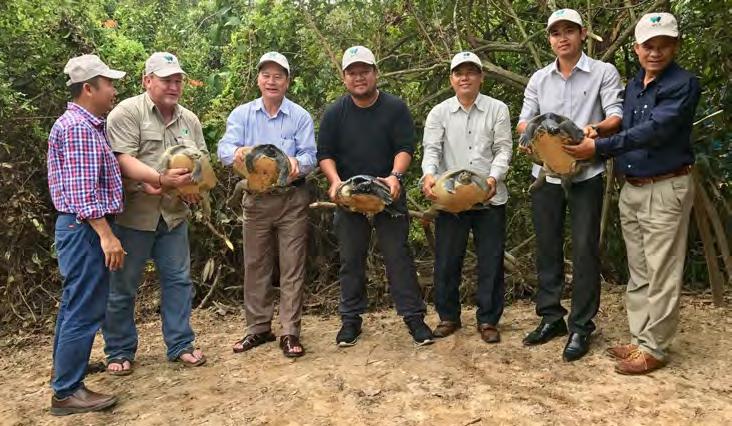
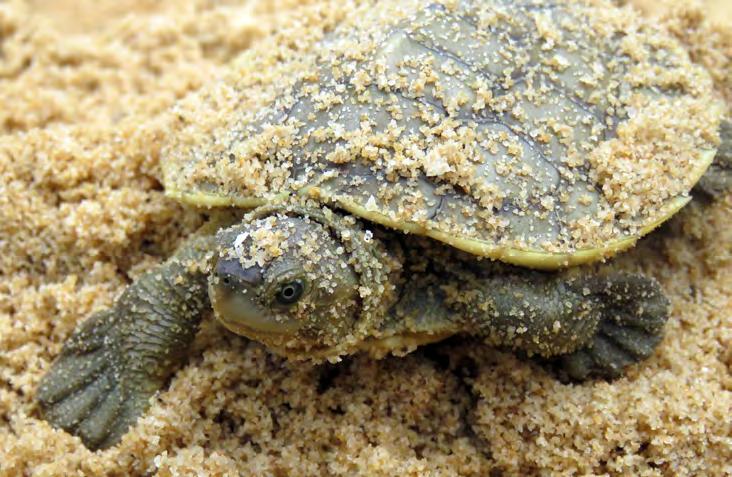
cantorii) in a 48 kilometer segment of the Mekong River from Kratie to Stung Treng Province through the implementation of a nest protection program. In 2018, the program protected 24 nests consisting of 825 eggs. This resulted in the hatching of 565 softshells—a 67.43% hatching success rate. All hatchlings were released directly back into the river during a release event organized in June 2018. The release received participation from FiA delegates, WCS Director and project staff, the District Governor, local authorities, community members, students, monks, and received widespread media coverage.
Acknowledgements We would like to thank the previous and current donors for supporting this project: Critical Ecosystem Partnership Fund, National Geographic Society, Chicago Zoological Society, U.S. Forest Service, and the Turtle Conservation Fund. We give special thanks to our partners at Wildlife Reserves Singapore, Turtle Survival Alliance, as well as private donors.
Contact: Sitha Som, Wildlife Conservation Society Cambodia, #21, Street 21, Tonle Basac, Chamkarmorn, Phnom Penh, Cambodia, [ssom@wcs.org]
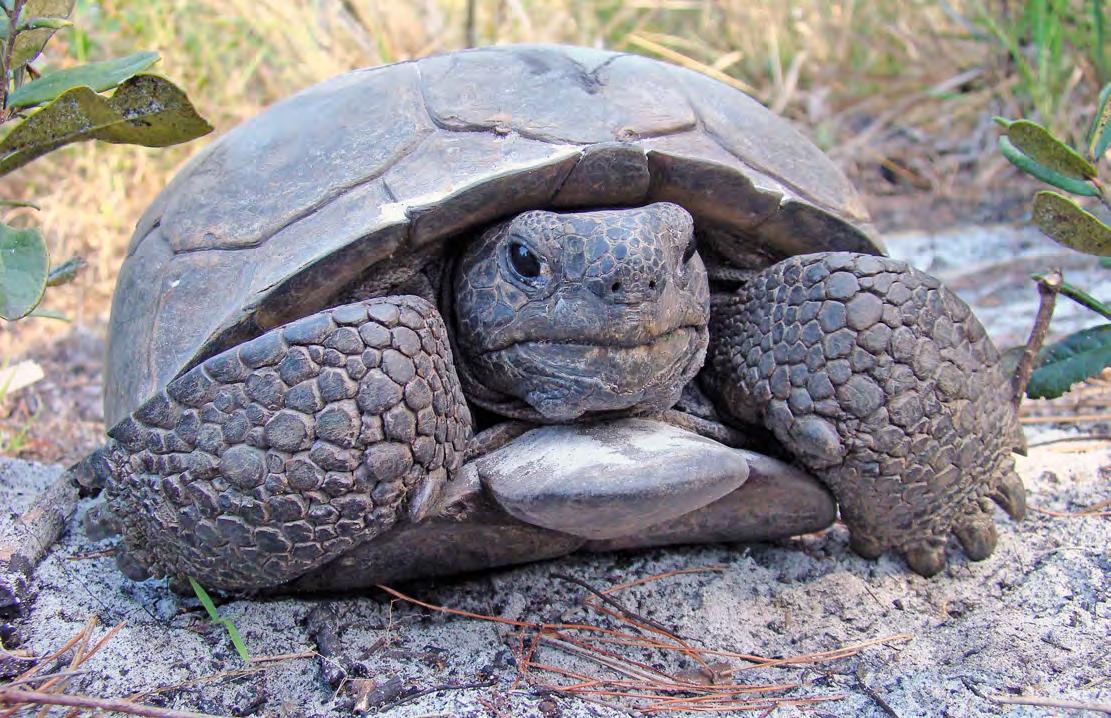
Just three hours earlier, neither of us had ever seen a wild Bog Turtle (Glyptemys muhlenbergii), the smallest and one of the most imperiled turtle species in the United States (U.S.). On this morning, we found eight of these little jewels which are threatened by habitat loss and fragmentation, invasive nonnative plant species, and poaching for the pet trade. We joined New Jersey Division of Fish and Wildlife staff and volunteers to survey parcels of private land in the northern section of the state as part of The Big Turtle Year (TBTY), a conservation education initiative of the Florida Turtle Conservation Trust
George L. Heinrich and Timothy J. Walsh
(FTCT). This non-profit NGO began in 1999 and works to conserve Florida’s rich turtle diversity through research and education. Throughout 2017, we were joined by other biologists and conservationists at dozens of sites within the U.S. in an effort to see as many species as possible during a single year, while examining threats and conservation actions that may be needed.
Turtles are among the most endangered wildlife on Earth (59% of all species are threatened with extinction). While species from areas such as Asia, South America,
and Madagascar often receive the majority of conservation attention, the plight of U.S. species goes quietly unnoticed. The goal of FTCT’s first conservation education project outside of the state of Florida was to increase awareness regarding the status of these often overlooked, ecologically significant reptiles, and emphasize the rich diversity, ecology, and conservation needs of species found in the most turtle-rich country in the world (now 62 species and 89 terminal taxa).
We like seeing wild turtles in wild places, and TBTY provided an opportunity to explore
a wide variety of contrasting habitats in 13 states, including montane, forest, prairie, desert, lake, river, swamp, and marine ecosystems. We used the most recent Turtle Taxonomy Working Group checklist (2014) that was available on the first day of TBTY and began our search for 59 species. Our year-long quest started at Boyd Hill Nature Preserve, St. Petersburg, Florida. This location was selected for symbolic reasons as the preserve is close to George’s heart and where he has studied the herpetofauna for over 25 years. There, we observed nine Gopher Tortoises (Gopherus polyphemus), including a hatchling at its burrow. Although no longer eaten (legal harvest ended in 1988), habitat loss and fragmentation, as well as road mortality, continue as major threats to this keystone species of the Southeastern Coastal Plain.
George, the constant in the project, completed 12 multi-day field trips (logging 78 nights away from home), as well as numerous daylong excursions. Tim joined three field trips, as well as coordinated multiple technical and logistical aspects of the project. Along the way were dozens of opportunities to see wild turtles, both common and rare, in their associated habitats. Highlights
included four of the six North American tortoises (which took us to two deserts), 14 species of map (Graptemys) turtles (observed across five states), Flattened Musk Turtles (Sternotherus depressus), which are geographically restricted to one river system in north-central Alabama, and five marine species, including 9 Loggerhead Sea Turtles (Caretta caretta), 4 Green Sea Turtles (Chelonia mydas), and 2 Leatherback Sea Turtles (Dermochelys coriacea) during a single evening on a dark beach on Florida’s east coast.
A diverse range of threats (many working in synergy) are of concern to conservationists. Habitat loss and degradation tops the list, but water levels and quality, limited geographic range, and poaching are also major concerns. Long periods of drought can severely impact species such as the Northern Western Pond Turtle (Actinemys marmorata), Southern Western Pond Turtle (Actinemys pallida), and Sonoyta Mud Turtle (Kinosternon sonoriense longifemorale). Turtles often become concentrated in very small pools making them vulnerable to predators and desiccation. Species with limited geographic ranges within the U.S., such as the Sonoyta Mud Turtle (occurs in a single half-acre pond
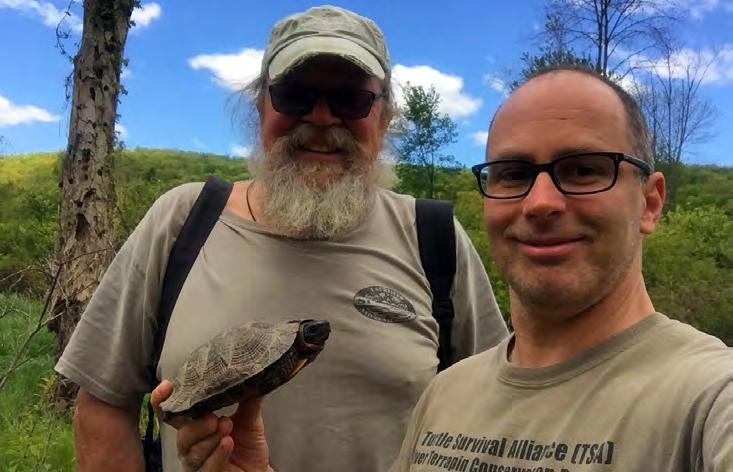
in southern Arizona) require cooperative, international conservation efforts. Demand for the international pet trade drives poaching of federal- and state-listed species. Despite the urgency of the situation, opportunities for conservation are abundant and the charismatic attraction of turtles makes them an excellent group for education and outreach efforts to enhance ecological, conservation, and environmental awareness.
The year-long project ended in Florida as it began, but with a sighting of a single Florida Chicken Turtle (Deirochelys reticularia chrysea) at Fakahatchee Strand State Preserve (Collier County). We had searched in four states for this common, yet secretive species, and finally got #57 for TBTY with just three days to spare. In the end, only two species were not found: Apalachicola Alligator Snapping Turtle (Macrochelys apalachicolae) and Yellow Mud Turtle (Kinosternon flavescens). We tried for them in Georgia and Texas respectively, but it was not to be.
We are most grateful to all of our project partners, everyone who joined us in the field, and to dozens of generous donors who made this project possible. Like many FTCT projects, this one was fully funded by such individuals. What a great time we had traversing the U.S., and both learning about and educating others on the plight of U.S. species. Although the fieldwork phase of this project is now complete, we still have much work to do, including a nationwide lecture series, magazine articles, and a book. Please visit the project website (www.thebigturtleyear.org) and FTCT’s Facebook page for updates. We like turtles and know that you do too.
Contact: George L. Heinrich, Heinrich Ecological Services, 1213 Alhambra Way S., St. Petersburg, Florida 33705-4620, USA [george@heinrichecologicalservices.com]; Timothy J. Walsh, Bruce Museum, 1 Museum Drive, Greenwich, Connecticut 06830-7157, USA [twalsh@ brucemuseum.org]
Eleanor T. Chubb
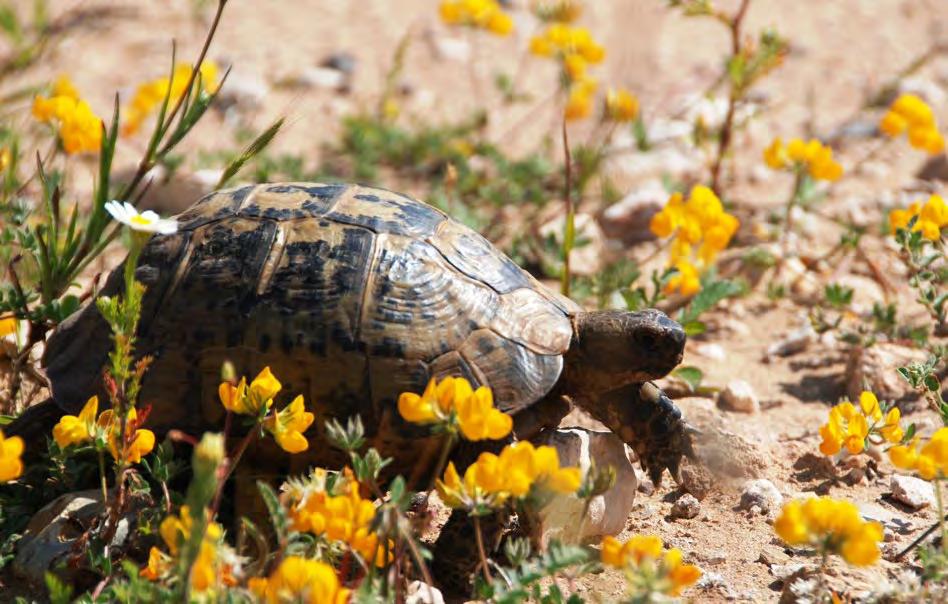
TSA’s presence in Europe has long-struggled to develop a unified identity. This has been rendered acute since the passing of prominent TSA Europe committee members Henk Zwartepoorte (Chair) and Hans-Dieter Philippen (Vice Chair) two years ago. As we work to develop this identity, issues that continue to beset TSA Europe include a wide nexus of partnerships spanning multiple countries, varying levels of professional stature and interest, and lack of mainstream recognition. Our goal is to create a stronger and more unified TSA presence in Europe.
TSA Europe currently has just over 70 registered members representing numerous
nationalities and over 24 languages. With over 24 languages and countless dialects, boundaries in communication arise when it comes to sharing knowledge and building alliances. To overcome this obstacle, TSA Europe has been building regional representation with native speakers in Dutch, English, French, German, Italian, and Spanish. These individuals help translate TSA information, promote the annual magazine at local events, and identify collaborators. This year, to increase engagement of our members and foster European collaborations, TSA Europe has promoted bond-strengthening events and zoo visits. These include visits to zoos known for their work with chelonians including Dur-
rell Wildlife Conservation Trust and Jersey Zoo, Wildlands Adventure Zoo Emmen, and other zoos in Bristol, Chester, London, Linton, Rotterdam, and Paignton.
TSA Europe also wants to be a key player in seizures and confiscations. This can be accomplished through an advisory role for temporary husbandry and through correct animal placement. To achieve this, we are proposing three primary engagement tactics: 1. Appealing to the chelonian community to support a more collaborative alliance, 2. Encouraging programs and research by offering small seed grants and translation support, and 3. Developing the untapped potential of sponsorship in Europe.
To accomplish this, TSA Europe must first streamline the organization including its Board of Directors. Although new board members have been found and advisory relationships have been established, TSA Europe still seeks to build further partnerships. After regrouping with the TSA Board of Directors in August 2018, we are working to modernize our approach, including an improved website and increased social media, that seeks to better link the global TSA network.
Current TSA Europe reorganization includes promoting TSA Europe’s autumn conference at Colchester Zoo, UK. The weekend will offer networking opportunities for those interested in, and working with, chelonians. Seven speakers will be presenting on conservation, veterinary, and research topics. An important part of the weekend will include delegate team building workshop opportunities. Speakers will include Prof. Dr. Hermann Schleich, who will be sharing his chelonian work with Amphibian and Reptile Conservation (ARCO) in both Spain and Nepal. We also welcome a presentation from German native field researcher Wolfgang Wegehaupt, with whom TSA Europe is collaborating to translate some of his 30 years of research with the Common Tortoise (Testudo gracea) and the Hermann’s Tortoise (Testudo hermanni). Paignton Zoo will present its collaborative work with UK researcher and zoologist Frances Baines in developmental work on UV and heat for captive chelonia. This is an important topic given the drastic climate differences between captive and native habitats in Europe. Highlighting this, recent egg-laying success with Paignton’s group of Aldabra Tortoises (Aldabrachelys gigantea) makes it potentially one of first European zoos to successfully hatch this species.
COLLABORATIONS AND SIGNIFICANT BREEDINGS
Increasingly important to TSA Europe is the captive propagation of threatened species. Successfully bred species include Spotted
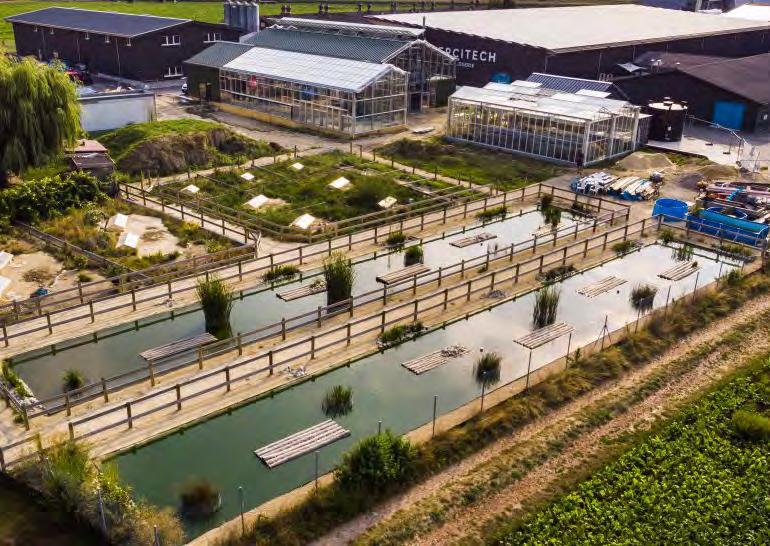
Pond Turtle (Geoclemys hamiltonii), Rednecked Pond Turtle (Mauremys nigricans), and the Southern Vietnam Box Turtle (Cuora picturata). 2018 has also seen Burmese Star Tortoise (Geochelone platynota) successfully bred at the Cologne Zoo, Germany. The first captive reproduction of the Burmese Star Tortoise in a European zoo occurred eight years ago, both at Rotterdam Zoo in the Netherlands and Zoopark Zájezd in the Czech Republic. Thus, the recent hatching event at Cologne Zoo’s Terrarium is the third documented successful reproduction for this species in a European zoo. It is another significant contribution to the development of an assurance colony among European zoos.
Furthermore, a possible collaboration with the association ‘Protection et Récupération des Tortues’ at Chavornay, Switzerland, is being explored. This association was founded by Jean-Marc Ducotterd and has been active for over 20 years. Its primary mission is to act as a repository for unwanted captive turtles to avoid their potential release into the wild. Today, 2,300 turtles
and tortoises inhabit the expanding facility that, when completed, will provide capacity for 4,000-5,000 specimens. Entitled “Centre Emys”, the facility includes outdoor habitats, a temperate greenhouse, and a tropical building. It is perhaps the largest turtle collection in Europe. A team of 20 volunteers perform husbandry and welcome visitors. This is important, since the center seeks to raise public awareness about captive turtles. Additionally, Protection et Récupération des Tortues launched the Emys Project in 1999 to reintroduce and protect the European Pond Turtle (Emys orbicularis) in Switzerland. An emblematic species of Swiss marshlands, E. orbicularis was formerly extirpated in Switzerland. Thanks to this project, 80 European Pond Turtles have been reintroduced into three natural reserves since 2010, with the first successful wild reproduction occurring in 2017.
Contact: Eleanor T. Chubb, TSA Europe, P.O. Box 249, Bracon Ash, Norfolk, NR14 8WY, United Kingdom [eleanor@turtlesurvival.eu]
This year, the 13th Annual Behler Turtle Conservation Award celebrates and honors Russell A. Mittermeier for his half-century of dedication to science and conservation of turtles and primates, as well as being a world-leading global conservationist of the highest caliber. The Behler Award is effectively the “Nobel Prize for Turtle Conservation and Biology”.
Russ has been a hard-core herpetologist since childhood, with a particular interest in turtles, snakes, and crocodilians. He spent his early years in the Bronx and Brooklyn, New York, where he was fortunate to have a mother that took him to the Bronx Zoo and the American Museum of Natural History on a weekly basis. At age 9, he moved to North Babylon, Long Island, NY where he became an avid collector of turtles, snakes, frogs, and salamanders, and a member of both the New York Herpetological Society and the Long Island Herpetological Society. A strong motivator for his life’s direction into the field of conservation came early on, as he witnessed the rapid transformation of the forests in his Long Island neighborhood into housing developments—eliminating the habitats for his favorite species.
Russ and I first met 50 years ago, in 1968, while attending Dartmouth College. As an undergraduate, he spent his sophomore year in Europe where he had his first serious interactions with professional herpetologists in Mainz and Frankfurt, Germany. Among them were Robert Mertens, Klaus Klemmer, Erhard Thomas, and especially Walter Sachsse. These interactions further strengthened his interest in turtles and herpetology. During this same period, he also began a strong focus in primatology through visiting zoos in 18 different countries, building on an incipient interest stimulated by his childhood fascination with Tarzan books and movies. As he pursued a focused study in primatol-
Anders G.J. Rhodin
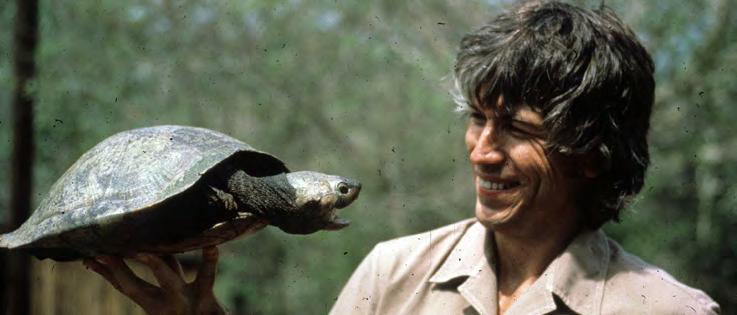
ogy, we dreamt of going to Madagascar together to study lemurs. Following graduation, however, we instead carried out a joint exploration of Panama, Colombia, and the Brazilian Amazon that intensified his commitment to both turtles and primates.
Our paths continued to move in tandem when Russ entered graduate school at Harvard University in 1971 as a student of Biological Anthropology under primatologist Irven DeVore. Despite his focus in primatology, Russ’ strong herpetological roots once again came to the fore, and he worked a great deal with Harvard herpetologist Ernest E. Williams. From 1971 to 1978, Williams gave Russ office space in the Museum of Comparative Zoology (MCZ), where I also happened to work as a Research Associate. Russ continues his relationship with the MCZ in the present day as a Research Fellow.
Not satisfied with just staying in an office during his time as a graduate student, Russ carried out field work in Panama, Tanzania, Peru, Colombia, Brazil, and Suriname. The work performed in Brazil was particularly interesting in that it included a long Amazonian expedition in 1973, following in the footsteps of the great 19th century explorers Henry Walter Bates and
Alfred Russel Wallace. This expedition included intensive research on both primates (especially the then virtually unknown uakaris and sakis) and herps. It led to a number of publications on Amazonian turtles, the most notable of which was the redescription of the Red-headed Amazon Sideneck Turtle (Podocnemis erythrocephala). From 1975–1977, Russ did his doctoral dissertation work on the monkeys of Suriname, but also carried out studies on the two forest tortoises there. In 1976, Russ and I published our first description together of a new turtle, Parker’s Snake-necked Turtle (Chelodina parkeri) from New Guinea, and our careers began to take off.
Upon earning his Ph.D. from Harvard in 1977, Russ moved forward to the Department of Anatomical Sciences at the State University of New York at Stony Brook in early 1978. While there, he completed the first ever Global Strategy for Primate Conservation with several colleagues. This document caught the attention of the World Wildlife Fund–US, as well as the attention of renowned Amazon specialist, Thomas E. Lovejoy—the resultant of which was the creation of a Primate Program and a Primate Action Fund. The latter exists to present day, but now with Global Wildlife Conservation (GWC).
In 1989, after 11 years of concentrated focus on primates, turtles, Brazil, the Guianas, and Madagascar, Russ left WWF-US for Conservation International (CI). There, he embraced his title as President, a position that he occupied for 25 years, before transitioning to Executive ViceChair in 2014. At CI, he was the key figure in adapting Norman Myers’ Biodiversity Hotspots concept into a core strategy for the organization for the next two decades, producing hugely successful fundraising results. From Myers’ original 10 Hotspots, and then later 18, Russ and colleagues carried out research that eventually increased the number to 36. Russ also created the concepts of Megadiversity Countries and High Biodiversity Wilderness Areas as additional strategies for priority-setting, as well as worked with several colleagues to adapt these and the Hotspots concept for turtle priority-setting. Russ was also instrumental in the creation of funding mechanisms focused on Hotspots and Wilderness Areas, with these resulting in the creation of new protected areas around the tropical world. In the Guiana Shield region of South America alone, these top 8 million hectares.
Further portraying his commitment to global conservation, Russ has had a long history with the International Union for the Conservation of Nature (IUCN). He has served as Chair of the IUCN/SSC Primate Specialist Group since 1977, and in 1979 began a process with Ed Moll and Peter Pritchard that resulted in the creation of the IUCN Freshwater Chelonian Specialist Group in 1981. He served as that new group’s first Vice Chair under Moll and has been on the Executive Committee of the combined IUCN Tortoise and Freshwater Turtle Specialist Group (TFTSG) ever since. During his time at CI, Russ was instrumental in getting that organization’s Center for Applied Biodiversity Science to support a number of IUCN Specialist Groups, including both the Marine Turtle Specialist Group led by Rod Mast and the Tortoise and Freshwater Turtle Group led by John Behler and myself. Other IUCN positions he has held include the Steering
Committee of the SSC since 1982, the IUCN Council from 2004 to 2012, and he was an IUCN Vice-President from 2008–2012.
In addition to these positions with the IUCN and its affiliates, Russ is also a longtime board member of the Turtle Survival Alliance, Turtle Conservancy, the Turtle Conservation Fund, and Chelonian Research Foundation. In 2001 he was in Fort Worth, Texas when the Turtle Survival Alliance was created as an IUCN Task Force of the TFTSG. Furthermore, he was instrumental in the creation of both the Turtle Conservation Fund and the Mohamed bin Zayed Species Conservation Fund, that help to support turtle conservation work. Russ’s most recent move brought him to Global Wildlife Conservation (GWC) as that organization’s Chief Conservation Officer in December 2017. His work at GWC, as it has for the past 50 years, focuses heavily on tropical forests and primates, with a strong side interest in turtles. Russ has been involved in the creation of many different funding mechanisms for biodiversity conservation and is a regular participant in conferences that involve subjects as diverse as climate change, biodiversity, protected areas, indigenous peoples, and of course, primates and turtles. Based on a birdwatching model that he learned from his son, John, Russ has even created the concept of Primate-Watching and Primate Life-Listing to stimulate global interest in these animals, and is trying to do the same for Turtle-Watching. He is happiest, though, when out exploring another rain forest or searching for a rare primate, turtle, some other flagship species on his bucket list, or adding yet another country to his Travelology List (currently at 169 countries). He has almost certainly been to more rain forests than anyone else, and has definitely seen the most wild primate species (~360 taxa). His turtle list, now over 90 species, is a work in progress. Along with increasing his physical experiences and sightings, Russ has placed great importance on publishing, and has already published 40
books and over 750 popular and scientific articles. Russ is especially proud of his work in discovering and describing species new to science. He has been involved in the description of 21 new species (three turtles and 18 primates), has had eight named after him (two lemurs, one saki monkey, three frogs, a lizard, and an ant – but no turtles yet), and has collected several named by others.
His work has been recognized by many different organizations, universities, and countries. He is a member of the American Academy of Arts and Sciences and has two honorary doctorates, one from Stony Brook and one from Eckerd College. He was named a “Hero for the Planet” by Time magazine in 1998 (an honor shared by previous Behler Award winner Peter Pritchard), and has received nearly two dozen awards, including the Gold Medal of the San Diego Zoological Society (1987), the Order of the Golden Ark from Prince Bernhard of the Netherlands (1995), the National Order of the Southern Cross from the President of Brazil (1997), the Grand Sash and Order of the Yellow Star (1998) from the President of Suriname, the Sir Peter Scott Award for Conservation Merit from the SSC (2006), and the Harvard University Graduate School of Arts and Sciences Centennial Medal (2017). In September 2018 he received the very prestigious and high-profile Indianapolis Prize, effectively the “Nobel Prize for Conservation”, for his accomplishments and leadership in global conservation efforts.
Aside from all his contributions to conservation, Russ considers his greatest accomplishment the fact that his children are all committed to biodiversity conservation, including his sons John, a world-class bird expert, and Mick, mainly focused on plant conservation, and his daughter Juliana, who is considering becoming a primatologist. Russ has been a most valued and trusted friend, mentor, facilitator, and partnership builder, as well an inspirational rock star in the global conservation universe for many in the turtle conservation and research communities.
Anders G.J. Rhodin
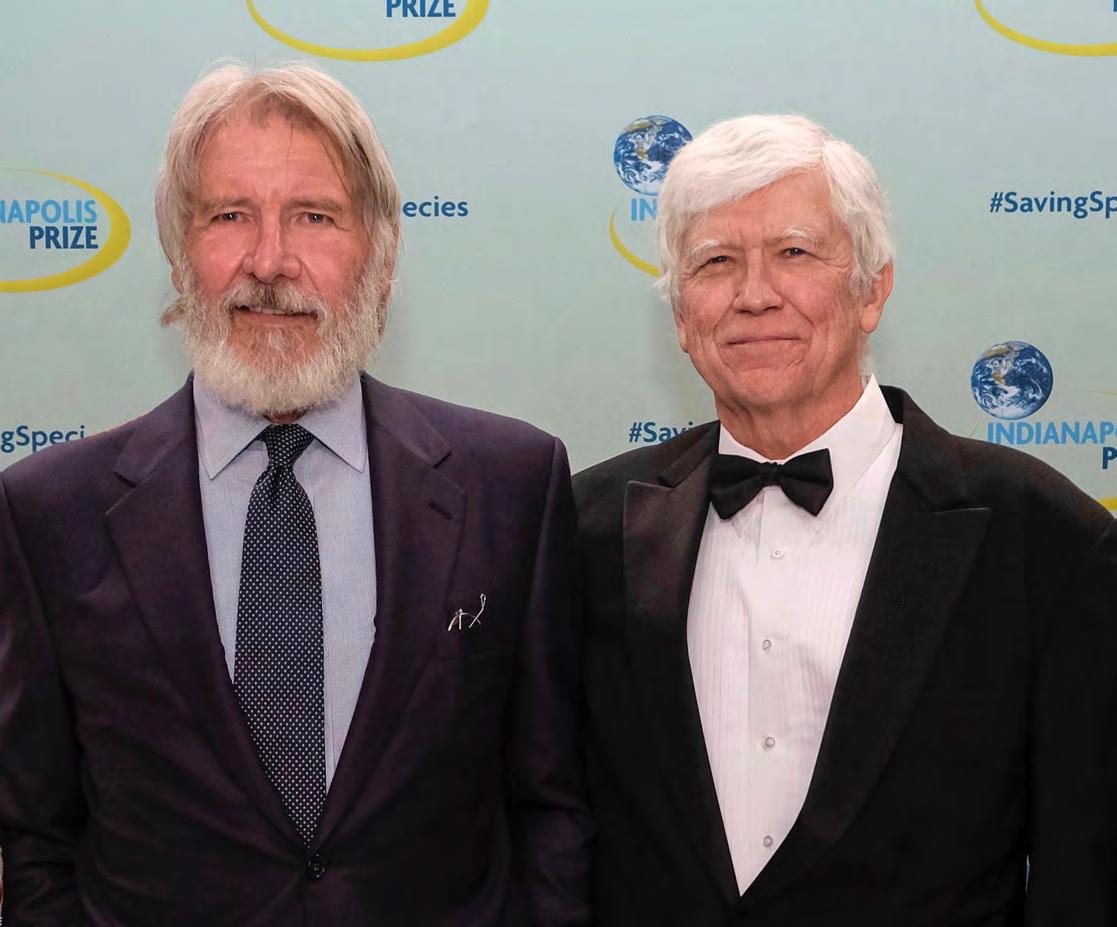
The Indianapolis Prize, the world’s most prestigious award for species conservation, and considered the “Nobel Prize for Conservation,” was awarded to our TSA Board of Directors member Russ Mittermeier at the Indianapolis Prize Gala in September 2018. The Prize is awarded biennially by the Indianapolis Zoo and the winner is presented with the pres-
tigious Lilly Medal and $250,000, the largest award given exclusively for conservation of endangered or threatened wildlife. Russ was selected as winner of the Indianapolis Prize from a pool of six finalists: Joel Berger, Dee Boersma, Sylvia Earle, Rodney Jackson, and Carl Safina. Also nominated for the Prize this year was our TSA President, Rick Hudson,
who would have been a deserving finalist.
Russ, considered to be the world’s preeminent primate conservationist, has also been instrumental in conservation initiatives focused on tortoises and freshwater turtles. He is best known for his leadership in promoting the concept of biodiversity hotspots—
critical conservation areas of high diversity, high endemism, and high threat levels. He has been responsible for the preservation of hundreds of species and millions of acres of critical habitat around the world. Most of this was accomplished during his 25 years as President of Conservation International and his 11 years at WWF-US prior to that. He now acts as Chief Conservation Officer for Global Wildlife Conservation.
Harrison Ford, who was also recognized for his bold, heroic devotion to conservation issues was among the honorees that night. After receiving his award, he made a heartfelt introduction of Russ to the audience:
“Protecting nature is first and foremost a moral imperative, yet...saving nature is really about saving ourselves. When I was asked to introduce Russ, I had just one question: What the hell for? If you work in conservation...you know Russ, because Russ has had the sort of career that everyone else just dreams about. He is, quite simply, a hero for nature. I’ve known Russ for a long time now, through our work together at Conservation International and beyond. Russ is someone who cares deeply, passionately, and intelligently for protecting nature. His heart and his mind have done more good for this planet than just about anyone. So all I really have to say is this: thank you, Russ, for your lifetime of service to nature. And congratulations on an award well earned.”
Russ then made an impassioned and warmly received award acceptance speech, thanking and honoring his family, friends, and colleagues for all the support, professional collaboration, and shared initiatives. He summarized his considerable accomplishments this way:
“Perhaps my greatest contribution has been an unwavering commitment to species conservation, using primates and turtles as models, and not losing focus of the fact that without species conservation all other efforts are doomed to failure. Species are
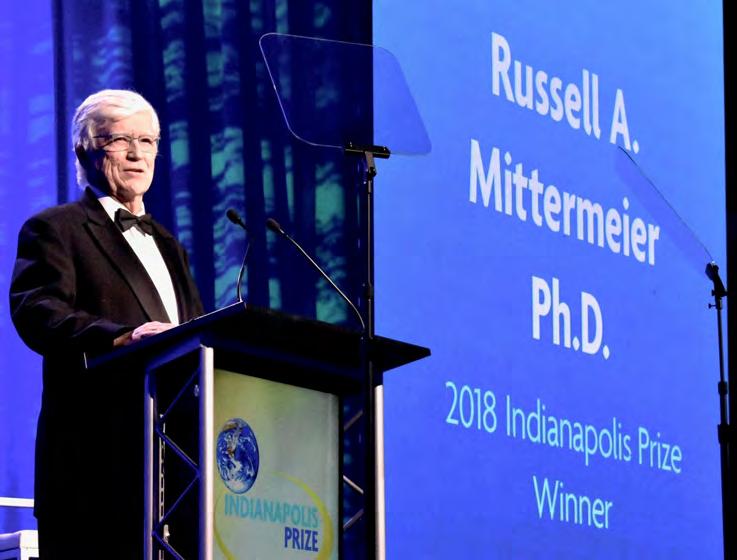
Mittermeier gives his acceptance speech to a crowd of 1200 attendees.
the basic building blocks of ecosystems, and ecosystems and the multitude of services that they provide are essential to our own survival as well as that of the rest of the natural world. And, it’s just not acceptable to sit idly by and let species go extinct, which is why I, and a growing number of my colleagues, have become strong advocates for the concept of zero extinctions.”
In closing, he said:
“Last but not least, I want to emphasize the need for optimism. I am an optimist by nature, always have been, and I simply don’t let myself get depressed or pessimistic. We will always have challenges, setbacks and obstacles, and we need to recognize that there are no final victories in conservation. Even when we think we have achieved great success, a political change or a natural disaster can bring us back to square one. It doesn’t matter. We just need to move forward, see our failures as learning experiences, maintain a positive can-do attitude, and engage at all levels of society to achieve ever greater support for conservation, and, if we can do that, I am convinced that we can succeed.”
Among the 1200 guests at the gala were Jim Breheny of WCS and TSA, myself, and TSA partners Eric Goode of Turtle Conservancy and Don Church and Wes Sechrest of Global Wildlife Conservation, as well as Russ’s whole family and countless friends and colleagues. Being personally called out and acknowledged in such a prominent venue felt very special for all of us. We all honored him and his considerable contributions to protected areas and primate and turtle conservation, and celebrated his passionate devotion to preserving our planet’s biodiversity. With Russ and other key leaders on our TSA Board, and through the efforts of our dedicated executives and staff, and also working together with other turtle conservation organizations, I am hopeful we will indeed succeed in our mission of achieving zero turtle extinctions. Thank you Russ and Harrison for inspiring all of us.
Contact: Anders G.J. Rhodin, Chelonian Research Foundation, 168 Goodrich St., Lunenburg, MA 01462 USA [rhodincrf@ aol.com]
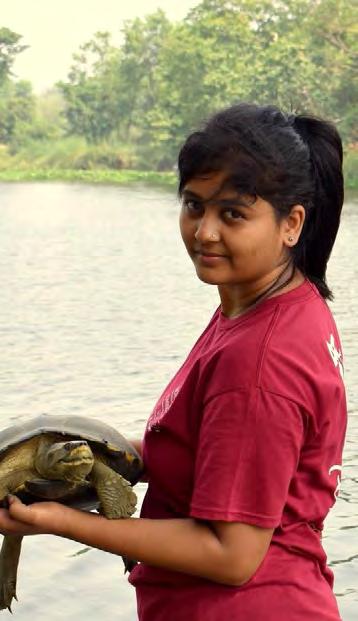
Hometown: Lucknow, Uttar Pradesh, India
Occupation: Field researcher, TSA-India
Can you tell our readers about the research you are performing in India?
My interest is in the nesting ecology of the Crowned River Turtle (Hardella thurjii) in the Ghaghara-Sarju River system, a component of the Gangetic River Basin, located in the Terai Arc Landscape. Crowned River Turtle is a really interesting species because currently no one understands the intricacies of their nesting behavior since, unlike other turtles, they don’t bury their nests on sandbanks, but rather are underwater nesters. My current PhD research focuses on elucidating facts about the population dynamics and reproductive aspects of this enigmatic species.
What is your most memorable experience with turtles in the field?
I was having terrible luck during a survey of the Gomti River in Lucknow in 2017. Braving 40°C (104°F) temperatures for two months, I’d only recorded two species so far. One day, while fishermen were hauling in their nets, I suddenly saw a large blackish-grey object followed by a flash of yellow; a female H. thurjii! I remember crying out loud and freaking out my boatman while we sailed towards them. I couldn’t believe that this species could still be found in such a polluted river! To add to my joy, in the very same net I also spotted a Peacock Softshell Turtle (Nilssonia hurum), previously believed to have been extirpated in this river. The memory of rediscovering the existence of this species in the Gomti River after so many years will always hold a special place in my heart.
You were recently awarded the John Thorbjarnarson Fellowship for Reptile Research from the Wildlife Conservation Society. How will you use this award for your research and conservation efforts?
I’m really grateful for this grant because it’s going to allow me to gather some really vital information about H. thurjii’s nesting ecology. This grant will help me to continue ongoing activities such as gathering population data and various reproductive aspects, as well as enabling me to perform radio telemetry utilizing selected females so as to better understand their nesting behavior. I hope to use this grant as a crucial stepping stone in developing standardized conservation protocols applicable across all species of Indian freshwater turtle.
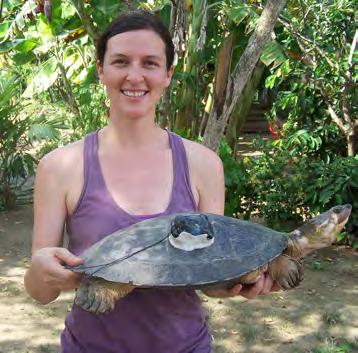
Hometown: Bogotá, Colombia
Occupation: Ph.D. student, Universidad de los Andes
How did you first come to be involved with the TSA?
I had the opportunity to spend several days on a boat on the Negro River with TSA President Rick Hudson. We took the boat to attend the South American IUCN Red Listing and Action Planning workshop, at the Reserva Biológica do Rio Trombetas, Pará, Brazil. I had days (or weeks?) to talk to Rick about a community-based conservation program that I started for the Magdalena River Turtle (Podocnemis lewyana) in the Sinú River, Colombia. We were trapped on that boat. Rick had no way out other than to agree to provide technical and financial support for the Sinú River program! That was the beginning of a long and lasting friendship and partnership.
Can you tell our readers about the research you are performing in Colombia?
I use genetic techniques to solve conservation problems. I am currently studying how forest loss has impacted the Dahl’s Toad-headed Turtle (Mesoclemmys dahli) population. We have found the metapopulation to be fragmented into several small subpopulations.
Individuals within the populations are adapting to deforested and artificial habitats, but are having trouble moving across the landscape. Thus, they cannot reproduce with individuals from other subpopulations, leading to homogeneity through inbreeding. We are designing a genetic rescue program that consists of moving individuals across the subpopulations to assist with gene dispersal, with the goal of restoring genetic diversity and inbreeding reduction. What challenges have you faced working in conservation and how did you overcome them?
Conservation is a long-term process that requires the involvement of local communities and other stakeholders, as well as financial sustainability. These two key elements are very difficult to achieve, especially in developing countries. We have worked to overcome this challenge by operating for over 10 years in the field, empowering locals by providing them with the necessary conservation skills to protect their natural resources, and to simultaneously find an alternative livelihood in conservation.

PAUL CALLE
Hometown: Danbury, CT
Occupation: Chief Veterinarian, Wildlife Conservation Society / Bronx Zoo.
Can you tell our readers about your work with the Wildlife
Conservation Society and where your passion has taken you across the globe?
I have worked at WCS since 1989 and serve as the WCS Vice President for Health Programs, Chief Veterinarian, and Director of the Zoological Health Program based at the Bronx Zoo. My responsibilities include managing the Clinical, Pathology, and Aquatic Health Departments for WCS’s Bronx, Central Park, Queens, and Prospect Park Zoos and the New York Aquarium, and shared oversight of the WCS Wildlife Health Program that focuses on health contributions to conservation through our field conservation projects. By far the best part of my job has been to work in the field with the same or related species that I have cared for in our zoos and aquarium, and turtle species have featured prominently in my travels. These have included support of Asian turtle conservation projects in China, Vietnam, Cambodia, and Myanmar; sea turtles in Belize; tortoises in Russia; and local Box Turtle (Terrapene carolina), Diamondback Terrapin (Malaclemys terrapin), and Bog Turtle (Glyptemys muhlenbergii) projects in New York and New Jersey.
Tell us about your most memorable experience providing veterinary care for chelonians?
Hands down my most memorable chelonian experiences have been with our work for the Yangtze Giant Softshell Turtle (Rafetus swinhoei) in China in conjunction with the TSA’s Gerald Kuchling, the Changsha and Suzhou Zoos, the China Zoo Association, San Diego Zoo Global, the Leibniz Institute for Zoo and Wildlife Research, and WCS China. My participation began in 2008 when I was the lead veterinarian during the transport of the last remaining female from the Changsha Zoo to the Suzhou Zoo, and has continued through four artificial insemination attempts between 2015 and 2017. The most stressful professional experience I have ever had was the first time I
sedated the male for electroejaculation and the female for artificial insemination. This meant anesthetizing half of the then known world’s population of the species, both of which were probably over 100 years old, and a species that probably had never been anesthetized before. Although we have not yet succeeded in producing any fertile eggs, we have not given up hope for the species! We continue to plan for improved and enhanced techniques for the next artificial insemination attempt.
You and WCS have become stalwart supporters of TSA’s efforts to rescue confiscated chelonians and have stepped up in major ways to respond. Tell us about why you feel that it’s important to contribute to these efforts?
Enactment of wildlife laws and regulations is a critical part of the conservation of threatened and endangered species, and enforcement of these laws results in live animal confiscations. If we do not support the care of these confiscated individuals, we undermine the ability of governments to enforce their wildlife protection laws. There are also significant welfare and humane considerations in most confiscations because the animals have seldom been held in adequate conditions before confiscation. Just because stoic, resilient turtles can survive those terrible conditions better than other species might, they nonetheless suffer and die. When confiscations are on the massive scale that we witnessed in the last few years for the Palawan Forest Turtle (Siebenrockiella leytensis) in the Philippines and Radiated Tortoises (Astrochelys radiata) in Madagascar, it’s all hands on deck to care for them. Although I did not directly assist with either of these confiscations, WCS and I fully supported our staff to play significant roles contributing to the care of these confiscated turtles. WCS and TSA have been great partners for turtle conservation, and I am proud to have played a small role in that partnership.
Jordan Gray
If a picture is worth a thousand words, then the metric for one’s first encounter with a turtle or tortoise must be priceless. For many of us, our first experience with a turtle occurred during our cognitive preoperational stage, where memory and imagination are initially developed. For others, years later. Despite one’s age, the fascination with these timeless creatures remains both inherent and apparent. As we say at the Turtle Survival Alliance, “Everyone has a turtle story.” At the TSA, we understand the fundamental value of that first encounter and aim to ignite a passion in others by creating that experience. We see it as an opportunity to not only share “our turtle story,” but provide the potential to be someone’s “first turtle story.” Through outreach events, fundraisers, group presentations, and school field trips, our staff and associates across the globe provide direct interaction with turtles and tortoises; bridging the gap through knowledge-sharing with those in our communities. From young children to adults, we strive to fulfill our duties as conservation warriors by recognizing the inquisitiveness and potential in everyone around us, and creating catalytic moments for those eager to learn. It takes a community to make chelonian conservation work!

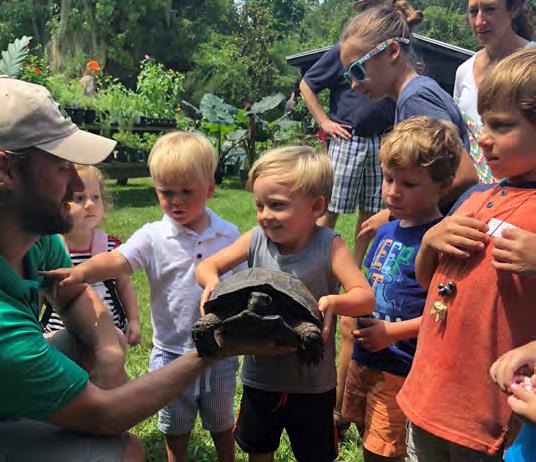
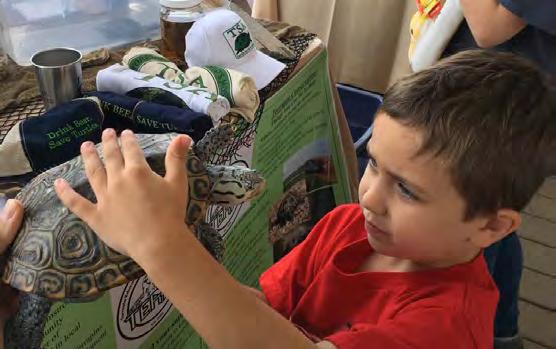

Jordan Gray
Multitudes of turtle and beer enthusiasts from Pennsylvania to Texas and Oklahoma to Carolina raised their pint glasses this year as they took part in Turtle Survival Alliance’s Drink Beer. Save Turtles® events. 2018 festivities were slated to begin the first week of January with “CoaSHELLa,” a partnership with Freehouse Brewery and the 701st Airlift Squadron “Turtles” out of Charleston Air Force Base. Unfortunately, a nor’easter brought a “bomb cyclone” to the region, blanketing normally balmy Charleston with snow and ice, effectively putting the event into brumation until a later date.
The warm weather of late spring, however, brought these fundraising, outreach, and awareness events into full activity. In Oklahoma, Stonecloud Brewing Co. and Oklahoma City Zoo and Botanical Gardens teamed up for World Turtle Day® in what would be Oklahoma’s first Drink Beer. Save Turtles.® event. Simultaneously, in Austin, Texas, our TSA-NAFTRG team, The County Line BBQ, and Hops & Grain Brewing partied together for their third time at “Turtlemania 3,” a World Turtle Day® event.
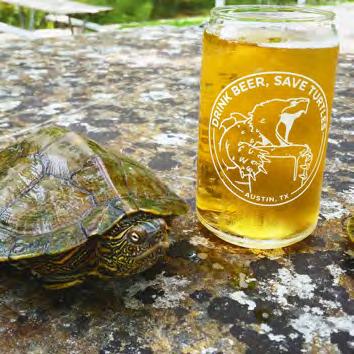
If there’s one thing turtle enthusiasts in western Pennsylvania can now count on, it’s an autumn Drink Beer. Save Turtles.® gathering at Spoonwood Brewing Co. in Pittsburgh. This year’s “Turtle Waste of Time,” was another huge success in continuing the collaboration with our partners at theTurtleRoom. The 2018 season fittingly concluded in late October, just minutes away from our Charleston headquarters, at Holy City Brewing—despite Hurricane Florence’s attempt to wash it away. Only weeks after her turbulence postponed this event, hundreds of participants ushered in cool autumn weather with “The Bitter Box Turtle,” an English style ESB.
Riding on the success of these events, the TSA and collaborators around the country are already planning events for next year in seasoned locations and and new ones such as, Indiana, New Jersey, and Columbia, South Carolina. Want to get involved? Start planning a Drink Beer. Save Turtles.® event with the TSA and your local brewery today!
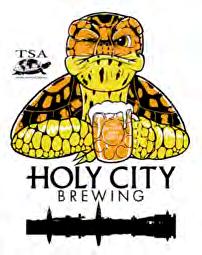

Holy City Brewing:
“The Bitter Box Turtle” 5.8% ESB. Malty ale with a little bitterness.
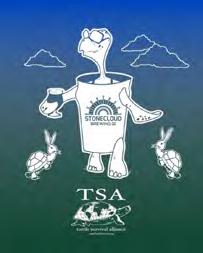
Spoonwood Brewing:
“A Turtle Waste of Time”4.4 % German Black Lager
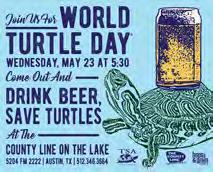
Stonecloud Brewing:
“Turtle Turtlehead Stout” 11% Coffee imperial stout featuring chocolate, caramel, and roasted pecans.
Hops & Grain Brewing:
“River Beer” 5.2% Premium American Lager with premium German malt, hops, and lager yeast.
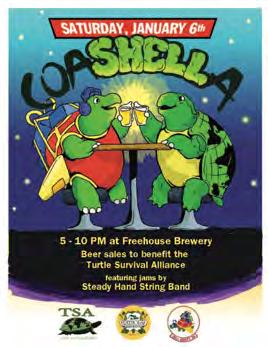
Freehouse Brewery: Numerous craft brews available on tap.
Interested in hosting a “Drink Beer, Save Turtles” event at your favorite local bar, taproom, or brewery?
Please contact Jordan Gray, Communications and Outreach Coordinator, at jgray@turtlesurvival.org
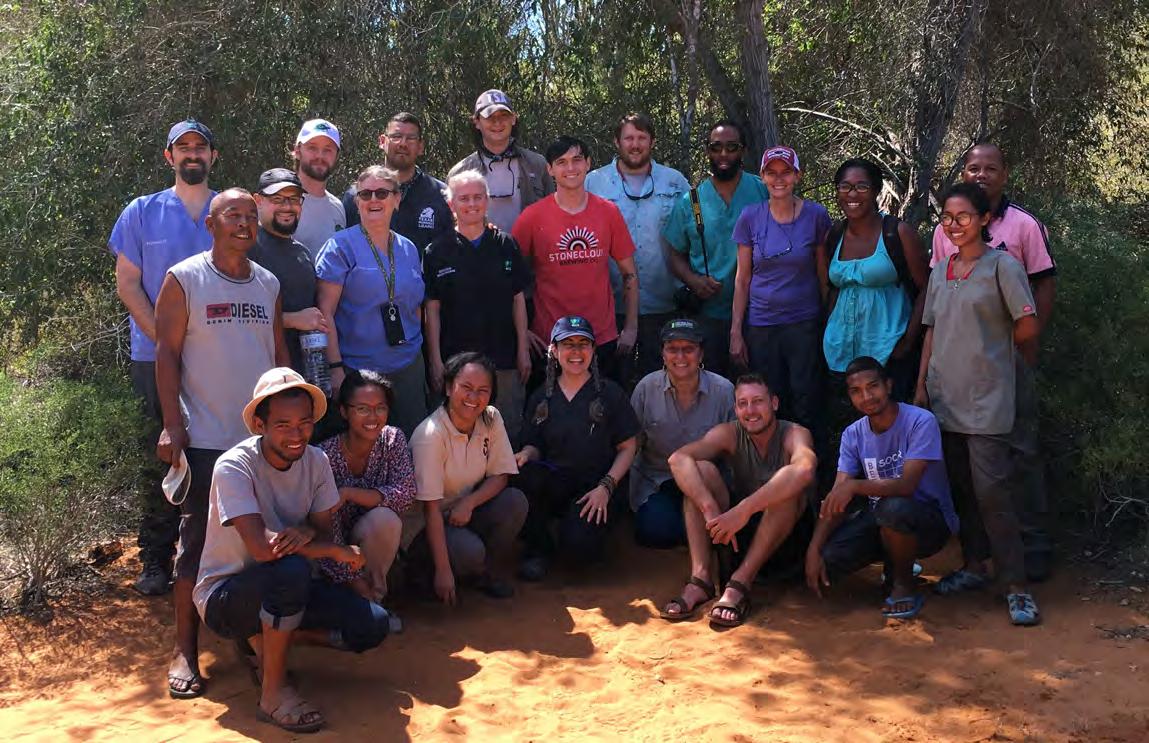
The TSA works with more than 100 (approximately one-third) of the tortoise and freshwater turtle species around the globe.
The TSA directly impacts 20 of the World’s Top 25 Most Endangered Tortoises and Freshwater Turtles.
This e ort is supported by a global network of conservationists, field biologists, animal care technicians, veterinarians, governmental and non-governmental organizations, private stakeholders, citizen scientists, and YOU, our loyal supporter.
As a TSA member, you will receive our annual publication, bi-weekly e-newsletter, discounted conference registration, opportunities with the TSA’s North American Freshwater Turtle Research Group, and other exclusive benefits throughout the year. TSA members also enjoy a 10% discount every day on most items in the TSA’s online store. Most importantly, your support directly moves us closer to our goal of “zero turtle extinctions!”
Joining has never been easier as we have five levels of membership (figures represent annual dues):
• Individual ($50)
• Student ($25)
• Senior ($25)
• North American Freshwater Turtle Research Group ($30)
• Organizational ($400)
*If you would like to make your membership “green” we also have membership levels that will not receive a hard copy of the TSA’s annual publication by mail, but instead an electronic version!
Become a TSA member at www.turtlesurvival.org.
Once you’re a member, log into your membership account and select “Member Benefits” from the dropdown menu to learn about additional o ers and rewards throughout the year.
Thank you for your support!

1. Our "Zero Turtle Extinctions Legacy Circle" is an honorary association that recognizes individuals whose planned gift has been received or been established to provide a future benefit to the Turtle Survival Alliance.
Provide for the future needs of our mission by naming the Turtle Survival Alliance as a beneficiary in your estate plans. A gift to the "Zero Turtle Extinctions Legacy Circle" will insure that the Turtle Survival Alliance continues its mission of zero turtle extinctions for years to come. Thank you for taking the time to explore the benefits of gift planning, including life income gifts, gift annuities, mutual funds, real estate, life insurance, and other plans.
2. Support the Turtle Survival Alliance by donating to the TSA Stewardship Fund. Your gift will have a significant impact on the future by helping to provide an ongoing income.
For additional information on the "Zero Turtle Extinctions Legacy Circle" or planned giving options, please contact Rick Hudson, President, at rhudson@turtlesurvival.org
1. Make a Donation Your support moves us closer to a goal of zero turtle extinctions
2. Join the TSA Become a member of the TSA or buy a gift membership for a friend.
3. Purchase Equipment Check out the TSA’s Wish List on Amazon.com to purchase equipment and supplies that are needed by our sta at the Turtle Survival Center and in the field.
4. Shop at turtlesurvival.org Visit the TSA’s online store to purchase t-shirts, art, publications, and other merchandise to support conservation projects around the world.
5. Volunteer Visit the TSA website for volunteer opportunities.
6. Support the TSA at No Extra Cost to You There are several programs available through which you can support the TSA’s mission by doing what you do every day!
• Amazon.com – Access amazon.com via the TSA link (http://bit.ly/tsa_amazon) and a portion of your purchase will be donated to turtle conservation.
• eBay – The TSA is part of the eBay Giving Works program. So, you can support our mission when you buy and sell on eBay.
• Good Search – What if the TSA earned a donation every time you searched the Internet? Or how about if a percentage of every purchase you made online went to support our cause? It can, with Good Search. www.goodsearch.com/nonprofit/turtle-survival-alliance
There are many ways that YOU can contribute to turtle conservation and support the TSA’s mission of zero turtle extinctions. Visit turtlesurvival.org.
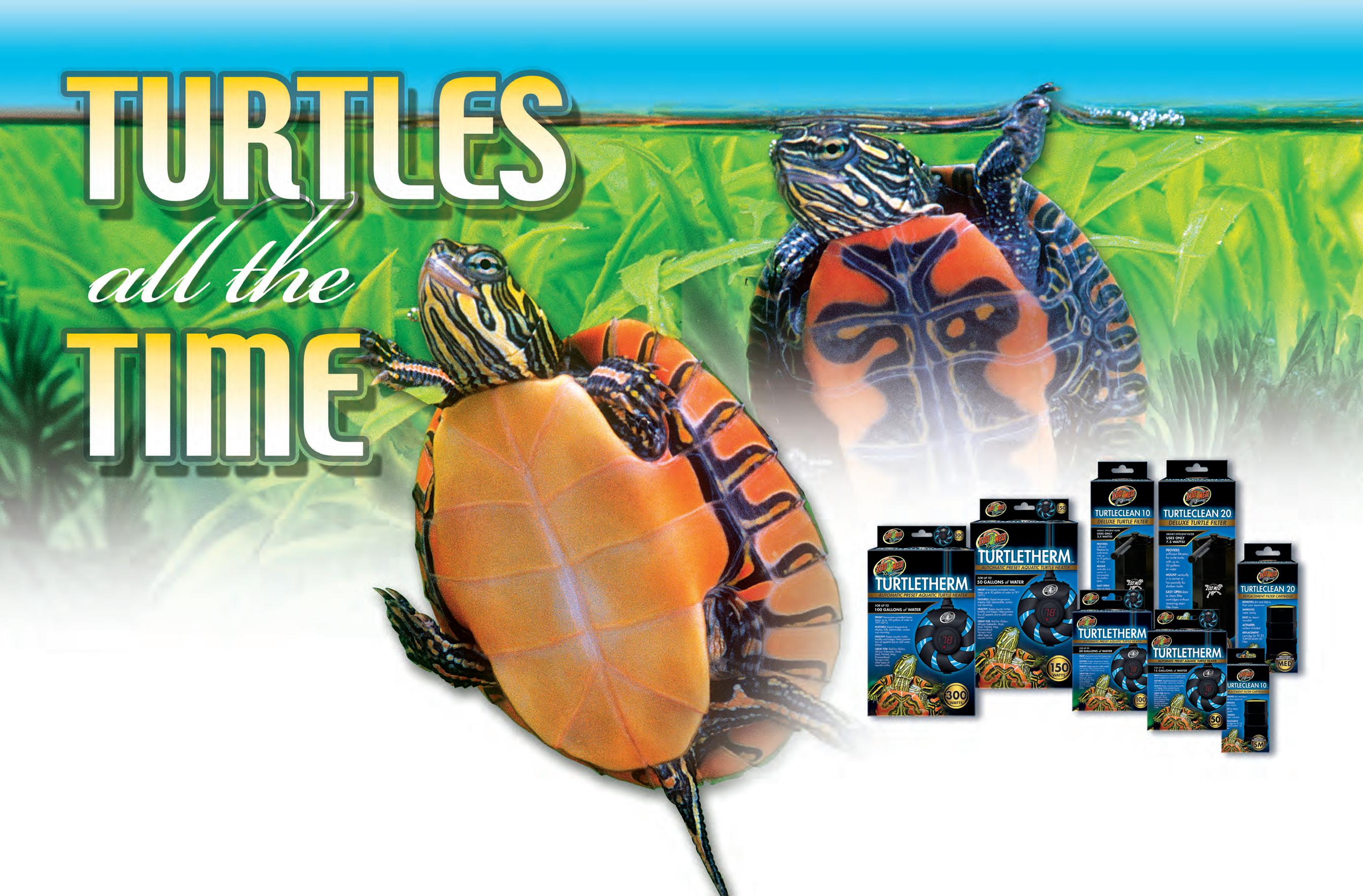


Founded in June 2011, theTurtleRoom has grown and evolved over the last seven years into the formalized organization we are today; now with a mission to advance survival of the world’s turtles and tortoises through collaborative education, conservation, and research programs. When we created this mission statement, our goal was to not only convey our purpose, but tell people who we are as an organization.
Collaboration has been a significant piece of theTurtleRoom’s identity since our founding. Our origin story is rooted in an alliance between several conservationminded private keepers coming together under a collective identity to work together towards common goals. Only through continued collaboration has theTurtleRoom been able to grow to its current state. As we evolved, it was important that we maintained collaboration as a central piece of our brand and this identity is visible in each branch of our work.
The most diverse group of programs at theTurtleRoom are those we categorize as educational, including outreach. We have leveraged the internet to perform outreach and education through social media, to build a website containing articles and educational materials about husbandry and natural history, and to develop applications like Digital Chelonian Log and the “Native Species Maps” on theTurtleRoom.com. However, in-person connections are still imperative to outreach and education, so we also make presentations in classrooms, at zoos, and in other public venues.
TheTurtleRoom’s conservation and research programs are divided into two areas. The
Steve Enders and Anthony Pierlioni
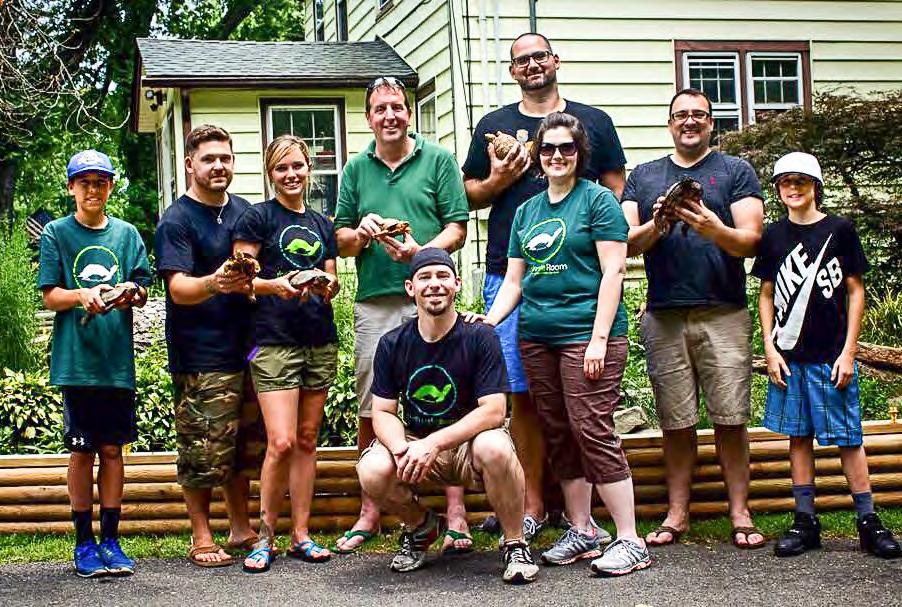
first is our ex situ work, focused on developing assurance colonies, many of which are in partnership with the Turtle Survival Alliance (TSA) and/or Association of Zoos & Aquariums. In addition to maintaining colonies of endangered and critically endangered species, we also believe there is great value to conservation and research by doing the same for species currently considered common. It is never too early to start conserving a species.
TheTurtleRoom also manages in situ programs. The first is in partnership with TSA’s North American Freshwater Turtle Research Group (TSA-NAFTRG), monitoring a population of North American Wood Turtles (Glyptemys insculpta) in Pennsylvania. We are also collaborating with Turtle Conservancy on conserving a local population of Diamondback Terrapins (Malaclemys
terrapin terrapin) in New Jersey, whereby nests subject to high levels of depredation are located, excavated, and incubated artificially, with hatchlings returned to the wild after a few weeks in captivity. During both of these projects we collect data with future research initiatives in mind. Additionally, theTurtleRoom staff members assist on data-collection and analysis with other TSA-NAFTRG projects.
Moving forward, theTurtleRoom will continue to advance the cause of chelonians as we build new education, conservation, and research programs with our existing partners and develop new partnerships.
Contact: Steve Enders and Anthony Pierlioni, theTurtleRoom, PO Box 521, Lititz, PA, USA 17543 [steve@theturtleroom. com; anthony@theturtleroom.com]
We wish to acknowledge the individuals and organizations who donated to support the Turtle Survival Alliance between 1 November 2016 and 31 October 2017.
$100,000+
Anonymous
Fagus Foundation
Timothy Gregory/Gregory Family
Charitable Fund
Alan & Patricia Koval Foundation
Nature’s Own/Roy Young
$50,000-99,999
Fondation Segré
Utah’s Hogle Zoo
$25,000-49,999
Columbus Zoo and Aquarium
Disney Wildlife Conservation Fund
The Arthur L and Elaine V Johnson Foundation
Oklahoma City Zoo and Botanical Garden
San Diego Zoo Global
$10,000-24,999
Aktionsgemeinschaft Artenschutz (AGA) e.V.
Deborah Behler
California Turtle and Tortoise Club
Dallas Zoo
The Delta Foundation
Dennler Family Fund of the Toledo Community Foundation, Inc. / Bill Dennler
Detroit Zoo
Fort Worth Zoo
Mohamed bin Zayed Species
Conservation Fund
Ocean Park Conservation Foundation
People’s Trust for Endangered Species
Riverbanks Zoo
Wildlife Conservation Society / Bronx Zoo
Zoo and Aquarium Association (ZAA)
Zoo Med Laboratories, Inc.
$5,000-9,999
Jay and Jane Allen
Association of Zoo Veterinary Technicians
Auckland Zoo
Barbara Brewster Bonner
Charitable Fund
Brian Bolton
Margaret Cochrane
Cleveland Metroparks Zoo
Dennis Coules
Desert Tortoise Council
Douglas and Patricia McCurdy Foundation
Denver Zoo
The Frankel Family Foundation
Global Wildlife Conservation
Owen Griffiths / Francoise Leguat Ltd.
William Holmstrom
Houston Zoo
Jacksonville Zoo and Gardens
Andrew M. Jacobson In Memory of Ellen Wendy Weiss
Jill M. Jollay Charitable Foundation
Robert & Denise Krause
Little Rock Zoo
The Cynthia and George Mitchell Foundation
Nashville Zoo
Ed Neil Charitable Fund
Ty Park
Phoenix Zoo / Arizona Center for Nature Conservation
Point Defiance Zoo and Aquarium
Rufford Small Grants Program
St. Louis Zoo
The Tides Foundation
Texas Parks and Wildlife
Turtle Conservancy
Turtle Conservation Fund
Zoo Knoxville
$1,000-4,999
Beverly Allison Anonymous
AAZK – Memphis Chapter
AAZK – Puget Sound Chapter
AAZK - Roger Williams Park Zoo
Audubon Nature Institute / Audubon Zoo
Baton Rouge Zoo
Berkeley Electric Trust
Ellen and Guillermo Bernal Family Foundation
Bonfire
James Breheny
Brevard Zoo
British Chelonia Group
California Academy of Sciences
Chelonian Research Foundation / Anders Rhodin
Cincinnati Zoo and Botanical Garden
Dallas World Aquarium
Robin De Bled
Dickerson Park Zoo
Downtown Community Television Center
El Paso Zoological Society
Susie Ellis
Christian Fischer
Fresno Chaffee Zoo
Friends of Wekiva River, Inc.
Fundacja Zoo Wrocław DODO
Elizabeth Glassco
Global Wildlife Trust, Inc.
Greensboro Science Center
Jeffrey Harris
Shawn Ho
Honolulu Zoo
John Ball Zoo
John Iverson
Kadoorie Farm & Botanic Garden
Kansas City Zoo
Nancy Karraker
Lombardino Family Fund
Los Angeles Zoo
Lowry Park Zoo
Marin Community Foundation-Sundial Fund
Brandon Martin
The Maryland Zoo in Baltimore
The Merck Foundation c/o Cybergrants, Inc.
George Meyer
Mimosa Primary School
John D. Mitchell
Moody Gardens, Inc.
In a modern log cabin style studio nestled in the woods behind his home outside of New Ipswich, New Hampshire, Matt Patterson brings the creatures of his native New England to life on canvas. An acclaimed artist, Patterson’s vivid portraits regularly feature his greatest love: reptiles and amphibians—in particular, turtles and tortoises. As far back as Matt can remember, he has always had a love for these beautiful and stoic animals. Through Stoneridge Art Studios, his goal is to highlight and develop an appreciation for reptiles and amphibians with his work. Inspired and empowered by the phrase “education leads to conservation,” Patterson is a member of the Artist's for Conservation, a non-profit group that celebrates nature and is committed to supporting wildlife and habitat conservation through art.
Patterson created a limited edition Burmese Star Tortoise (Geochelone platynota) print for the Turtle Survival Alliance which remains available at www.turtlesurvival.org for purchase. For the past two years, Matt has also attended the TSA/IUCN-TFTSG’s Annual Symposium, donating original paintings for its live auction in order to help raise money for the organization's important work. To shop more artwork created by Patterson at his Stoneridge Art Studios, visit www.mpattersonart.com.
Tom Motlow
Museum of Life and Science
Naples Zoo at Caribbean Gardens
Anthony Nelson
New Mexico BioPark Society
North Carolina Zoo
Ocean Park Conservation Fund
Ocean Wise Conservation Association
Omaha’s Henry Doorly Zoo
Pro Wildlife
Sacramento Zoo
Saint Croix BiodiversityParc animalier de Sainte-Croix
Stuart Salenger Foundation, Inc.
San Antonio Zoo
Walter Sedgwick
Sedgwick County Zoo
Seneca Park Zoo Society
Frank and Kate Slavens
Spoonwood Brewing LLC
StarBorn Reptiles
Brett & Nancy Stearns
Tennessee Aquarium
Tulsa Zoo
Turtle and Tortoise Preservation Group
Virginia Aquarium & Marine
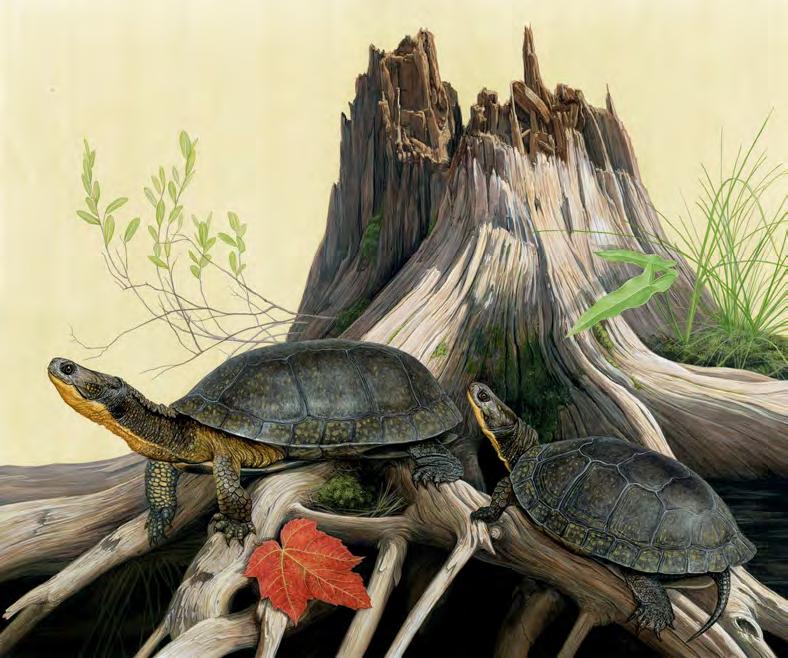
Science Center
Bruce Weber
Wildlife World Zoo & Aquarium
Woodland Park Zoo
Diane Yoshimi
Zoo Miami
Adelina Huamani
Adriana Nielsen
Andrew Haas
Angkor Centre for Conservation of Biodiversity
Anna Heckman
AppRiver
Association of Zoological Veterinary Technicians
Bonnie Raphael
Brenda Linneer
Bruce Wiessgold
Carol McFall
Christel Griffioen
Cincinnati Zoo
Cindy Stadler
Columbus Zoo and Aquarium
County Line BBQ
Dallas World Aquarium
Dallas Zoo
Denver Zoo
Deutsche Gesellschaft für Internationale Zusammenarbeit (GIZ) GmbH
Diana Soteropoulos
Doris Dimmitt
Durrell Wildlife Conservation Trust
El Paso Zoo
Florida Aquarium
Fort Worth Zoo
Frank and Martia Bender
Georgia Aquarium
Great Plains Zoo
Holy City Brewing
Hops & Grain Brewing
Indianapolis Zoo
James (Beau) Bradley
Jan Cadlini
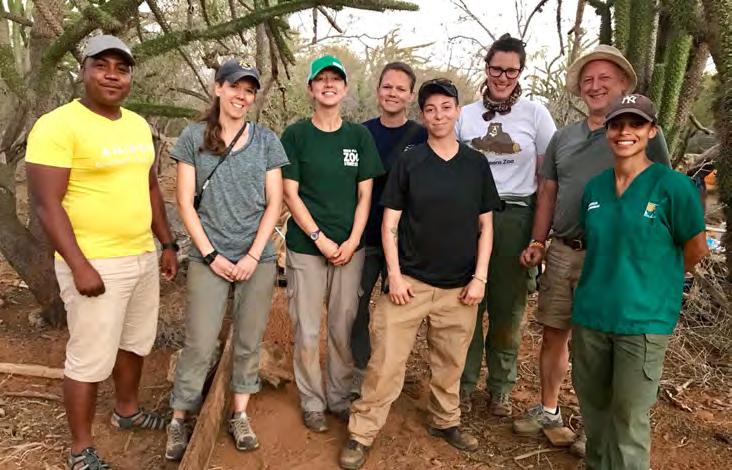
Jay Allen
John Griffioen
John Wilen
Julie McKenzie
Kings Landing
Kyle Loftus
Laura Mustee
Laurie Goldstein
LimeHouse Produce
Lisa Skibsted
Louisiana State University
Mark Grandall
Mark Muhich
Mepkin Abbey
Michael Greene
Michael Skibsted
Mike Penko
New England Aquarium
Nick Badham
North Carolina Zoo
Oklahoma City Zoo & Botanical Gardens
Oregon Zoo
Ric Pusey
Ron and Iris Neal
San Diego Zoo Global
Shannon Simar
Shedd Aquarium
SOPTOM
South Carolina Aquarium
Stephanie Shaw
Stonecloud Brewing Co.
Stoneridge Art Studios/Matt Patterson
Tennessee Aquarium
Todd Pickler
Turtle and Tortoise Preservation Group
Turtle Eye Productions/Mark Muhich
Utah’s Hogle Zoo
Wayne Osborne
Wekiva Island
White Oak’s Conservation Foundation
Wildlife Conservation Society
Willow Melamet
WREN Consulting
WWF Madagascar
Zoo Atlanta
Zoo Knoxville
Zoo Med Laboratories
While space limits us from listing all of our donors, we are grateful for every gift that makes our work possible. We gratefully acknowledge our donors for their support and generosity.
Every effort has been made to accurately recognize our donors. If any errors have occurred, please accept our sincere apology and contact our office at (843) 724-9763 with any corrections.
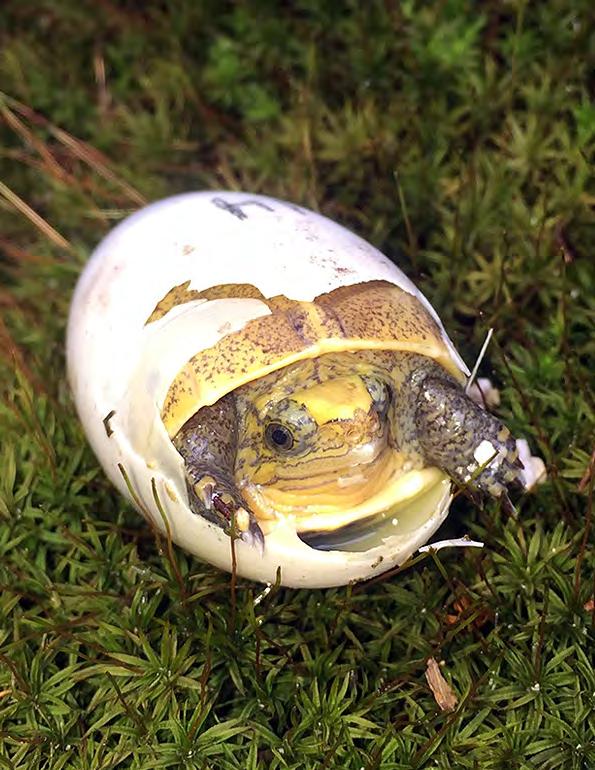
Southern Vietnam Box Turtle (Cuora picturata). The Turtle Survival Center in Cross, South Carolina experienced a record-breaking year for the reproduction of this critically endangered species. With continued illegal commercial collection and populations dwindling rapidly from the wild in their native Vietnam, the success of ex situ conservation breeding programs and assurance colonies are likely to be necessary for its survival.
PHOTO CREDIT: CRIS HAGEN